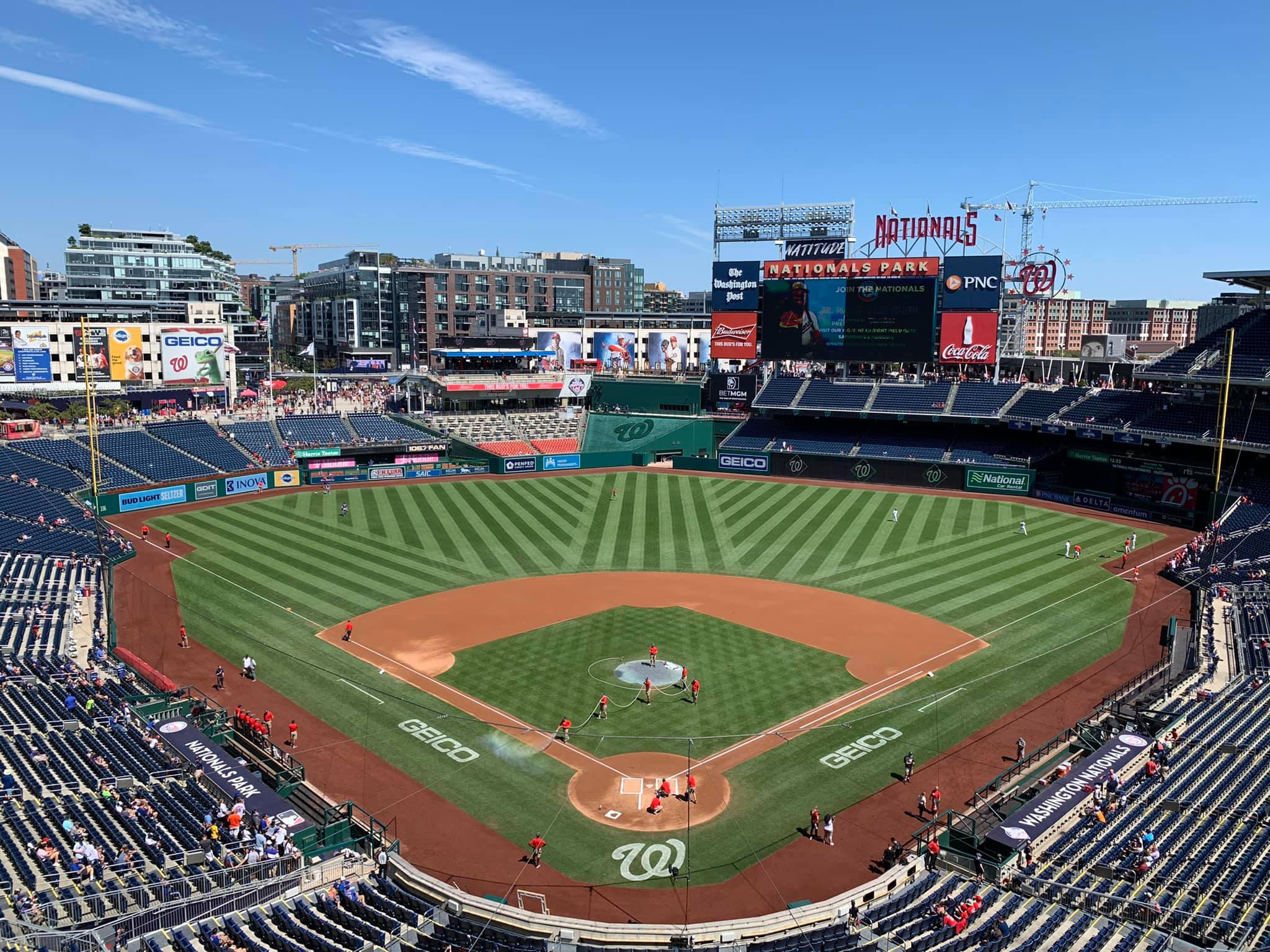
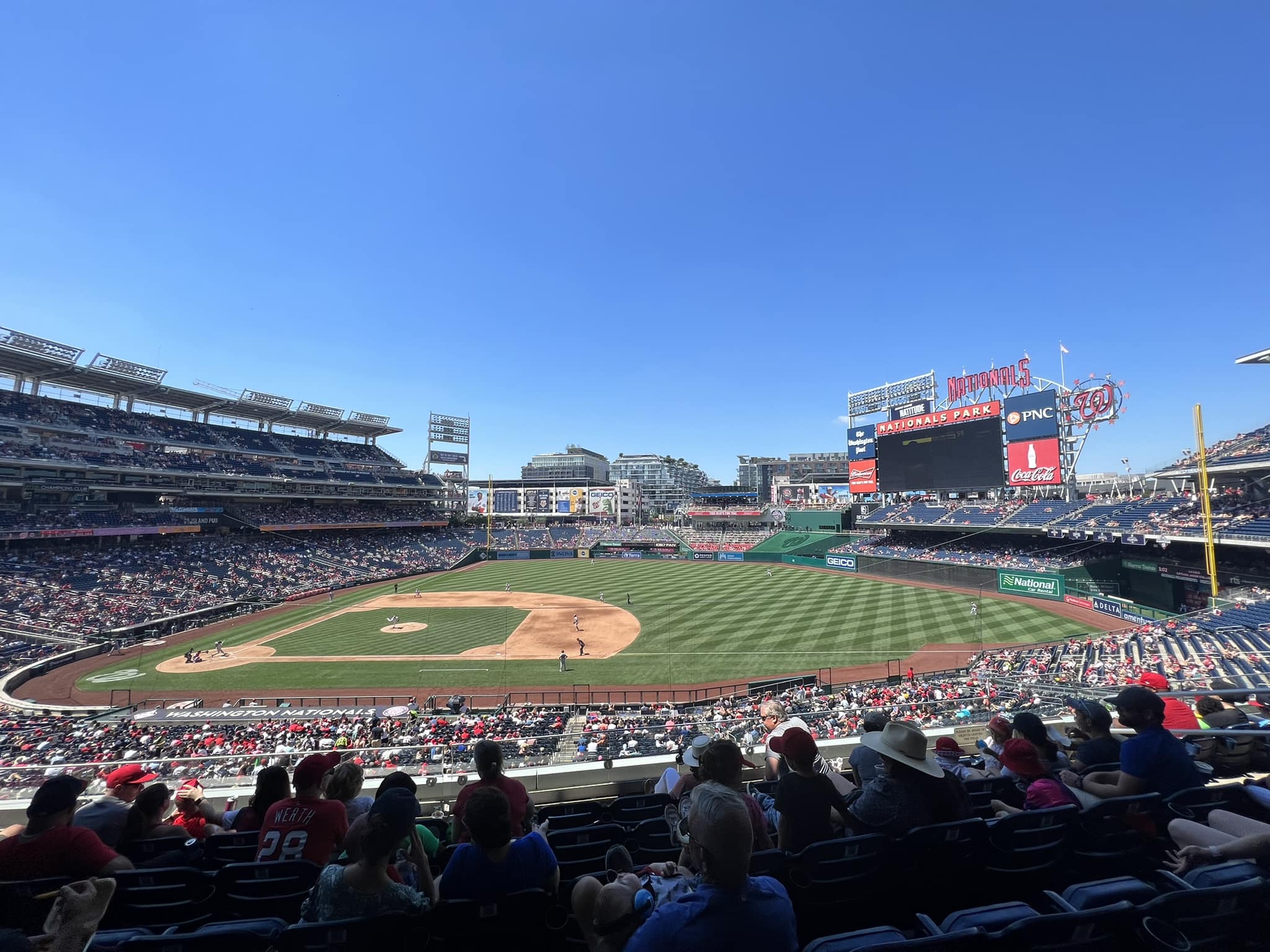


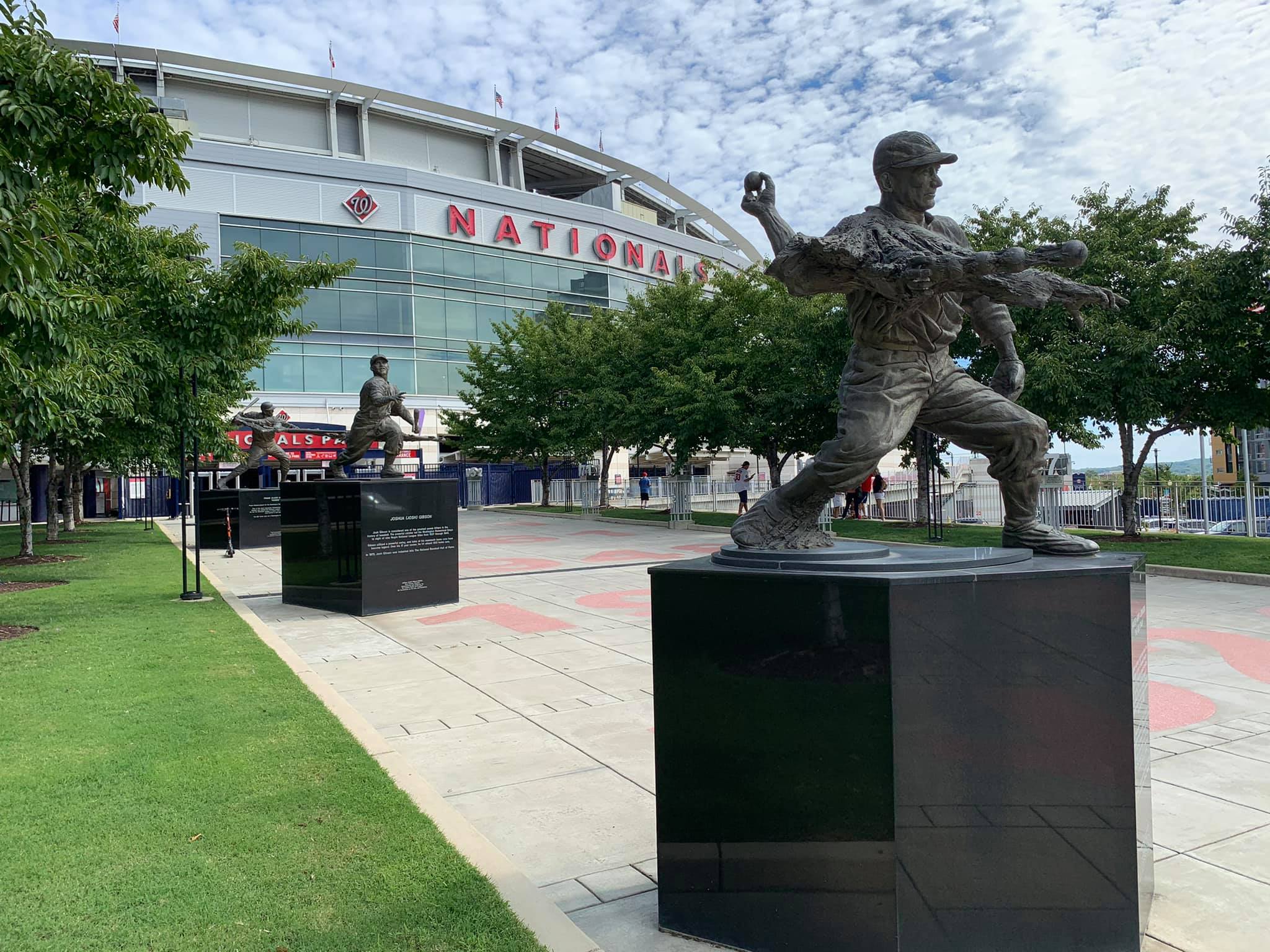
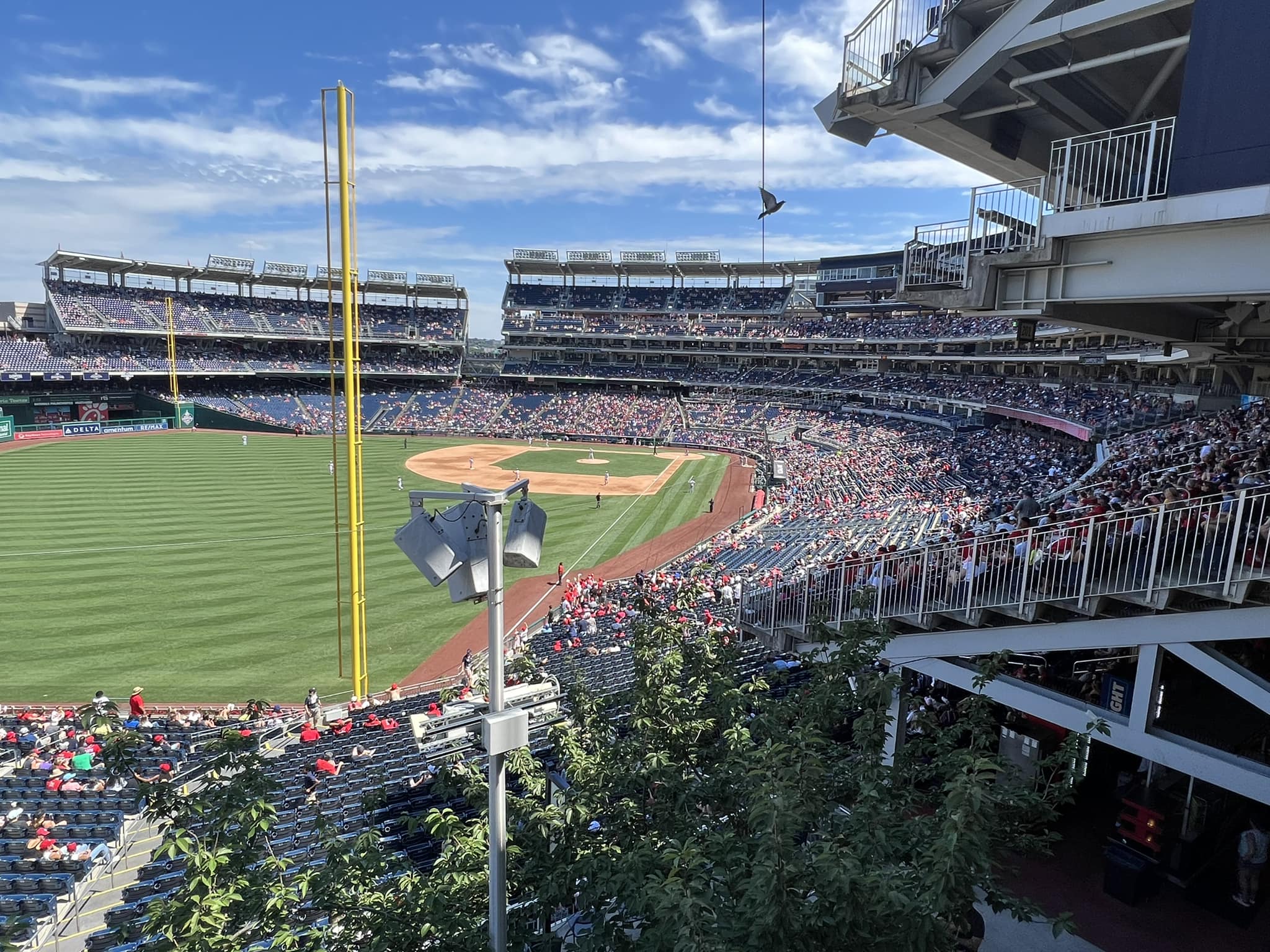
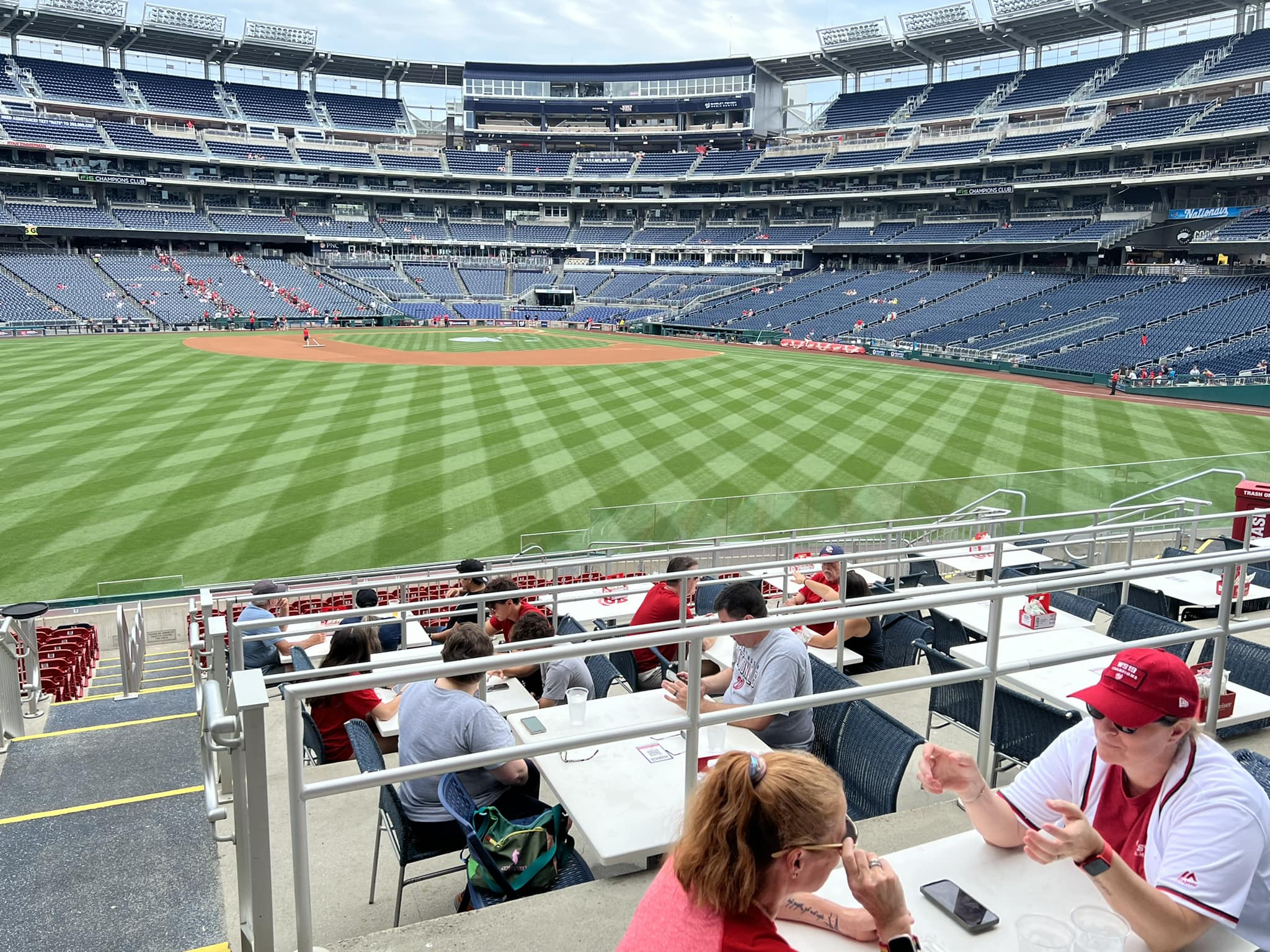
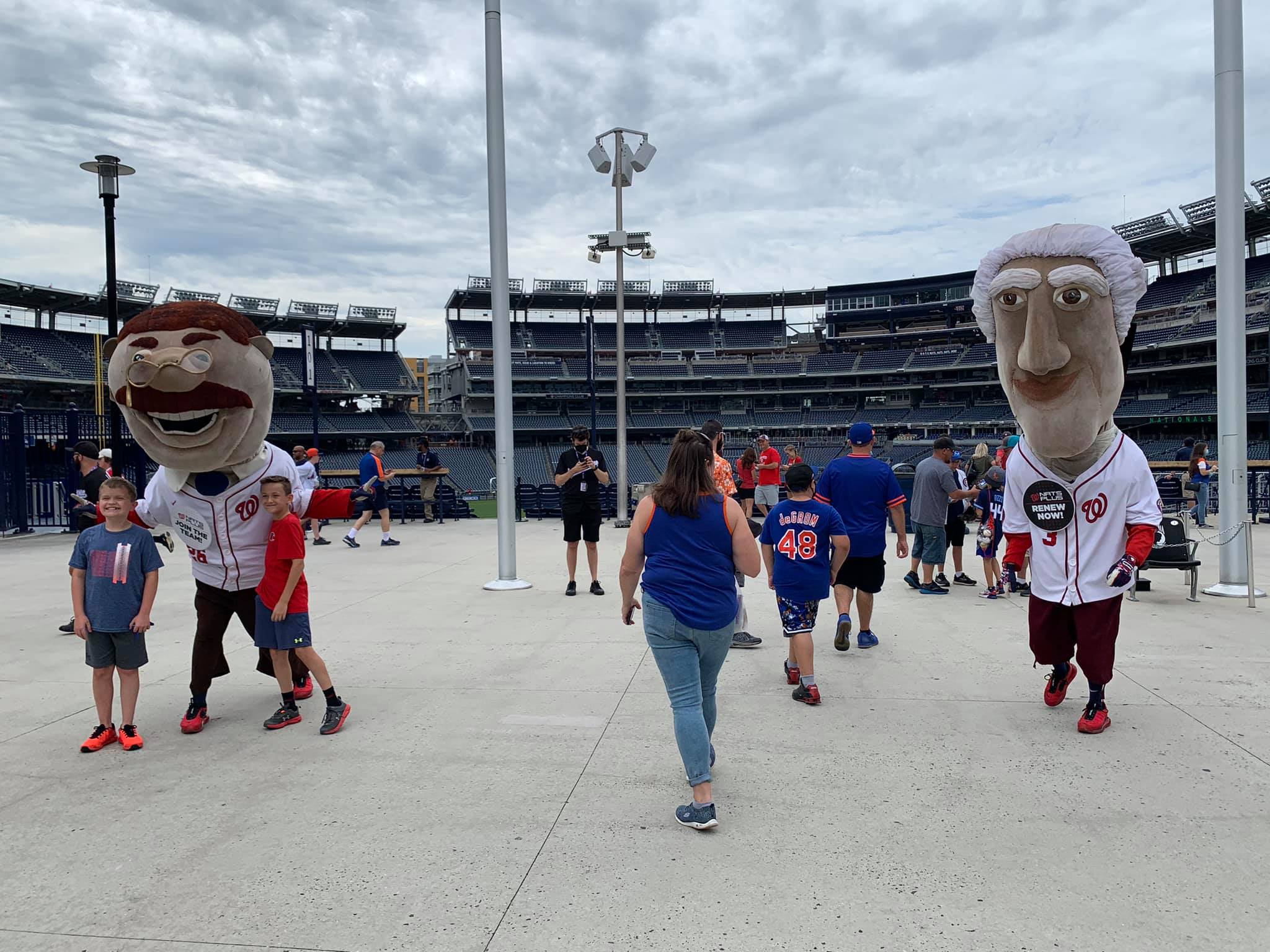

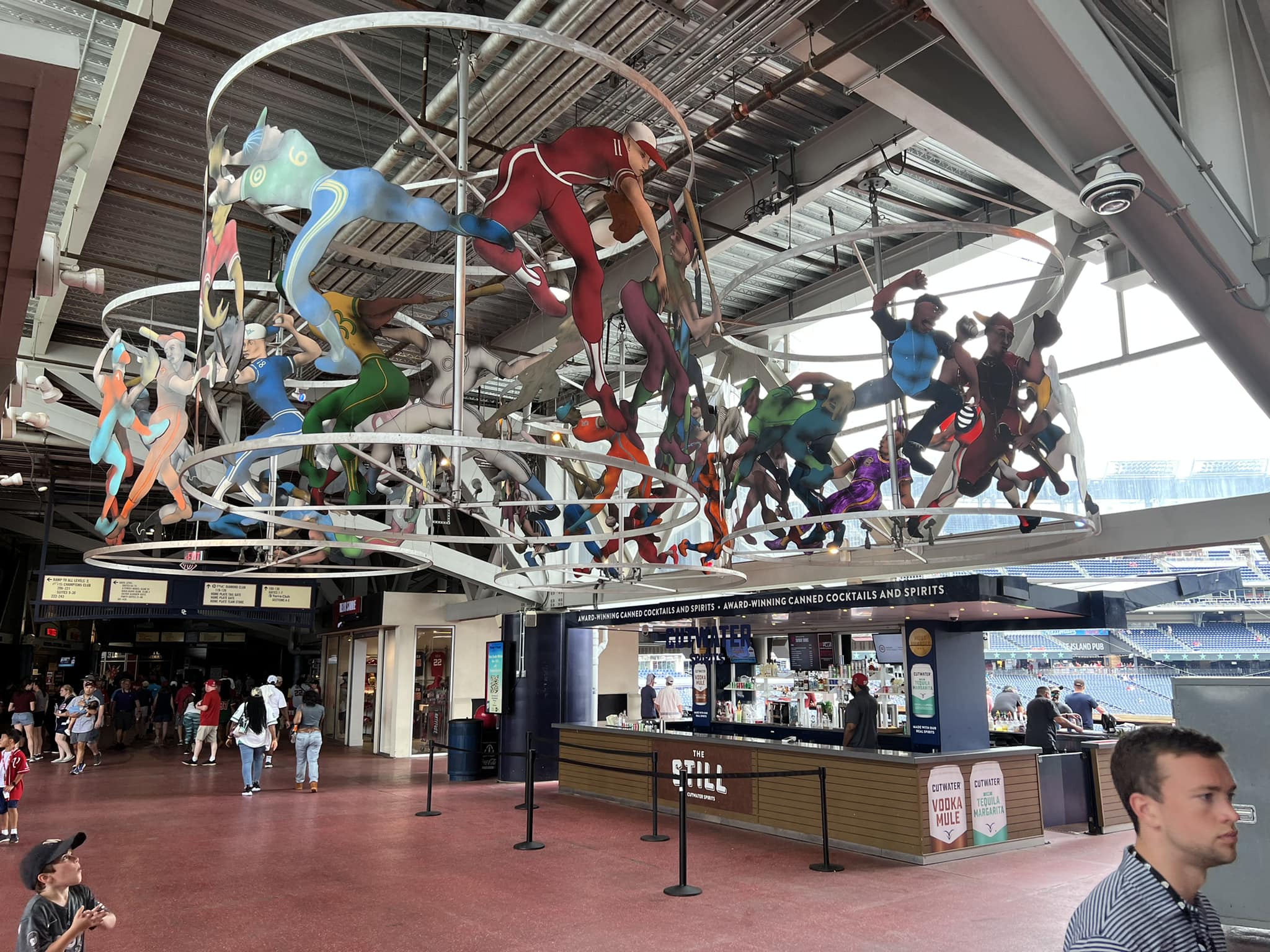

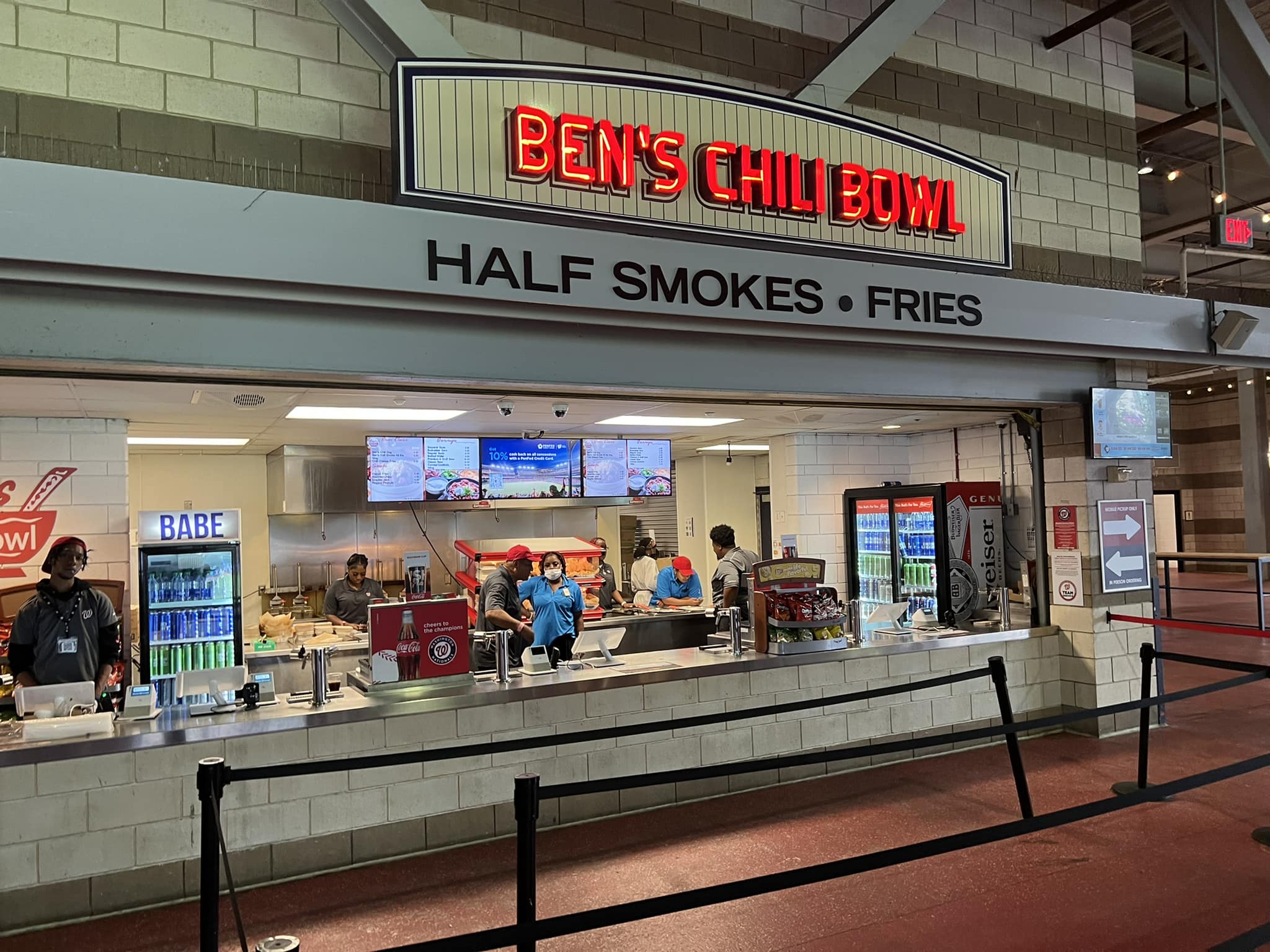
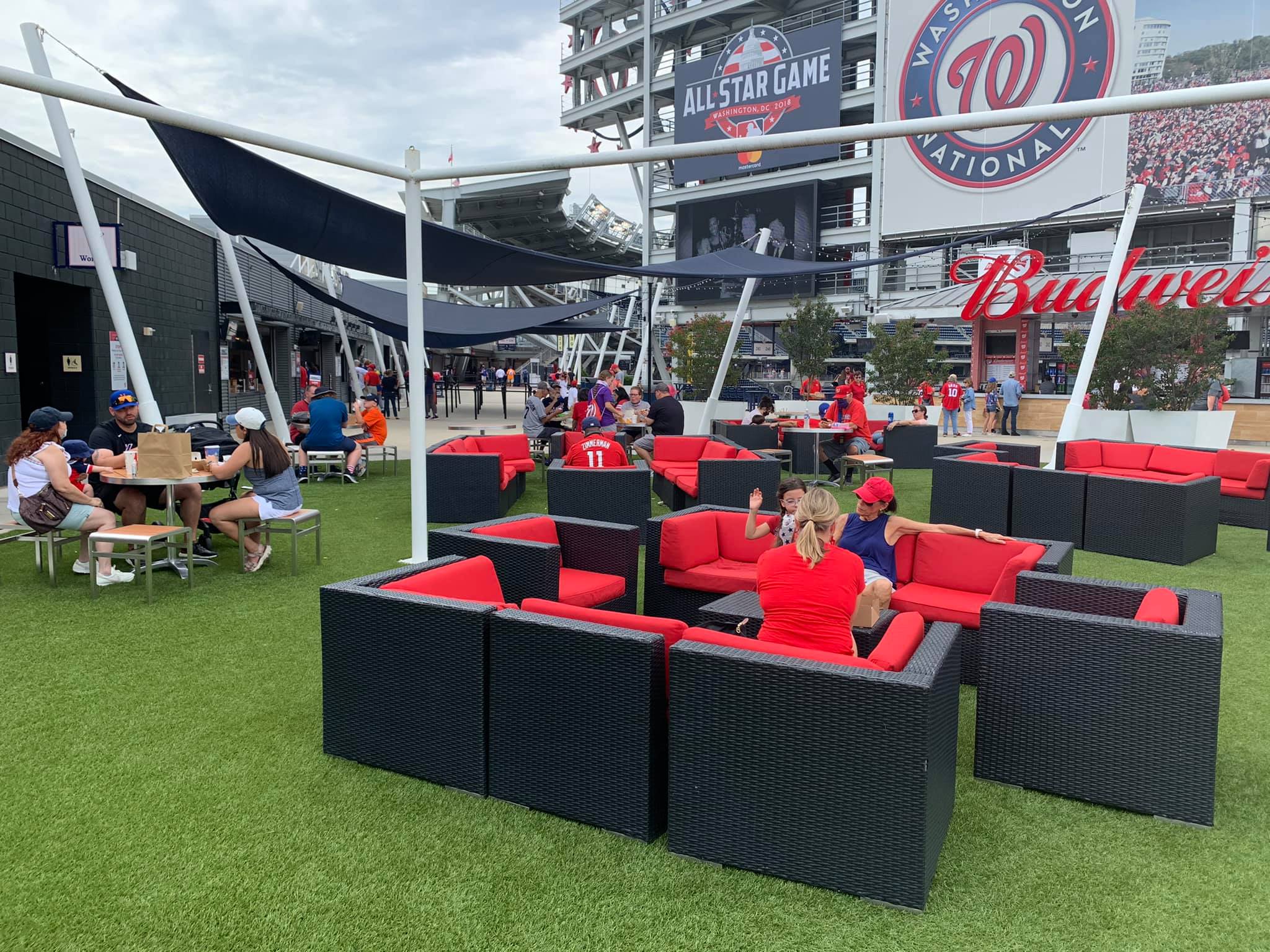

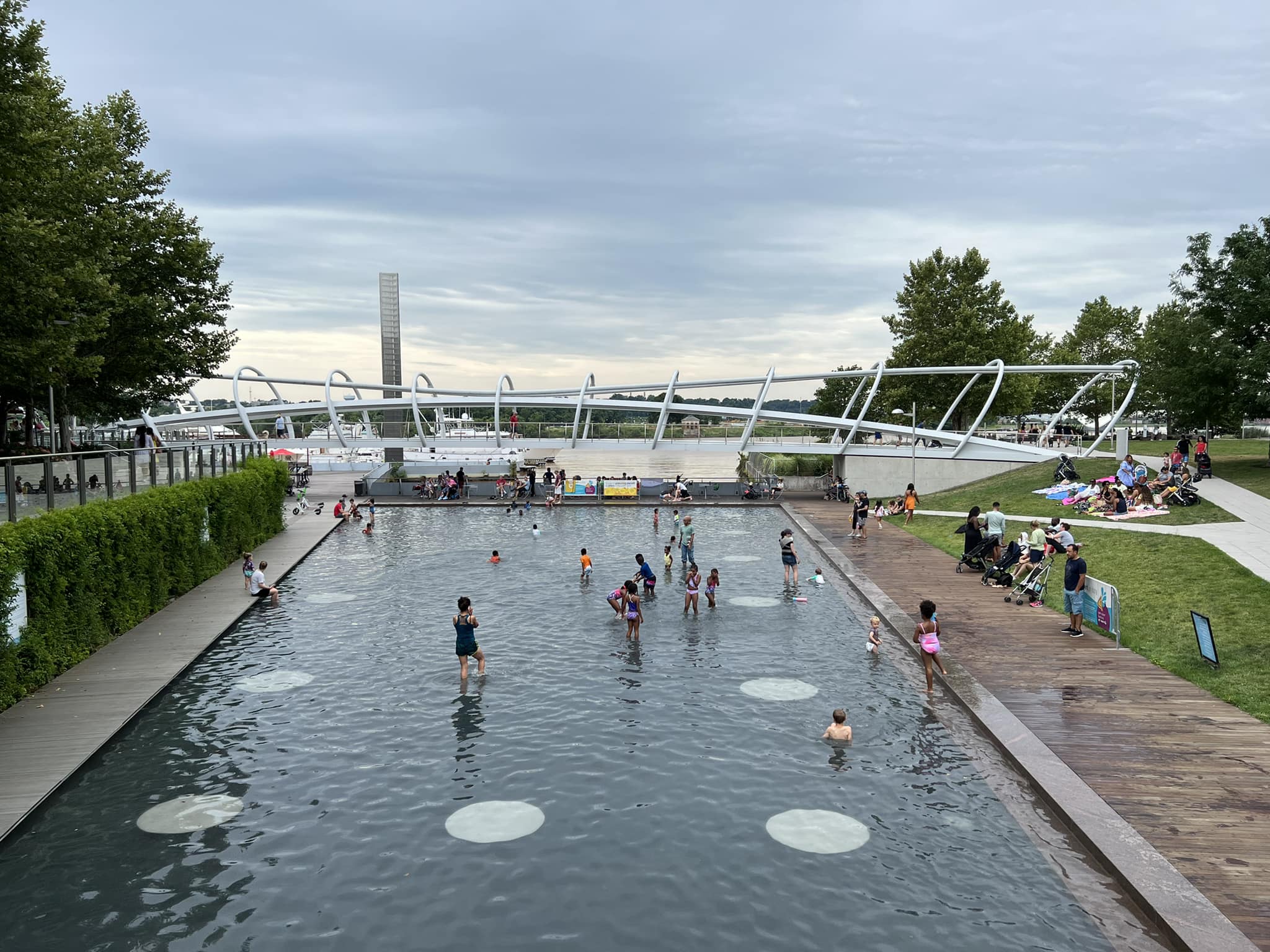
Nationals Park
| Setting | 18.5/20 | 1 Thumb Up |
|---|---|---|
| Locale | 5/5 | 1 Thumb Up |
| Accessibility | 4/5 | 1 Thumb Up |
| Neighborhood Local Scene | 9.5/10 | 1 Thumb Up |
| Architecture & Aesthetics | 43/65 | Thumb Sideways |
|---|---|---|
| Exterior Design/Aesthetics | 12/20 | Thumb Sideways |
| Interior Aesthetics/Visuals | 28/40 | Thumb Sideways |
| Concourse Aesthetics | 3/5 | Thumb Sideways |
| Functionality & Essentials | 39/50 | 1 Thumb Up |
|---|---|---|
| Sightlines: Field Proximity | 10/15 | Thumb Sideways |
| Sightlines: Seating Geometry | 4.5/5 | 1 Thumb Up |
| Seat Comfort | 7/9 | Thumb Sideways |
| Concourse Functionality | 14/15 | 1 Thumb Up |
| Scoreboards/Tech | 3.5/6 | 1 Thumb Up |
| Amenities & Features | 41/50 | 1 Thumb Up |
|---|---|---|
| Concessions: Food Variety | 5/5 | 1 Thumb Up |
| Concessions: Food Quality | 4.5/5 | 1 Thumb Up |
| Concessions: Craft Beer/Other Drinks | 4/5 | 1 Thumb Up |
| Social Gathering Areas/Restaurants | 7.5/10 | 1 Thumb Up |
| Premium Seating/Clubs | 9/9 | 2 Thumbs Up Star |
| Historical Exhibits, Memorabilia, Art, & Other Displays | 7/10 | Thumb Sideways |
| Kids Areas/Other Entertainment | 4/6 | 1 Thumb Up |
| Atmosphere, Vibe, & Policies | 11.5/15 | Thumb Sideways |
|---|---|---|
| Fan Support/Attendance | 3.5/5 | Thumb Sideways |
| Ballpark Traditions/Gameday Presentation | 4/5 | 1 Thumb Up |
| Ballpark Policies/Staff | 4/5 | 1 Thumb Up |
| Adjusted Raw Score | 153/200=76.5 |
|---|---|
| Bonus | 1 |
| Curve for All 7 | 7 |
| Final Score | 84.5 |
|---|---|
| Ranking | #16/30 |
|---|---|
Baseball’s National Statement Falls Short of Landmark Status
While Washington’s ballpark has not met the expectations of a grand American cathedral, Nationals Park is still a fine venue, by virtue of its unusual well-roundedness, as it scores above average in nearly every metric; the continually developing Navy Yard local scene may push the park into the next tier of great
By: Cole Shoemaker
Written in 2018, ratings above are up to date for 2024, but this review below may be outdated and will be updated at some point; reviews and ratings are “living pages” updated yearly when necessary
I have always felt that Nationals Park underwent an inordinate amount of scrutiny from the national press and baseball community leading up to its opening in 2008, and it has been viewed against that backdrop ever since.
The majority of my in-depth reviews require a large amount of original research, either because some information is inaccessible online for the 90s to early 2000s parks, or people just got so cynical about the so-called “mallparks” by 2017 that there just wasn’t anyone writing about them in the first place (see, Atlanta’s SunTrust Park).
But a simple Google search will render so much material on Nationals Park. In the mid-2000s, everybody had an opinion on Washington D.C.’s new baseball experiment. The same went for New York’s Yankee Stadium and Citi Field, both of which opened a year later in 2009.
It took a confluence of other factors, but the first reason for this is rather obvious. Not only were the Nationals playing in a large market, but baseball returning to the nation’s capital was a big story. The Nats were an exciting team in their first year, and the common refrain was that they better deliver a ballpark worthy of America’s capital.
D.C. is the country’s statement to the world, and baseball is its game, so the park better reflect the capital inside and out.
This also came during a time period when the online blogosphere really went into full-swing. It’s easy to forget, but before ’05 or so, the internet was young enough. For the first time by Nationals Park’s planning and construction, major publications and national newspapers had blogs and special sections where they could devote more space for opinions about something as trivial as a team’s baseball stadium. Major ballpark websites such as Baseballpilgrimages.com, Baseballparks.com, Ballpark Digest, and Ballparkreviews.com were beginning to receive a lot of traffic. Prominent message boards such as Baseball Fever’s “Ballparks, Stadiums & Green Diamonds” were exploding.
Finally, at a time when new ballparks were being built in our biggest markets and almost everybody was equipped to express their opinions on that, there was still a lingering sense of optimism about our nation’s new cathedrals that you don’t see today.
Camden Yards (1992), Coors Field (1995), Safeco Field (1999), AT&T Park (2000), PNC Park (2001), and Petco Park (2004) were all highly acclaimed, and they all brought something new to the table that we loved. There was a general sense that ballparks could and would continue to get better. Even less well-received concepts in Houston and Cincinnati were trying to push the envelope. You could tell they were all setting out to build the best ballpark in baseball.
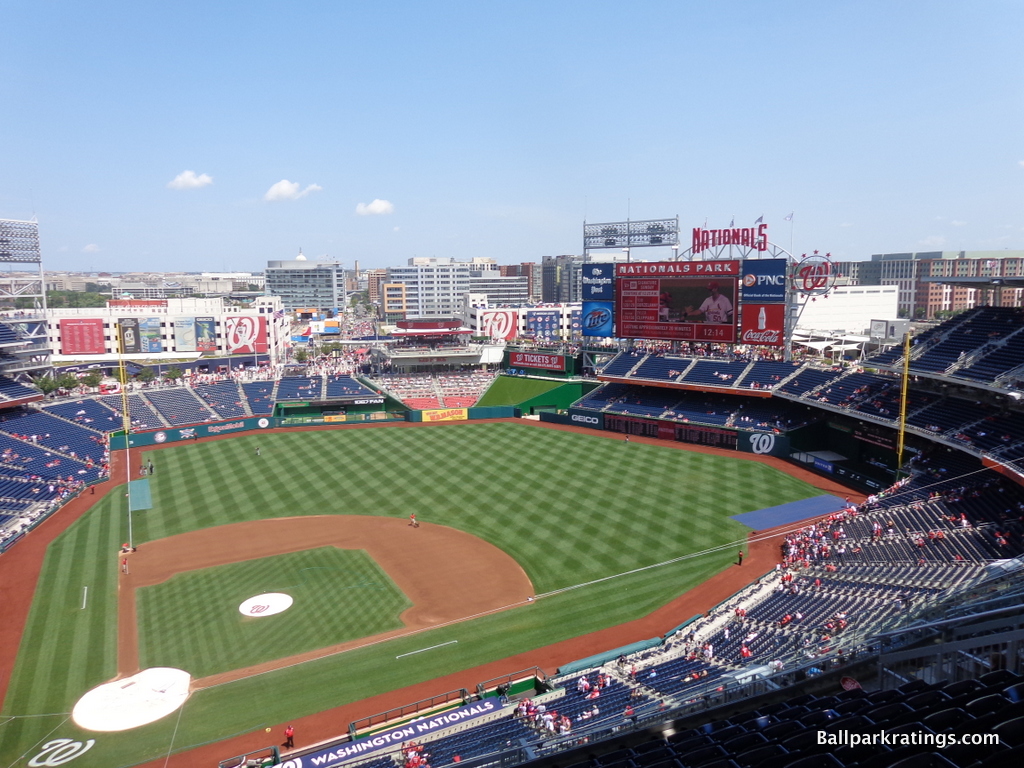
Throughout the design process and upon opening in 2008, you never got that sense in Washington. People were expecting something bold and fresh for this place in the mid-2000s, worthy of the forward-looking spirit of the nation’s capital, and they got something rather prosaic. Contrasting that to 2014-2017, I don’t think anyone expected anything new in Atlanta.
Nationals Park was perceived as the first of the so-called “mallpark era”, where baseball stadiums are primarily machines for separating people from their money. “Mallpark” is a fuzzy term, and I don’t think we fully got there until 2017, because parks from 2008-2012 still had some aesthetic purpose. But I will concede Nationals Park was probably the beginning of it, the first park where more time was spent on economic considerations compared to architecture, aesthetics, and watching baseball (2017’s SunTrust Park was almost 100% economically driven with no aesthetic vision–the first true mallpark in my book).
Anyway, this was the beginning of ballparks unapologetically focusing on the commercial aspects of architecture. Premium seating took a major step forward at Nationals Park, with not one but two exclusive clubs behind home plate in addition to the obligatory glut of club level seating and suites. This is really apparent in the Nationals Park 2007 promo video sent to all fans, where the team made the mistake of talking about premium seating 2/3rds of the time.
And design-wise, it looked like Populous just ran out of ideas. Nationals Park was perhaps the beginning of a tempering of expectations for ballparks from “ballpark aficionados.”
The negative reaction was swift and harsh. Critics quickly noted Nationals Park’s lack of distinguishing features with no defining characteristics. People called the “modern” architecture bland and uninspired, without the warmth of the retro facades or the vision of the original modern ones. They said it resembled a mall more than the National Mall. Josh Levin’s epic, “Rich Fan, Poor Fan,” is perhaps the zenith of sophisticated ballpark criticism.
In “This Diamond Isn’t a Gem,” the Washington Post voiced similar critiques, and then went in another direction, famously opining,
“If the stadium sparks economic development in the newly revitalized South Capitol neighborhood, perhaps the fact that the city got hosed will be forgotten. But the architecture will remain, and it will remain mediocre. That failure isn’t just a matter of bad negotiating on the city’s part, or bland aesthetics on the part of HOK Sport [Populous], the architecture giant that designed the rush-job Nationals Park.
It is also a colossal symbolic failure with national and international import. At a time when the United States is losing a global argument about freedom and democracy, when China and countries along the Persian Gulf are proving to an attentive developing world that top-down leadership is the best and most efficient route to prosperity, the capital of the so-called free world built a monument to its national pastime that gets a C-plus.”
I think that represents the reaction to Nationals Park in a nutshell at the time, all a function of,
a) the increased pressure to deliver a true national monument for America’s pastime in the nation’s capital
b) a new generation of communicative capacity by fans and critics on the internet, and
c) the height of national expectations (pre-‘08) for Major League ballparks after a line of truly outstanding ballparks.
Today, with the benefit of viewing Nationals Park in the context of the 24 new or renovated ballparks from 1991-2017, all of the negativity surrounding this place seems way too strong.
And that also goes for Citi Field (which I happen to view more negatively, with the differentiator from here being baseball’s worst local scene and the hermetic interior aesthetic setup) and Yankee Stadium (which I tend to view more positively, for a variety of reasons, if not because it’s so outstanding in some objective categories).
After all of the scotching hot takes, Nationals Park is inoffensive, but somehow not insultingly inoffensive like the derivative and formulaic Busch Stadium, SunTrust Park, and Citi Field, which have always seemed like actual red brick retro-cookie cutters. Washington’s park is a safe effort, but at least it’s not as derivative.
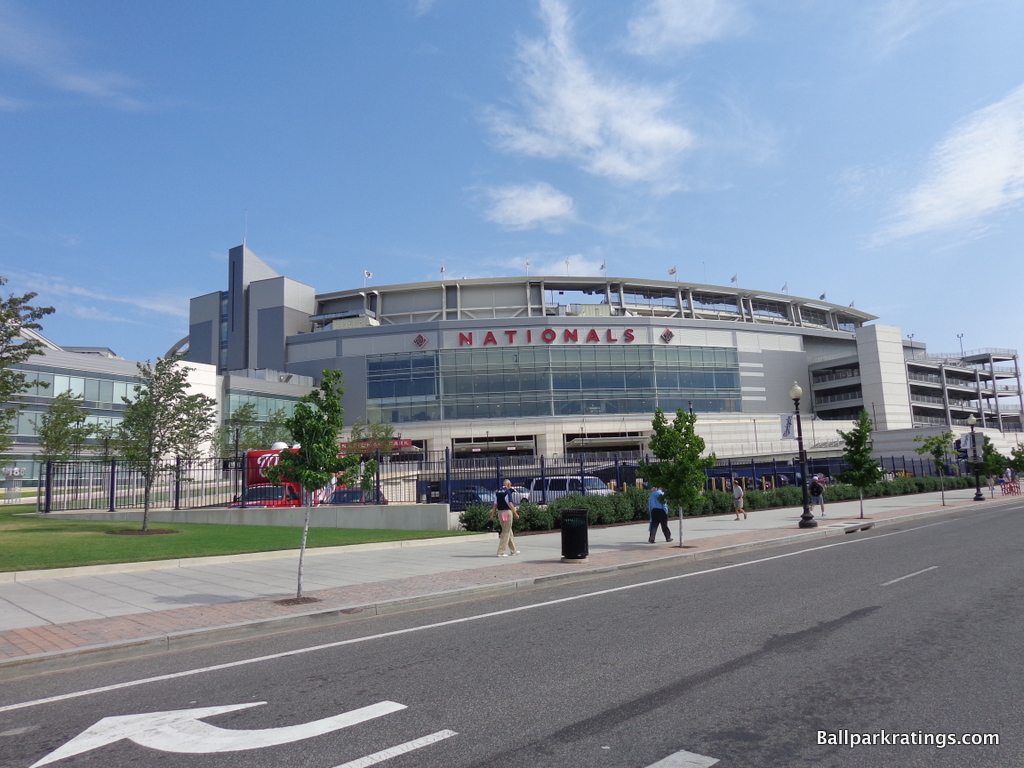
For me, Nationals Park is just broadly pleasant, and consistently above-average in most areas. And for all the critiques about the design, at least it fits in with its context, however underwhelming the actual design may be.
Ironically, after all of the media coverage, I have found Nationals Park to be one of the most difficult parks to write about. The website devoted to giving that very inordinate amount of scrutiny to baseball stadiums hasn’t been able to do it yet!
I like to begin my long-form ballpark reviews with an overarching narrative rooted in a premise that ties the genesis of the ballpark concept to its current state, whether it be glossing through news archives, looking at a ballpark’s inaugural program (something I’ve collected via e-bay over the years), reading current day blogs, or just looking at how the theme/design vision evolved. That’s hard to do here.
There’s no flowery romantic baseball narrative to Nationals Park. There’s no hindsight regret narrative like new Comiskey. Nationals Park is kind of blandly above-average across the board, almost without exception. It’s hard to give bonus points, because this park is mostly devoid of superlatives. Hardly anything spectacular, but hardly anything subpar, either.
As you can see by the score, that doesn’t have to be a bad thing. There’s something to be said for well-roundedness.
From the outset, I do think it’s important to address the critique that Populous “played it safe” with Nationals Park’s architecture and aesthetics. While undoubtedly true, where Nationals Park lacks boldness and ingenuity, I believe the local constraints had a lot to do with it.
You don’t see this explicitly acknowledged in the myriad of “sophisticated” reviews regarding D.C.’s should-have-been baseball cathedral, but Nationals Park wasn’t really supposed to have a striking “presence” in Washington’s landscape. If you look at the language from the sports and entertainment commission, the park was intended to understatedly “fit-in” with the conceptual scheme of national monuments. There’s a lot of conflicting information on this, like Populous said it would anchor the “monumental core,” but I don’t think the city planners wanted Nationals Park to “anchor” the scene in a physical sense, even if it was going to anchor the new development. In other words, the fact that Nationals Park “fades into the landscape” could be construed as intentional.
Yes, they went cheap with some of the materials, and this is by no means a top ballpark exterior design, but I don’t think it’s an unmitigated disaster. And I appreciate that the design at least has a modern conceptual focus.
The interior aesthetics are similarly understated but certainly stronger, functioning as any good ballpark interior design should, open to any surrounding contextual development. National landmarks can only be viewed from a few spots under the right conditions, probably the difference between a good interior and a great one.
While the Capitol Building can only be viewed from parts of the upper deck, I do like the clever integration of the Washington Monument into the ballpark. It’s arguably even more limited, but took some sharp dexterity: it can be viewed exactly from where the gap in the seating splits down the right field line on the main concourse, precisely centered in between the end of the left field grandstand ramps and the beginning of the outfield parking lot façade.
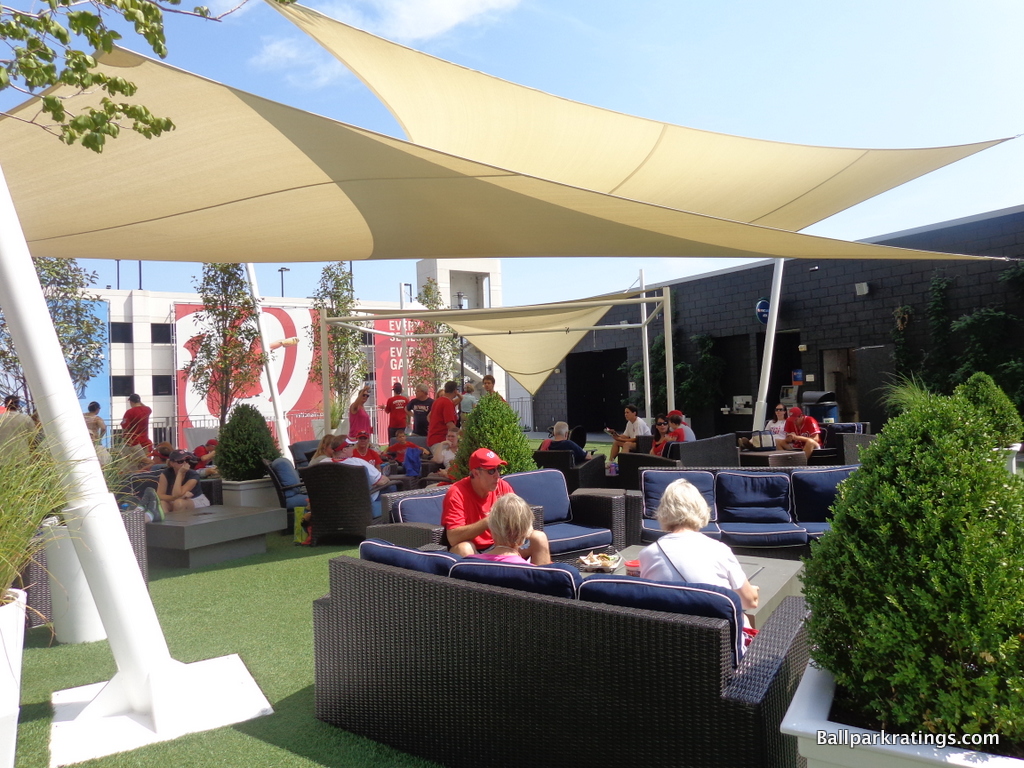
Nationals Park’s general well-roundedness as a ballpark experience becomes particularly apparent at this point, as one might marvel at the general openness of the concourse system and glance at some thoughtful artwork above. Nationals Park continued the trend started by Citizens Bank Park in Philadelphia by encouraging fans to walk around and enjoy the game from different vantage points. Openness from the concourses is a big theme here. D.C.’s ballpark is particularly functional, and I mean that as a compliment. If I had to pick one flaw, it is that the upper decks are too pushed back, even for a new park.
Nationals Park has above-average to great amenities in every respect. Regular food and beverage options are close to outstanding, with plenty of variety and great quality. The Nationals brought in a couple of regionally inspired local food options as well, highlighted by Ben’s Chili Bowl. Leading the trend of more informal fan-friendly social spaces, as opposed to the “stadium club” restaurants of the prior decade, the Nats have the Red Porch restaurant (Budweiser Brewhouse) and the Scoreboard Walk (now confusingly called the Budweiser Terrace). On the other hand, Washington has some of very best premium seating in baseball in both quantity and quality, but without the snobbery or super high prices you might see at Yankee Stadium. Finally, the Nationals did a decent job of honoring Washington baseball history, considering the franchise itself has so little of it.
All of this translates into a very good ballpark in my top-half, but the continually developing Navy Yard local scene may push Nationals Park into the upper-echelon. Note that first line from the excerpt of the scathing 2008 Washington Post review quoted earlier.
The government’s idea that this blighted section of southeast D.C would undergo a Gaslamp District-style transformation was generally perceived as a huge stretch. The conditions weren’t as favorable for such a revival, unlike the Inner Harbor around Camden Yards. But as I’ll get to in the next section, everything seems to have worked out, surprising even the most bright-eyed optimists. Unthinkable a decade ago, Nationals Park could have a location and local scene on par with the country’s best by 2020.
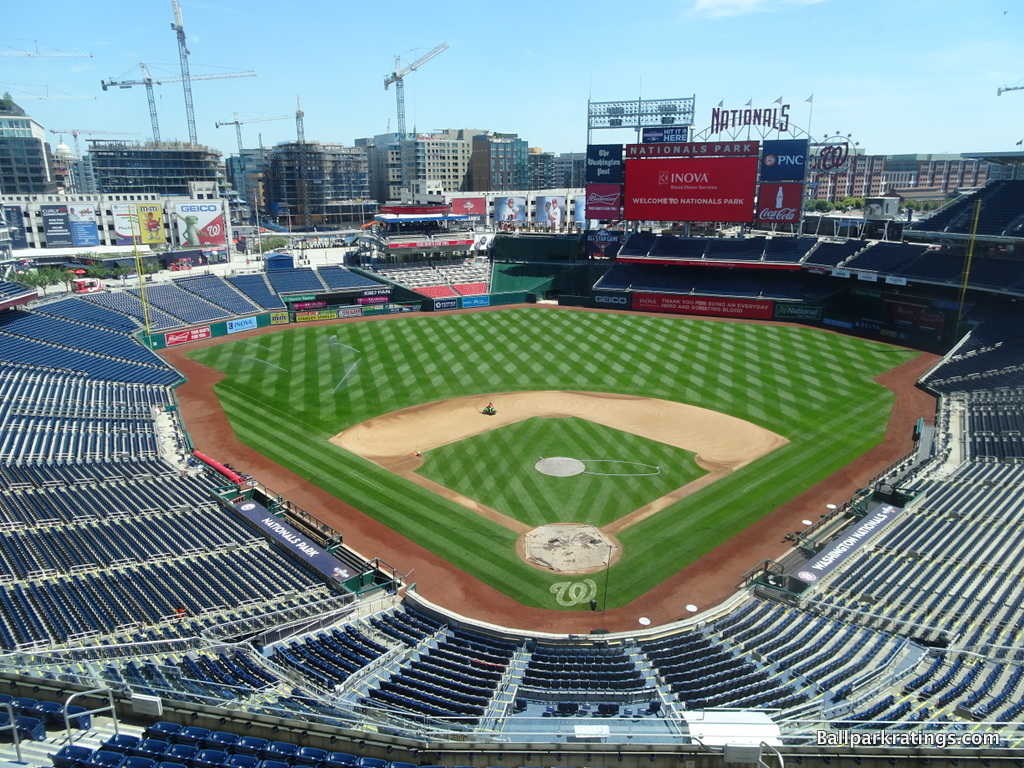
For the 2018 All-Star Game, you’ll see that the view beyond left field looks like a construction project, because the area keeps growing. Look for plenty of media coverage about the developing area. Note that our score for the interior aesthetics and location/local scene could change after this is complete.
Often noted for its lack of distinguishing features, Nationals Park is still an enjoyable place to see a game, and I actually still find it more memorable than some of the more derivative retro parks. There wasn’t much new ground broken here, but that’s true for the majority of MLB venues.
In the end, Nationals Park was defined by a market and a time-period that demanded all-time greatness, and a fan base that earnestly had similar expectations. While Nationals Park falls well short of that, it is an all-around very good ballpark, unusual in its complete lack of glaring flaws. Nationals Park may even become a great park as the Navy Yard continues to develop.
Setting
Location/Access:
When deciding on a site for a new MLB ballpark, the most ideal spot is almost never ideal. It’s usually in a dilapidated area on the outskirts of the urban core, but with some promising factors that indicate the area could be revitalized.
If we’re just talking urban locations, this has ranged from Marlins Park’s Little Havana neighborhood, which goes in the “we just want a new ballpark anywhere we can get it” category (little development has even been discussed), to Camden Yards, which had a pretty good formula that indicated urban renewal was likely.
On that spectrum, Nationals Park was somewhere in the middle, and most urban design experts were not optimistic about the possibility of transforming the area.
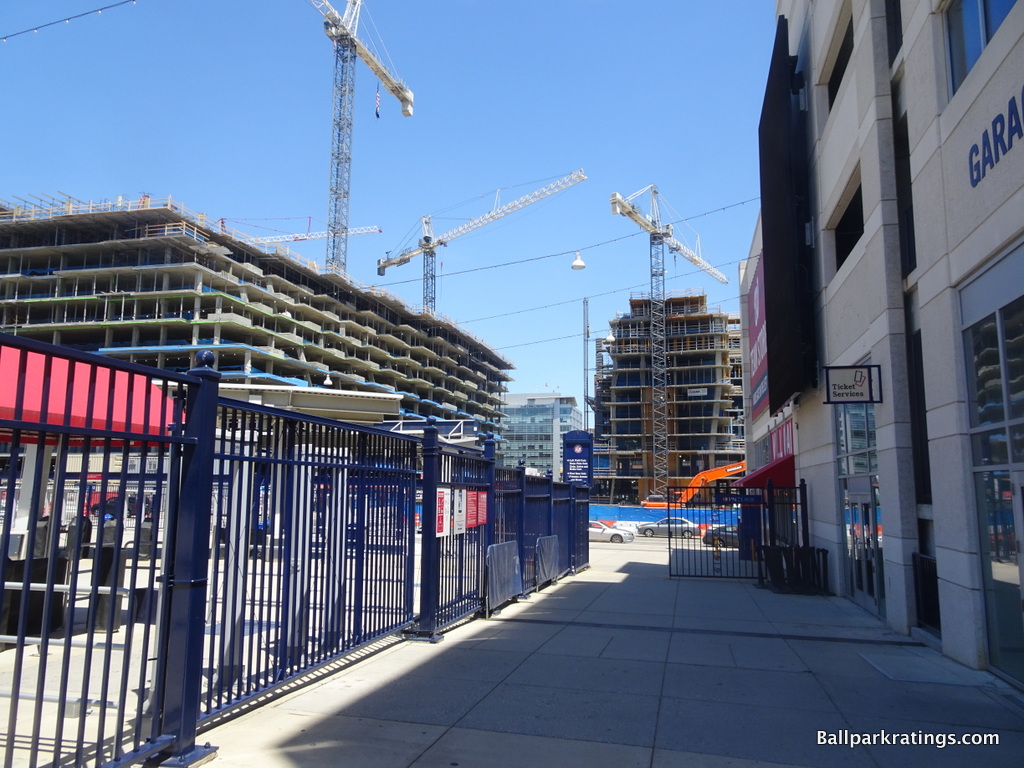
Nationals Park is nestled in a southeast Washington, D.C. area called the Navy Yard, about a mile south from the U.S. Capitol. It’s hard to come up with a good urban comparison because the landscape of D.C. is obviously different from your average big city, but you could think of the Navy Yard as a classic run-down area on the periphery of an urban center. Nationals Park sits along the Anacostia River, bordered by South Capitol Street, First Street, N Street, and Potomac Avenue.
To use the language of developers, this industrial strip had been long “neglected” by Washington. Before the District government used eminent domain to claim the land, the 21-acre footprint had been home to asphalt plants, liquor stores, a strip of adult night clubs, fences topped with barbed wire, body shops, alleys choked with litter, and people loitering in odd spots.
I’m not sure why everybody in baseball and D.C. thought this area was more unlikely to be subject to sweeping gentrification compared to other ballpark urban zones, because it’s not a bad “location” if you were to start a city on the map. The proximity to a riverfront and nearby landmarks seems prime.
Many use the D.C. subway, known as the Metro, to get to Nationals Park. In the early days, you often heard that parking was pretty hard to come by if you didn’t have season-ticket parking. Recently, I’ve heard parking really isn’t as bad as advertised, as there is day-of-game parking about a 7-10-minute walk from the ballpark, which is fairly standard.
Nationals Park might be the most bicycle-friendly park I’ve ever seen. Hundreds of bike racks are placed around the ballpark, and there’s even a bike valet.
One final note: the team has an awesome page specifically dedicated to accessing Nationals Park on their website, about as extensive as I’ve seen in the MLB. That should probably tell you something about the anticipated access issues. If you’re on the other side of the river, consider the Water Taxi!

Score: 4.5/5
Local Scene:
Almost every urban park spurred some form of revitalization, and soon after opening, an array of office space, retail options, restaurants, and bars were constructed around Nationals Park. But anything more wasn’t a given, and without anything more, the ballpark simply wouldn’t have been worth the cost to the district.
There was also a perception that no matter how well the project went, past associations could not be overcome. Today, if you ask most people in Washington, those associations have been largely overcome. That enormous block of space called the Navy Yard has been truly transformed into a riverfront showpiece. If you take a 20-minute walk around the area, you’ll count nearly 20 restaurants and bars. Walking along the Riverwalk, you’ll note the river itself looks pristine too, a prediction that would have gotten you laughed out of the conversation 10 years ago.
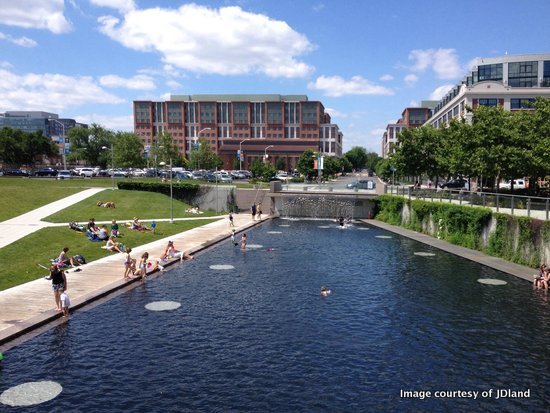
Most notable is The Yards a block to the east, consisting of a family park, reflecting pools, modern sculptures, and restaurants.
After the recession subsided, the development of more residentially-oriented projects was a pleasant surprise. Today, we see hotels and apartment complexes springing up all over the area, most notably beyond the outfield. Fans can watch the game from the Top of the Yard Rooftop Bar at the new hotel beyond center field.
Culinary and beverage highlights in the neighborhood include everything at Bluejacket, the wings at Bonchon, the seafood at The Salt Line, the Italian fare at Osteria Morini, the beer at Bardo, and the desserts at the Ice Cream Jubilee.
In sum, Nationals Park has reshaped the Navy Yard into a glittering hangout for everyone. This has confounded the expectations of even the most caustic cynic. And there’s still more to come!
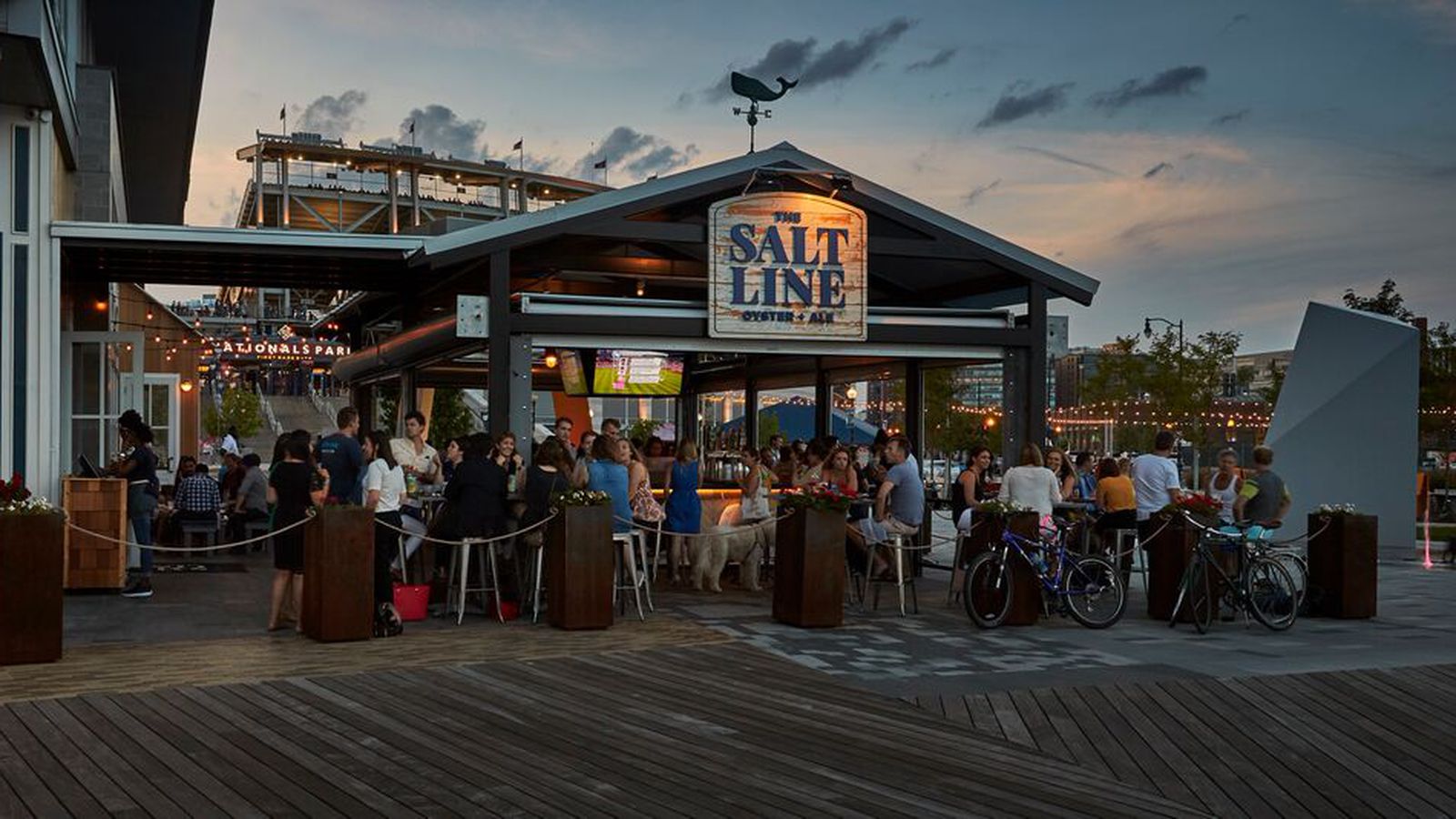
Score: 4.5/5
Total: 9/10
Architecture & Aesthetics
Exterior Design:
For a structure apparently inspired by I.M. Pei’s East Wing of the National Gallery of Art, Nationals Park’s exterior façade comes off as unapologetically mundane, with all of the pomp and grandiosity of a suburban office park.
While Nationals Park so plainly falls short of the national monument we should expect, I do believe the design has its merits. Not only is it a welcome departure from Populous’s passé red-brick retro architecture, but the aesthetic fits in wonderfully with its surroundings.
Because I am releasing these in-depth reviews so periodically at this point, it might be instructive to outline what I look for in an exterior design. While (1) raw aesthetic appeal and sound architectural principles are paramount, I also consider (2) structural innovation and novelty, specifically if the treatment was unique for its time, or if it was merely a formulaic rip-off. I also look at (3) how well the architectural materials and overall treatment fit in with the surroundings and the ballpark’s (4) conceptual intentions on its own, as there are a few ballparks that are quite conceptually clever, but may not look that great.

Lacking the structural presence to elicit an immediate and memorable sense of arrival while eschewing the use of high-quality materials seen in other non-red brick ballparks, Nationals Park fails resoundingly on the first account. However, I think the park is more successful in (2) and (3), which save it from being one of the worst exterior designs.
Case in point: Citi Field’s red brick Ebbets Field mimicry, generally considered much more attractive, just scores barely higher in my book. This aesthetic had grown tired by 2009. It was an unforgivably lazy design choice; it was a blatant rip-off from other retro parks. Moreover, there’s something unavoidably fake and stage-set about the “old-fashioned retro ballpark in a suburban parking lot” aesthetic. Retro looks more authentic when it’s woven into an urban setting. It has just never worked in suburbia, in my opinion. Architectural designs should have some connection to their settings. Both of these critiques also apply to Citizens Bank Park and SunTrust Park, which score lower than Nats’ Park in this category.
Say what you will about Nationals Park’s more contemporary architecture, but it does not suffer from these two problems.
Let’s get into the details, starting with the park’s pure architectural merits.
Intended to echo the traditions of Washington’s best civic buildings, Nationals Park uses translucent glass, steel, and pre-cast concrete in an effort to reflect the ethos of the city’s monuments. Quite noticeably, the rather heavy pre-cast concrete is painted to look like limestone. Nationals Park was originally rendered in limestone, but limestone was eliminated in order to save money. I.M. Pei would not approve.
The resulting effect is a building that looks more dull and bland than iconic and modern, resembling the Verizon Center instead of a nearby architectural monument. It most reminds me of a generic Arts and Science building on one of the hundreds of university campuses across the United States. Nationals Park is simply streamlined glass and painted concrete, devoid of any of the unique regional accents commonly seen in other MLB parks.
The standards for MLB ballpark architecture are inexcusably low, but this is not the norm. PNC Park features rugged Kasota limestone, Yankee Stadium has granite quarried from Maine and limestone from Indiana, and Petco Park imported ochre limestone from India. More resembling the White Sox derided 1991 park than anything else, Nationals Park’s use of mediocre materials is unacceptable.
You might be asking, why should I care? Ballparks are for watching baseball, and people aren’t going to spend time looking at it outside.
Not only is a ballpark a region’s statement to the country (or, in this case, the world), but you’re probably paying for it. This is especially true in Washington, which got one of the worst deals in recent memory.
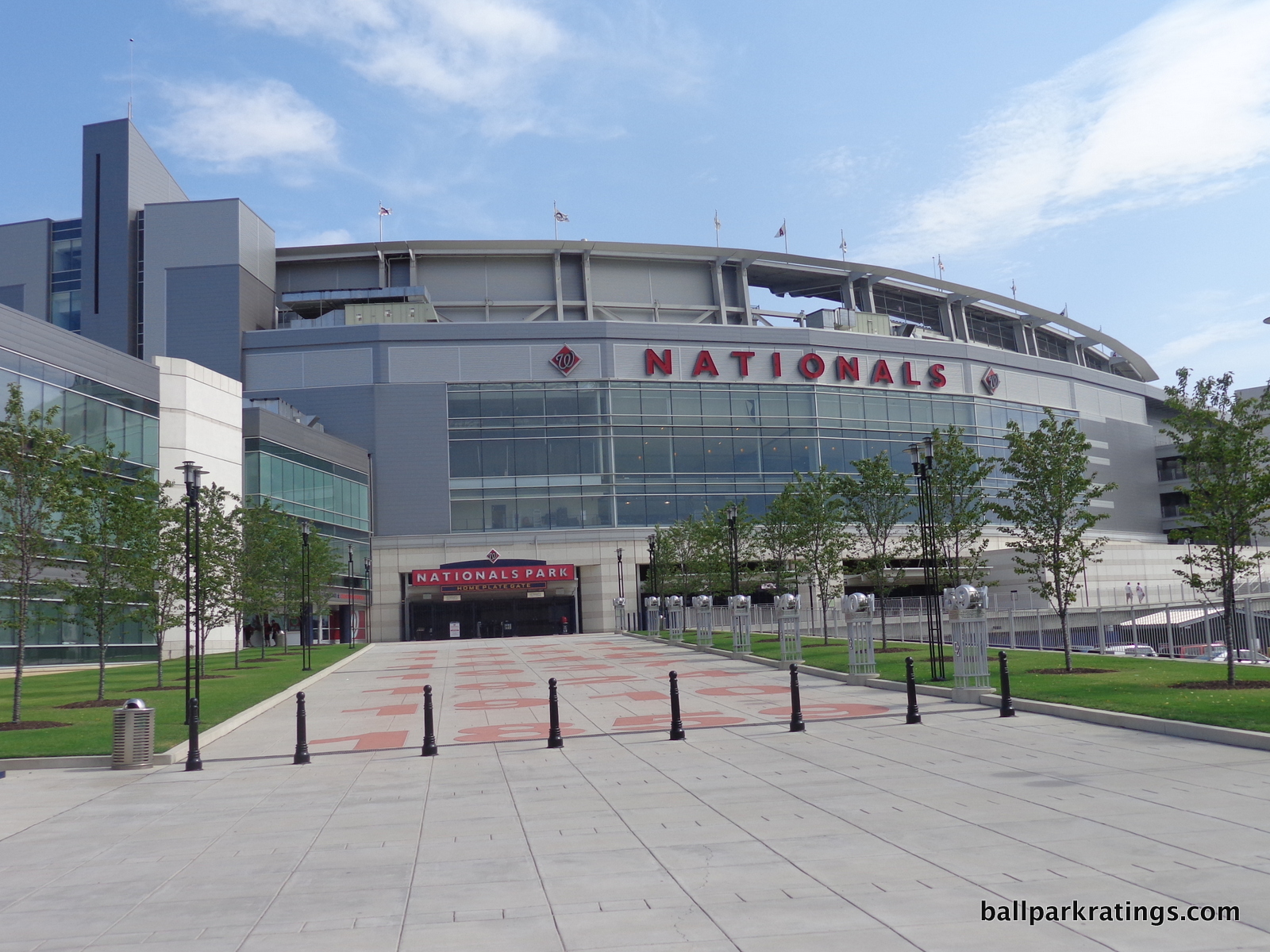
Neil deMause has done a great job of documenting the scandal that is publicly-funded sports stadiums over the years, but I’ve generally avoided the topic because I have nothing else to add. If anything, public funding has shown to be a fait accompli in states not named California. Even armed with knowledge that the investment isn’t worth it to the taxpayers, people will ultimately fall for the civic pride argument.
What I will say is that as long as facilities are publicly funded, I am going to fight tooth and nail for the next dollar to go to constructing something of architectural merit rather than to the next suite level. I urge the public to demand more.
Moving on, there are two other rather crucial design aspects that could have been improved.
Nationals Park’s signature entrance that possesses the qualities described is behind home plate, but the vast majority of fans enter through the center field gates. The center field entryway is unremarkable, flanked by two bland parking garages. Reminiscent of Turner Field, most fans aren’t going to see the façade. If you loved the glassed entryway behind home plate, you likely won’t see it.
Moreover, the home plate entrance isn’t particularly inviting. Approaching from the South Capitol Street bridge, note that underground parking takes up the majority of the space around the signature entrance. Unless you go toward the walkway leading to the home plate gate, you can’t walk right up to the façade.

With the flurry of new development, this would have been a great place to put a garden or some street-level development. Perhaps the cold façade would look a little more palatable if the team did this.
So, what saves Nationals Park from scoring at Angel Stadium painted concrete levels?
Along with just not being retro, frankly, Nationals Park fits in wonderfully with Washington’s landscape and is in proper scale with its surrounding environs. Except for perhaps PNC Park, all of the parks mentioned throughout this analysis don’t do as well in this respect.
The more I think about it, the fact that Nationals Park “fades into the landscape” is more of an asset than a deficit. Think of Chicago and Boston. You could make the argument that Wrigley and Fenway are the most recognizable and historic buildings in town. That was never going to be the case with Nationals Park in Washington D.C., and, would you really want that to be the case?
Nationals Park doesn’t make the assertion of being D.C.’s next historic monument, nor should it. The building showcases a design that is compatible with the national memorials, not one that stands out among them. Washington D.C. possesses an order of tones that are grey and neutral (and maybe even dull), and Nationals Park is grey, neutral, and dull. A “civic-looking” building isn’t necessarily going to be warm and attractive.
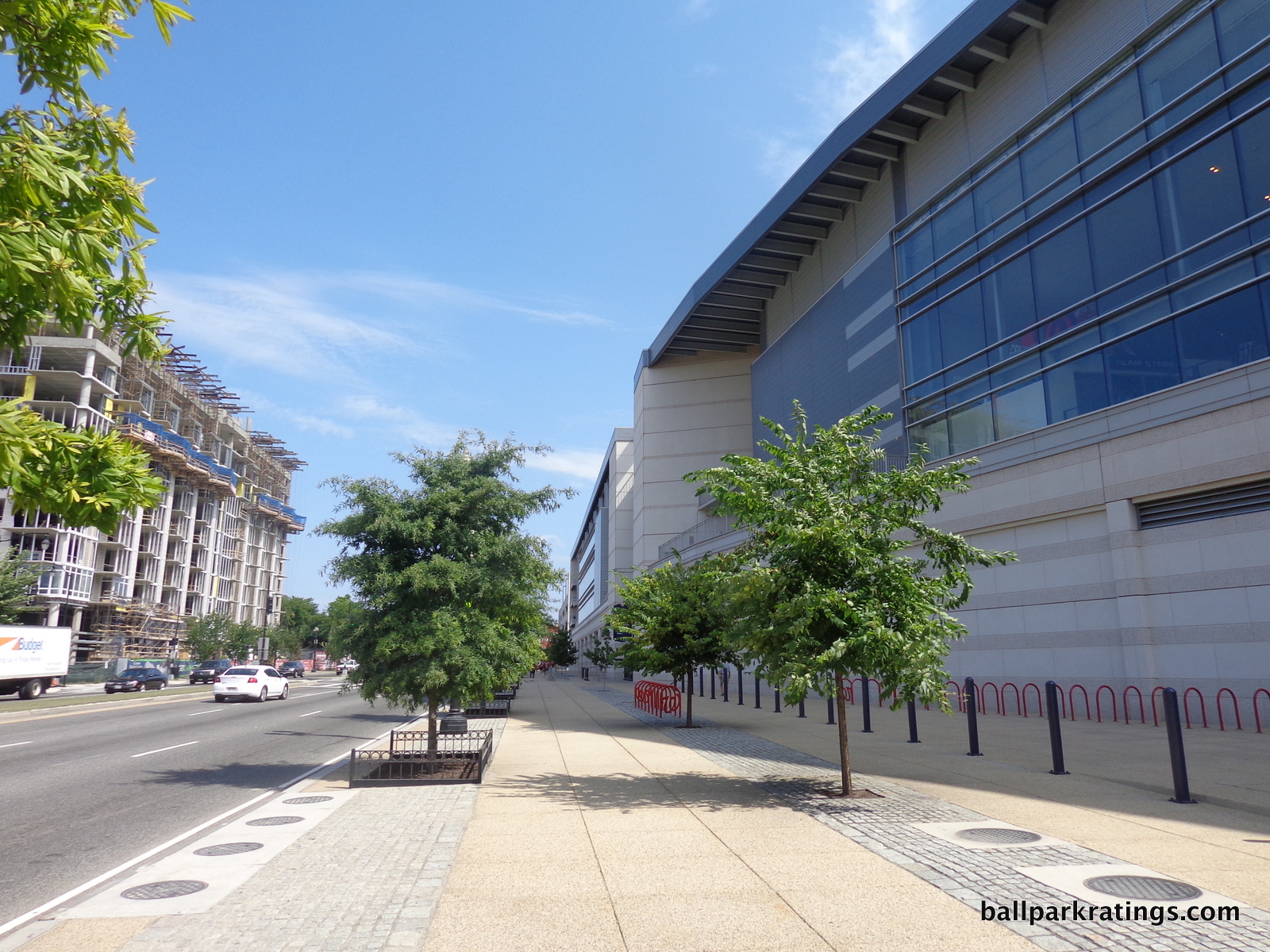
Nationals Park really fits with its physical plant as well. Note how the southern end of the site is sharply angled by Potomac Avenue and South Capitol Street. The architects adroitly used this space to create a sharp façade that fits with the edge of the intersection. Linear forms slide through the curvature of the façade. I’m generally not a fan of the weird, unprincipled quasi-deconstructivist style Populous sometimes employs, but I thought this was clever.
Regardless of architectural merits, I think there’s something to be said for building a structure in unison with its context. More attractive exteriors in Arlington, Miami, and New York can’t say that.
Overall, Nationals Park isn’t particularly serious in its architecture. Its crude use of materials and assembly-line looks aren’t going to inspire anyone, but it is very D.C. and presents a welcome departure from the ubiquitous retro designs.
Score: 6/10
Interior Aesthetics:
While the inside of Nationals Park is more attractive than the outside, the interior aesthetics are actually more formulaic, bringing very little new to the table in terms of unique structural design flares or distinguishing features.
At this point in ballpark development, I’m of the thought that this doesn’t necessarily have to be a bad thing. Sound interior design principles are executed through clean, crisp architectural lines and integrated urban aesthetics allowing for beautiful views. The last thing I would want is some kitschy gimmick to superficially differentiate the ballpark. A couple of ballparks that have been called “boring for having nothing distinguishing” actually have gorgeous interior aesthetics.
But even with this in mind, Nationals Park seems particularly copied and pasted.
Except for the upper deck press box, the seating bowl looks like any other in baseball, but then emulates the split upper deck and right field grandstand gap of Philadelphia’s Citizens Bank Park. Groundbreaking from a functional point of view, many aspects of Citizens Bank Park (2004) are copied by Nationals Park.

Looking to the outfield aesthetics, the most noteworthy feature, the Budweiser Brewhouse, is obviously cribbed from another NL East rival’s ballpark, Turner Field. Like Turner (and now SunTrust Park and many others), Nationals Park also has the ubiquitous outfield plaza entry.
Where Washington’s park finally introduces something novel, it’s unfortunate. While the park is perfectly aligned to capture views of the district’s greatest landmarks, it introduces two poorly situated parking garages (a MLB ballpark first, at least to this extent) into the interior schema. There’s one positioned on each side of the left-center field entry plaza. They are clearly present in the ballpark’s foreground.
Everything is either amenity-driven or centered around providing optimal functionality, not adding a unique design flare or a contextually cultivated aesthetic space.
Taken on its own merits, Nationals Park has some nice elements (which I’ll get to), but it is not too visually impressive. We have no independent aesthetic vision, no individual aesthetic anchors, and little visual distinctiveness, all of which put a cap on how high Nationals Park can score in this category.
Where Nationals Park departs from the very similar Citizens Bank Park is that it doesn’t have to solely rely on its own merits for aesthetic value. While Citizens Bank Park has more confident and coherent interior lines, some interesting structural novelty, and the most attractive batters’ eye in baseball, its energy dissipates into a sea of suburban parking spaces.
Ballparks are a product of their surroundings. They always have been. The best ballparks visually respond to the contextual forces of an urban area, usually by showcasing prime views of the landscape.
How does Nationals Park fare here? Better than you might think.
Let’s start with the obvious: yes, few fans can actually view the Capitol or the Washington Monument.
Located a mile or so beyond left field, views of the Capitol have always been fleeting, seemingly darting in and out of view between buildings and construction cranes. As of 2018, the new development has all but engulfed the view even from the upper rows of the first base upper deck. There is still an obstructed view exactly between the two buildings farthest to the left above the first garage.
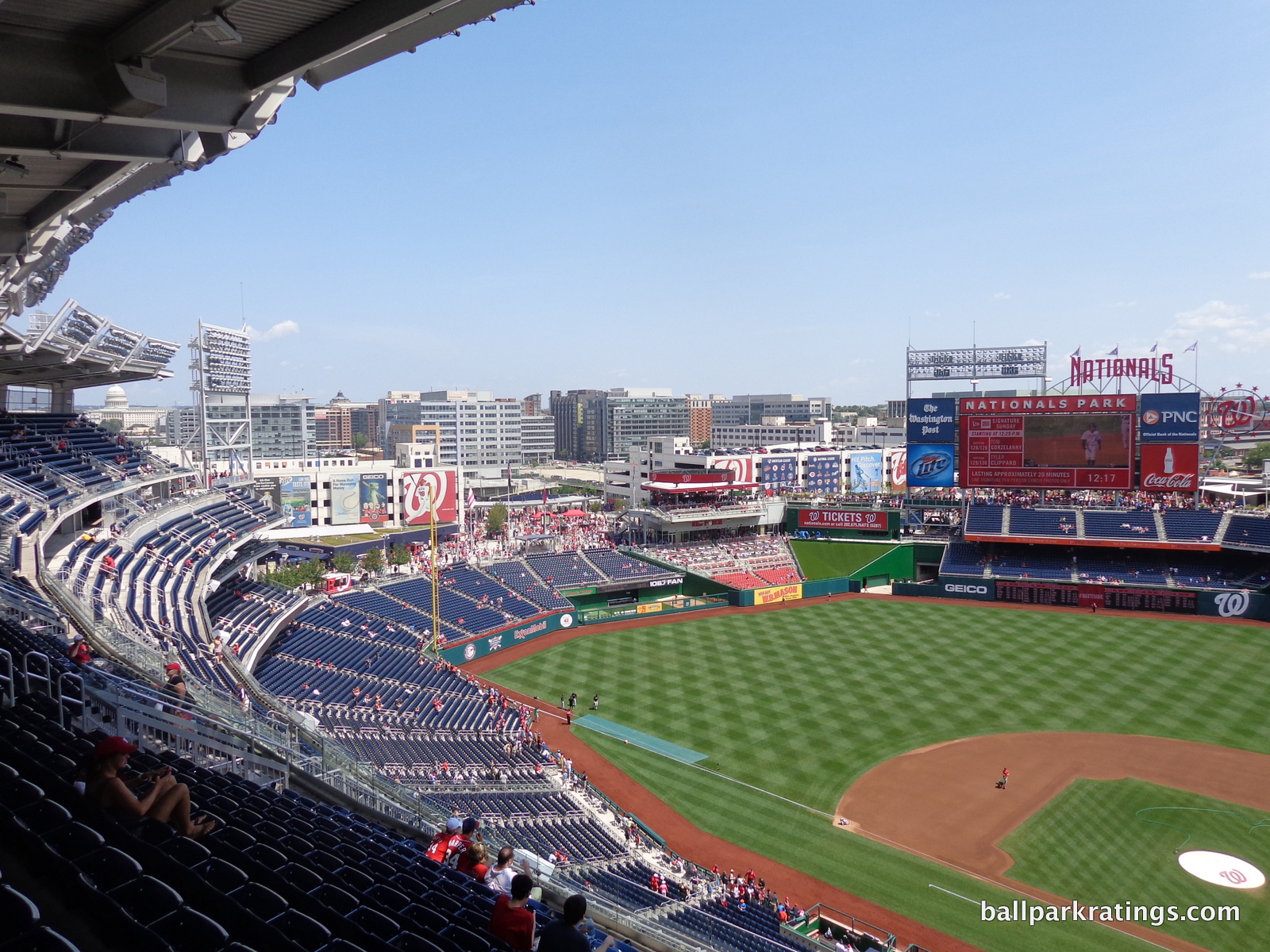
As I stated in the introduction, the integration of the Washington Monument is even more limited, but I think the effort is more impressive. It can be viewed exactly from where the gap in the seating splits down the right field line on the main concourse, precisely centered in between the end of the left field grandstand ramps and the beginning of the outfield parking lot façade.
In practice, these landmarks are absolutely not part of the ballpark schema, certainly not as of 2018.
And yet, Nationals Park still has a better contextual connection than more than half of MLB ballparks. Despite the garages, Nationals Park feels very open on the left side, so the development really seeps into the interior aesthetic scene. I’d rather be looking at ten-story urban office buildings than empty seats or tacky ads. That should go without saying, but with all of the negativity surrounding Nats’ Park, I wasn’t sure.
It made for a surprisingly nice backdrop in 2012, and once the 2018 construction is done, it will be even better.
What is really neat is that the new construction is right at the ballpark’s doorstep. You may not think about it, but with all the best downtown vistas in baseball, the buildings and skyscrapers are blocks away. This development is across the street. No, it won’t be one of baseball’s best views, but I think people will be surprised by how nice it will look.
While Nationals Park’s openness allows for excellent contextual integration, it could have been even better with a more prudent placement of the parking garages. That being said, they are not nearly as ugly or noticeable as I thought they’d be back in 2008. That Nationals seem to have painted them in a more palatable shade of light grey, and the banners and ads covering the garages do a better job than one would think. While present in the foreground, the primary focal point is still the surrounding development.
The backdrop isn’t very distinctive, and that’s okay.

Given the mediocre monument views, some have pondered whether it would have been better to orient the park toward the Anacostia River. The Nationals realized early on this would have been a poor design choice. If Great American Ballpark’s decision to turn its back on its city was questionable, this would have been crazy. Even more so than Cincinnati, the river is simply too far away from the site (600+ feet from home plate). Buildings have been constructed between the park and the river as well. Finally, as people in Cincinnati can tell you, a distant river view is the opposite of picturesque for a night game. Fans would be staring into darkness for the vast majority of their time at Nationals Park. Plus, the gap between the right field grandstands serves to integrate some river views into the ballpark during the day from left field.
The current ballpark orientation was clearly the right call.
As I look toward the more self-contained aspects of the interior aesthetics, my opinions are much less favorable.
I find the center field scene, particularly the asymmetrical dimensions and jagged batters’ eye, much too jarring and completely contrived. The right half of the center field wall juts out at a right angle, in an apparent nod to Griffith Stadium. The notch mirrors the center field crook built around five houses and a tree at the old ballpark.
While that was borne of necessity, the notch imported into Nationals Park is a function of synthetic nostalgia that doesn’t fit with a forward-looking ballpark. Sure, it’s a nice tribute, and thankfully a subtle one compared to the heavy-handed retro nonsense of the early-2000s, but I’m generally not a fan of fake quirkiness (it doesn’t factor too much into the equation for me, though). What made the notch special at Griffith Stadium was its authenticity.
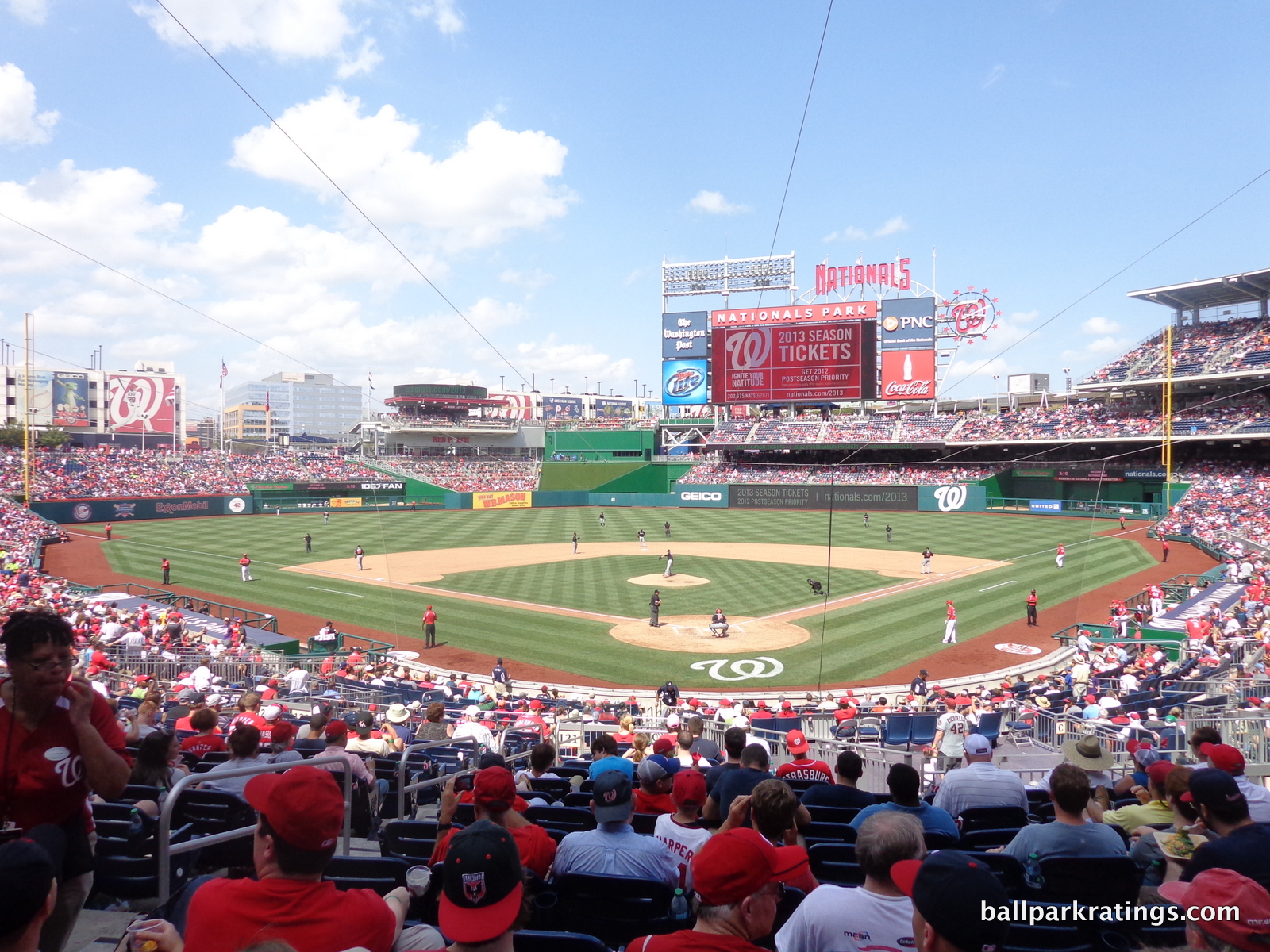
More importantly, I just don’t like the center field scene visually. The jagged angles of the triangular batters’ eye are just too busy, leading to a poor use of space to the right. Note how the lines of batters’ eye and restaurant seating are all heading in different directions. Your eye wanders, in a picture with too many angles, to many jarring elements, and a complete lack of cohesion. How do hitters deal with this?
It doesn’t control the space, as an architecture student might say.
I do love the color scheme inside Nationals Park. The blue seats are bright and welcoming, and the park as a whole is distinctly more colorful and vibrant than most across the majors. This is largely due to the red porch seats in center field. Some thought it would be too much, but I think the blue, red, and green all come together for a flavorful combination. The press box in the upper deck was originally red, and that was too much. I’m glad that Nationals painted it blue.
Washington’s ballpark has some interesting supplementary features and subtle touches worth discussing.
In order to make the park more distinctive and echo the spirit of the nation’s capital, the Nationals famously imported Kwanzan Japanese cherry trees (from Pennsylvania for some reason) and planted them above the left field seating. The problem is the cherry trees fully bloom in the early spring, and even then, they aren’t very noticeable. The six or so trees are also smaller than you might expect. Overall, it’s a thoughtful concept that adds little to nothing in practice.
The curly “W” to the right of the videoboard is a nice touch. Originally an analog clock, the Nationals decided to remove the hands and make it a piece of Nationals-themed art. The “W” logo is surrounded by a circle of 12 red stars.
While I don’t like some of the more contrived dimensions, I appreciate that Nationals Park is not muddled with more explicit gimmicks. When I say gimmicks, I mean hokey over-the-top thematic features like a giant old-fashioned glove, a model home-run choo-choo train, a Chick-fil-e cow, a model riverboat, or a set of fake smokestacks. Or, say, this giant baseball seen in the Nationals Park rendering!

I don’t hate all of those I just listed, but I’m inclined to hate a gimmick unless it’s (a) aesthetically attractive, and (b) there is a well-articulated reason for its existence that relates to the overall design. Both would not have been true with the giant baseball. It looked like something out of MVP Baseball’s expansion team stadium. They literally took this out of a baseball video game. I am very pleased that the Nationals discarded the idea of putting a giant baseball on top of the restaurant.
While minor, the bluestone backstop behind home plate is one-of-a-kind in baseball. A common material in the region, this gives the park a D.C. vibe for those watching at home. Backstops are almost entirely muddled with ads these days, but I think some distinction makes an impression for those watching on T.V.
Finally, I thought I’d mention one aspect that hasn’t been noticed by many: the lights attached directly onto the ballpark canopy. Most other ballparks have light towers that extend upward above the ballpark. Not here. They are attached directly to the canopy to minimize glare on the neighborhood, and perhaps adhere to height restrictions that prevent a building from dominating the landscape.
In sum, Washington D.C.’s ballpark doesn’t have the coherent interior lines or the bold but authentic distinguishing features of the best interior designs, but it does what any good ballpark should. Nationals Park visually integrates its surrounding context into the ballpark experience, importing the local flare of the area and creating a decent backdrop. And honestly, that’s the baseline for at least a decent interior aesthetic scene.
Score: 10.5/15
Panoramic View/Backdrop:
How I’ve structured these reviews has evolved over the decade, where it just feels more organic to discuss this fully in the interior aesthetics section. But the purpose of this extra rating was always clear: to emphasize that contextual integration is the most important aspect of the interior aesthetics.
As outlined, despite the limited Capitol/Washington Monument views, Nationals Park’s openness makes for a good backdrop that is only getting better.
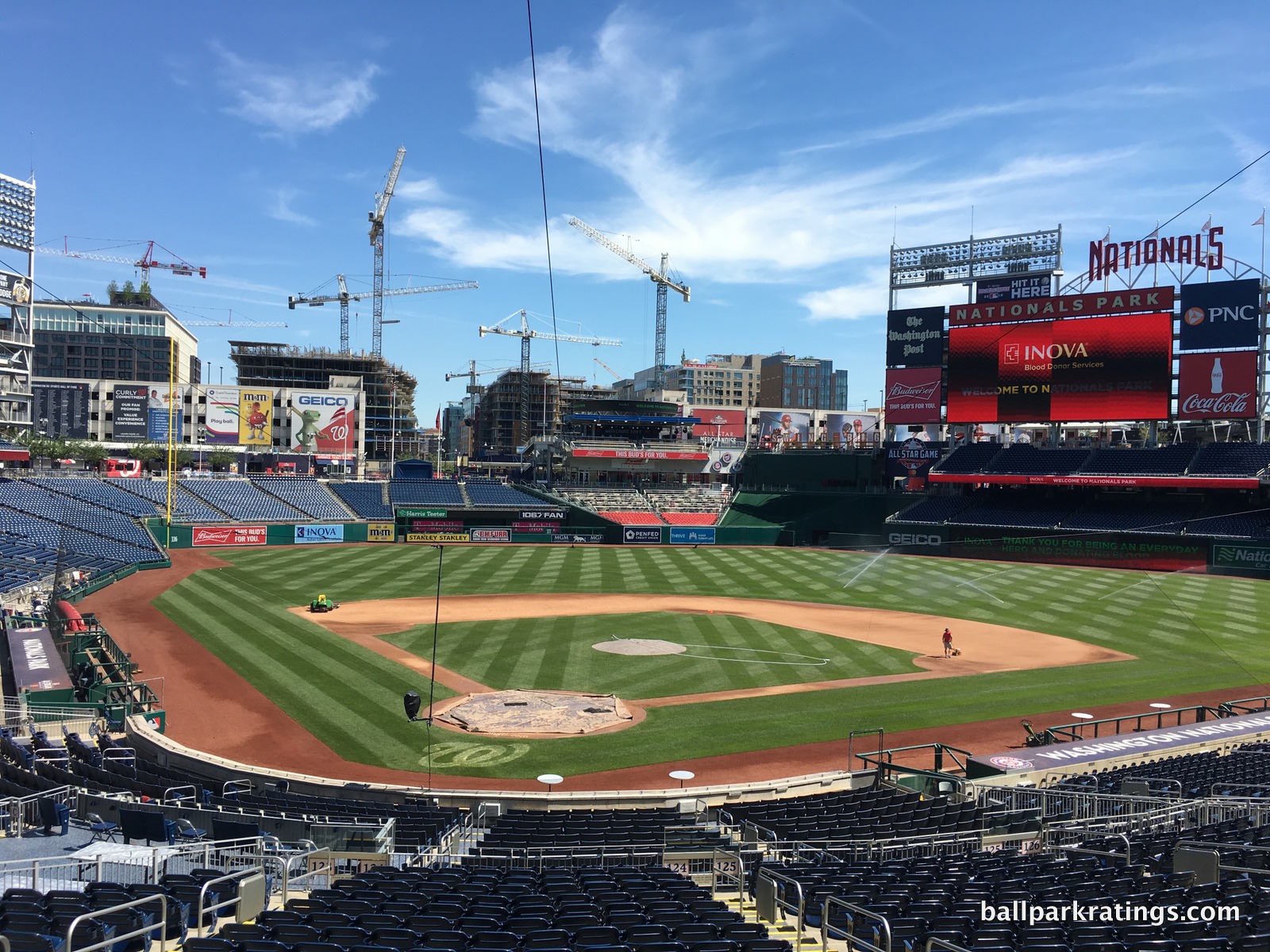
Score: 3.5/5
Concourses:
My standards have never been very high here, and there isn’t much variation. Note this doesn’t account for the functionality of the concourse or any memorabilia/amenities on the concourse, just the appearance. Most parks get a 2 or a 2.5, with a 3 reserved for parks like Petco with scenic landscaping or some other outstanding aesthetic feature. 1-1.5s are allotted to the few inadequate stadiums or to the parks that look like actual malls.
While Nationals Park’s concourse aesthetics don’t fall to the latter level, I’ve always felt they are unusually bland. Basically, if the concourses tastefully “look like a ballpark,” that usually earns my reserved acclaim.

Take Philadelphia’s Citizens Bank Park again, since it’s so similar. Adorned with maroon iron and brick facades, it’s decidedly both warm and industrial. It screams “ballpark” and “Philadelphia.”
For whatever reason, Nationals Park’s concourse aesthetics consist of white and brown concrete squares, unvarnished white steel beams, and oddly anachronistic neon signage. The latter looks like something from 1998, not 2008. In addition, Nationals Park doesn’t have the spacious vaulted ceilings of some other nice concourse systems, which makes it a little less attractive.
For some reason, they painted the floors red sometime in the mid-2010s. I think that may have made things worse!
The saving grace are the aesthetics of the left-center field plaza. It looks beautiful at night with hanging lights as you exit the park.
Score: 2/3
Total: 22/33
Functionality & Essentials
Sightlines:
As most ballpark enthusiasts and die-hard baseball fans know, the new generation of ballparks have actually pushed the average fan farther away from the action. Some of the post-1990 ballparks were slight improvements from the concrete cookie-cutters in this respect, but many possessed upper decks just as far removed as their multi-purpose predecessors, debunking the “retro ballparks are more intimate” myth. And the classic jewel-box parks (think Tiger Stadium) were obviously far superior, placing the upper deck right on top of the field.
This is generally common knowledge among readers, and I grade the sightlines section for these modern ballparks on a generous curve. This is primarily a comparative exercise among post-1990 stadiums.
While I wouldn’t call Nationals Park’s sightlines bad because of the excellent seating geometry, Washington’s baseball stadium features upper level seating far removed from the playing field, even for a new park. Perhaps only Miller Park (Milwaukee), the Ballpark in Arlington, the White Sox park, and maybe Yankee Stadium are worse in terms of field proximity. I generally measure “field proximity” by how close (horizontally) the upper levels are to the field, not by how low.
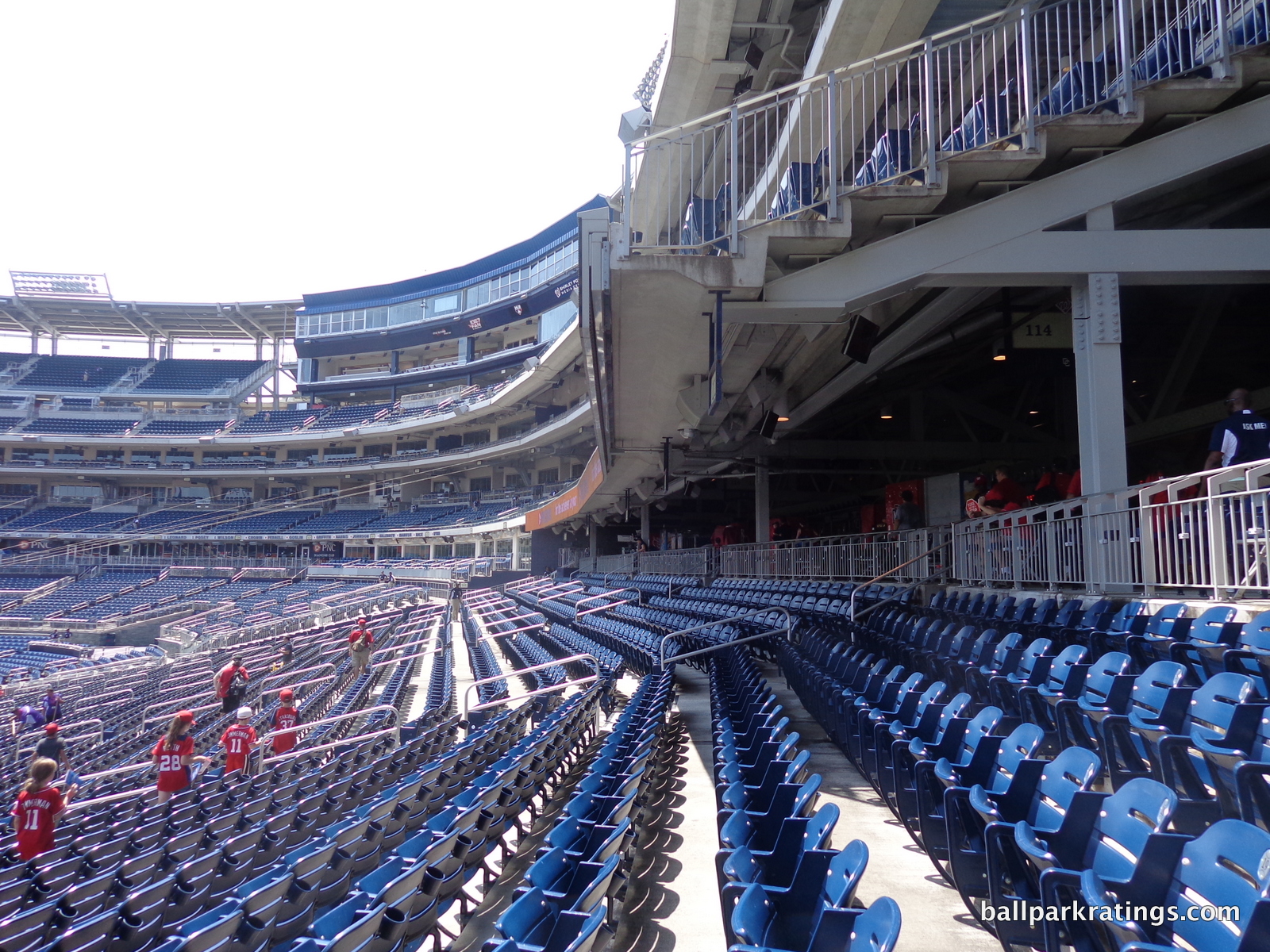
Nearly every modern-day ballpark uses some variation of the lower-club-suite-upper level formula. The club level, or mezzanine, is cantilevered over the lower bowl to varying degrees, usually about 10-15 rows. In the best-case scenario, the upper level is almost completely cantilevered above the club level as well.
Nationals Park uses this formula, but the entire structure is pushed back, with little to no overhang. The club level only covers 2-3 rows of the lower bowl, and the upper deck is not well-cantilevered above the club level either. If you are sitting in the first row of the upper deck, you are 15 rows further removed from the action compared to a more superior modern-day setup, like at, say, Marlins Park.
The benefit of not cantilevering the mezzanine 12 rows or so above the lower bowl is that the seating structure as a whole is lower than you might think for a ballpark using this ubiquitous stacked seating formula. The architects don’t have to raise the upper decks higher to account for overhang obstructions below. Regardless, I’d rather be closer (horizontally) and higher than farther back and lower.
Still, because of the addition of that extra suite level, the park is pretty darn high by default compared to modern ballparks that didn’t incorporate a separate suite level. Not only does it fall behind obviously superior decking structures in San Diego, Miami, and Pittsburgh (and that’s a different animal), but it also falls behind other parks that use the standard lower-club-suite-upper level formula.
Washington’s ballpark also holds the dubious distinction of having an upper deck that is both farther back and higher than its supposedly cavernous predecessor. This has long been suspected to be the case with other retro ballpark compared to their multi-purpose stadiums, but it is clearly so in D.C.
I’m not sure why this is the case at Nationals Park. Few post-1990 ballparks excel compared to historical standards, but the decks are particularly pushed back here. Perhaps there was stronger than usual fan input about not wanting overhang obstructions above, and/or the upper decks couldn’t be raised higher due to site restrictions.
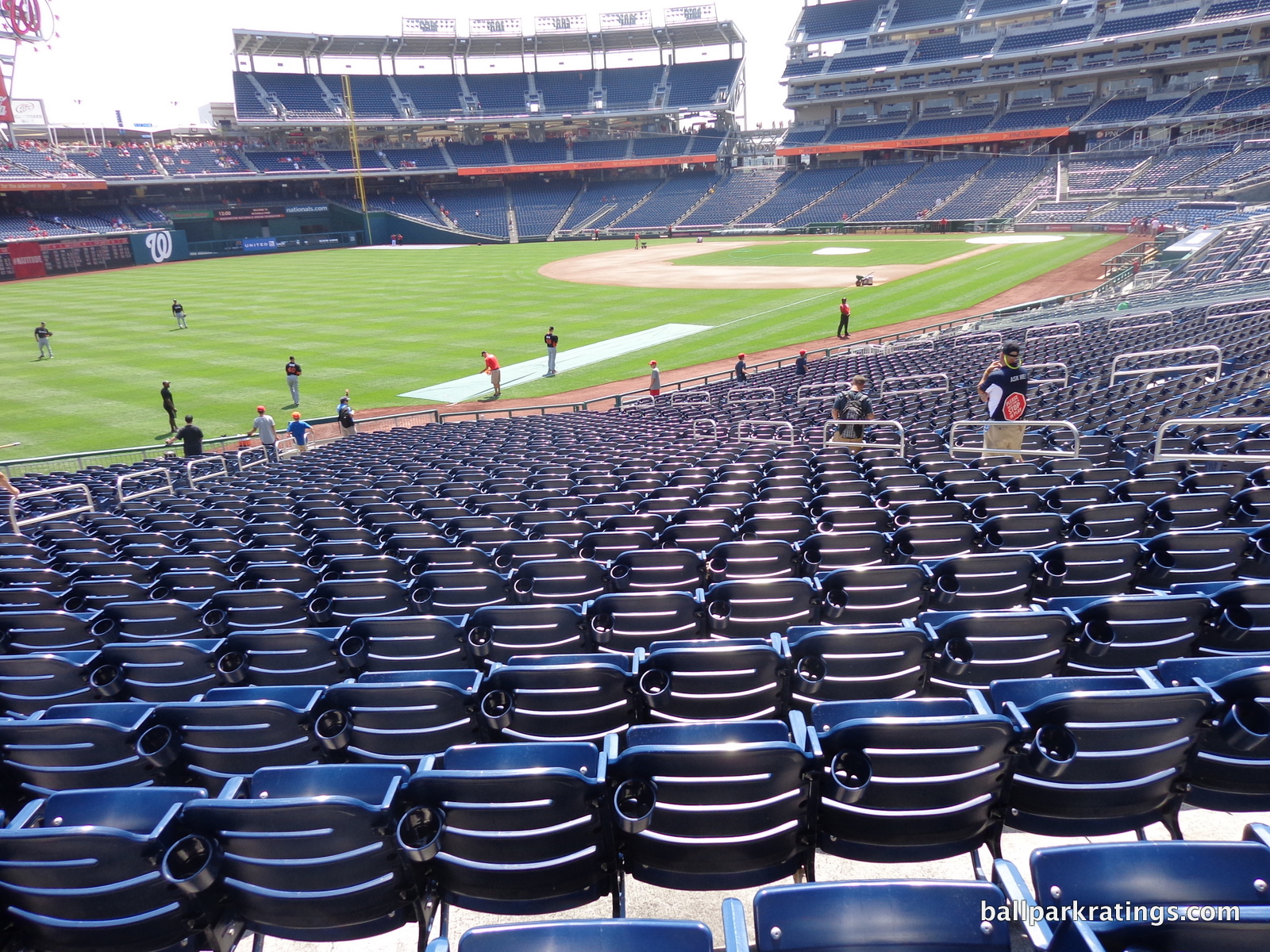
As an aside, like in Philadelphia and Detroit, it was to the park’s functional benefit to break up the right-field upper deck grandstand to allow it to be 25 feet closer to the action.
Despite all of this, Nationals Park’s sightlines are average to above-average in the aggregate due to excellent seating geometry.
In contrast to the earlier retro parks (and the classics, for that matter), all seats down the lines are properly oriented toward the infield. Compare this to the mess at Camden Yards where seats in the corner face centerfield.
Ballpark aficionados love to talk about the virtues of having upper levels close to the action, but getting the seating angles right is just as essential, if not more essential. It’s not fun being one of the 5,000+ ticket holders down the lines at Fenway or Camden and having to strain your neck the entire time.
Score: 8/10
Seat Comfort:
Nationals Park’s seats are as standard as they come. Like most other post-1990 ballparks, they’re sufficient in width in the premium areas and the lower deck, while being too tight compared to historical standards in the upper decks. It’s been completely lost that older parks like Candlestick and RFK Stadium featured 20-21 inch seats throughout the seating bowl, while 18-19 inch seats fill out the cheap areas in “new” ballparks. Average modern-day ballparks get a 3.5 here.
I give Nats’ park a slight boost because 20 inch seats fill out a larger proportion of the cheap seats than usual. Along with the premium seats, the center field reserved seats in the outfield are also padded.
All seats have cup holders, and bleachers are absent at Nationals Park. The Delta Sky360 Club seats are padded theatre-style, while the PNC Diamond Club and the Norfolk Southern Club have fully padded bottoms.
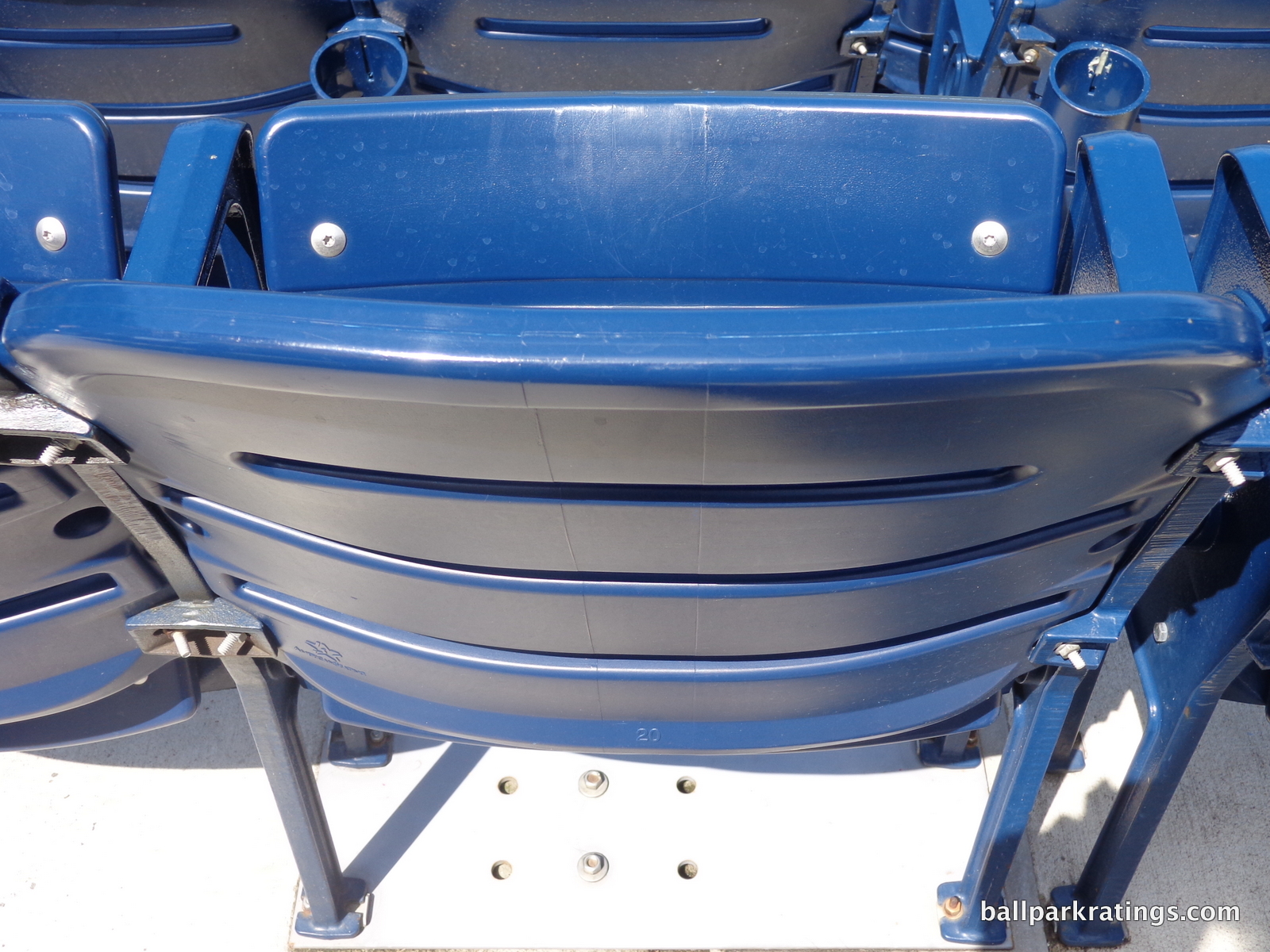
Score: 4/5
Concourses:
Right in line with almost every park that opened after 2006, Nationals Park’s concourse system is state-of the-art. Wide, open concourses have been commonplace in Major League Baseball since 1995, but Nationals Park continued the trend started by Citizens Bank Park that encouraged fans to “hang out” and walk around during the game.
Openness is one of the central themes of Nationals Park, and that’s most apparent strolling through the concourses. The concourse itself exceeds standards in width and features good visibility of the field, the low ceilings notwithstanding. All entrances except the first base gate are at street level, meaning the transition from street to ballpark is seamless.
While above street level entrances are usually an inconvenience, the first base gate actually functions as a welcome change of pace in this instance. It aligns with the wide right field grandstand gap that showcases Washington Monument views, so after climbing the exterior staircase, you really get a heightened visual connection through a “compress and release” sensation.
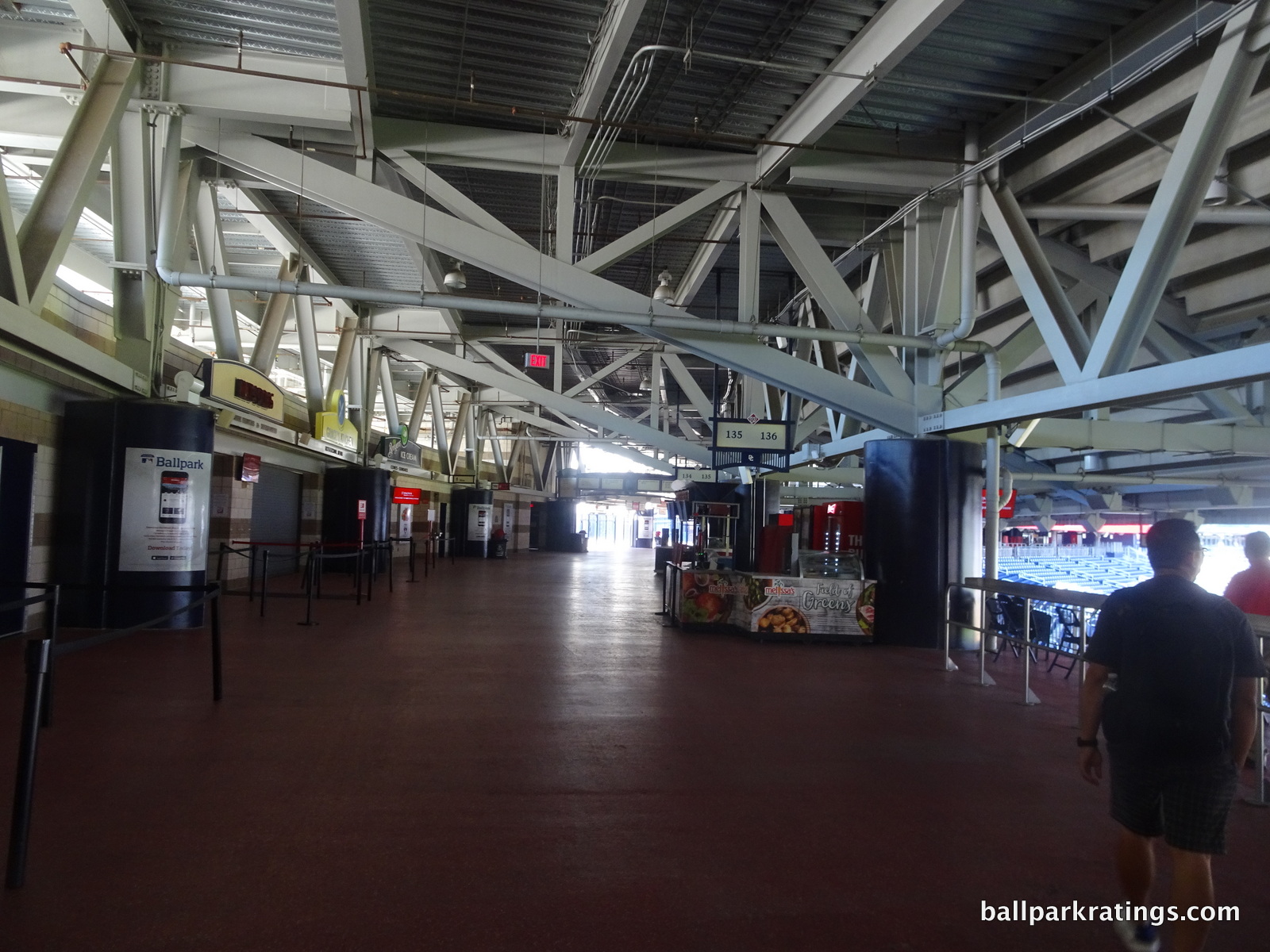
Nationals Park has no vertical or horizontal discontinuities on the main concourse when transitioning from area-to-area, unlike a fairly high number of post-1990 ballparks (Petco being the worst offender, for example). Everything is intuitively straight-forward and fan friendly.
The park doesn’t seem to have as many dedicated standing-room areas in the outfield as parks like Safeco or Citizens Bank, but that doesn’t mean there aren’t plenty of neat perches. Except for behind the Brewhouse and the Batters’ Eye, everything is open to the field. Interesting outfield vantage points from the concourses include spots above the batters’ eye and beneath the scoreboard. Coming from the left-center field plaza, spaces underneath the cherry trees are also prime.
Like the majority of ballparks, the view from the main concourse behind home plate is blocked, in this case by suites and the PNC Diamond Club. This is generally seen as a necessary evil to accommodate premium seating (or press boxes), but that is part of what separates Nationals Park from the nearly perfect systems in Seattle and Philadelphia, where views from the concourses are unobstructed almost at all points.
There have also been some issues with congestion in the plaza. The team anticipated that the majority of fans would enter and exit through these gates, but the volume has been even higher than expected.

Transitioning to the upper deck, Nationals Park follows Philadelphia in featuring an open concourse throughout the upper deck. Commonly called a “split upper deck” by ballpark enthusiasts, this has been a point of contention. The chief complaint is that this pushes the upper part of the upper deck higher, although it doesn’t have to be farther from the field if the upper part is cantilevered over the lower part. It’s also derided as an obvious method of increasing the prices of the lower part of the upper deck.
I mostly like the split upper deck. It is true that you can’t really see the field from the concourses, but the openness is nice. The upper deck also features drink rails on the concourse above the seating, and you can see the game from there.
Overall, Nationals Park features one of the best concourses in the game from a functional standpoint.
Score: 6.5/7
Scoreboard System:
Nationals Park really provides an instructive touchpoint on just how much technology and expectations for videoboards have evolved in the past ten years.
When it opened in 2008, people often said the park’s video system was an outstanding feature in an otherwise generic park. Measuring at 47 feet high and 101 feet across, the high definition screen was billed among the nation’s largest. It was in the top three at the time, with only Kansas City and Arizona’s videoboard (both also added in 2008) outsizing it.
Today, only ten years later, it places as the 20th largest, in the bottom ten! Note that since the Chicago Tribune report, new larger videoboards have been installed in Colorado and Anaheim.
Of course, Nationals Park’s videoboard is fine. We’re at a point of diminishing marginal returns as most of these boards are big enough. The size and technology are more than adequate.
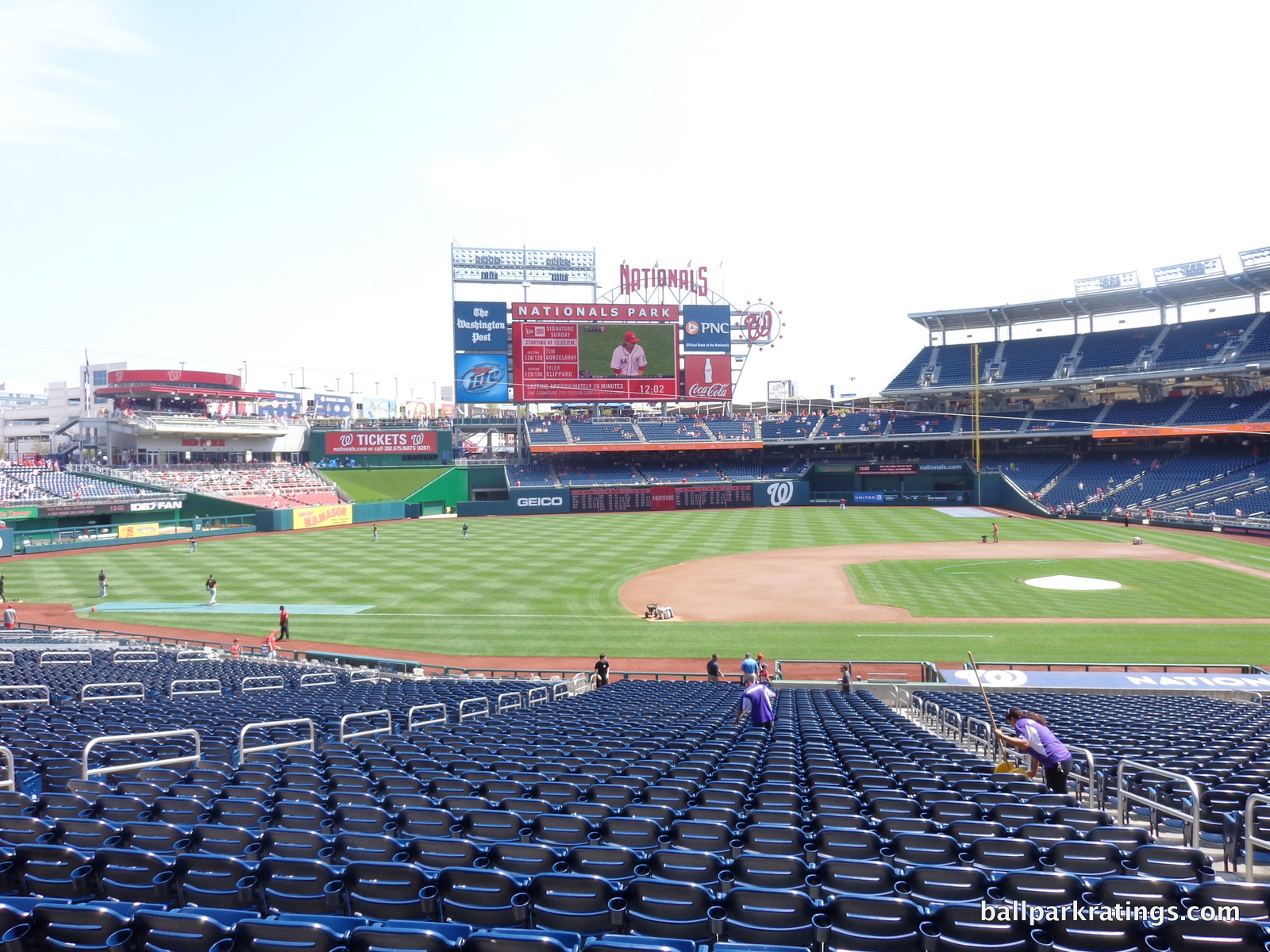
Score: 2/3
Total: 20.5/25
Amenities & Features
Quality and Selection of Concessions:
Making an adequate effort to reflect the international cuisine of Washington, D.C., Nationals Park covers all the bases with an impressive variety of food and beverage options with mostly good quality. The concessions don’t have the dazzling character of those in San Francisco, Seattle, San Diego, or New York, but they are some of the best in the majors.
Taking a page from Citi Field, Nationals Park really made the leap with the addition of concessions from Danny Meyer’s Union Hospitality Group in 2011. Most of the other food is imported from local eateries as well.
With three different brands of BBQ, Nationals Park excels in bringing a taste of southern fare into the ballpark. Most notable is Meyer’s Blue Smoke. Inspired by the flagship restaurants in Manhattan, the stand serves authentic pit barbeque that takes cues from St. Louis, Kansas City, Memphis, North Carolina, and Texas. The menu includes Kansas City spare ribs, chipotle chicken wings, pulled pork, fried chicken, and Memphis-style all-beef bologna sandwiches.
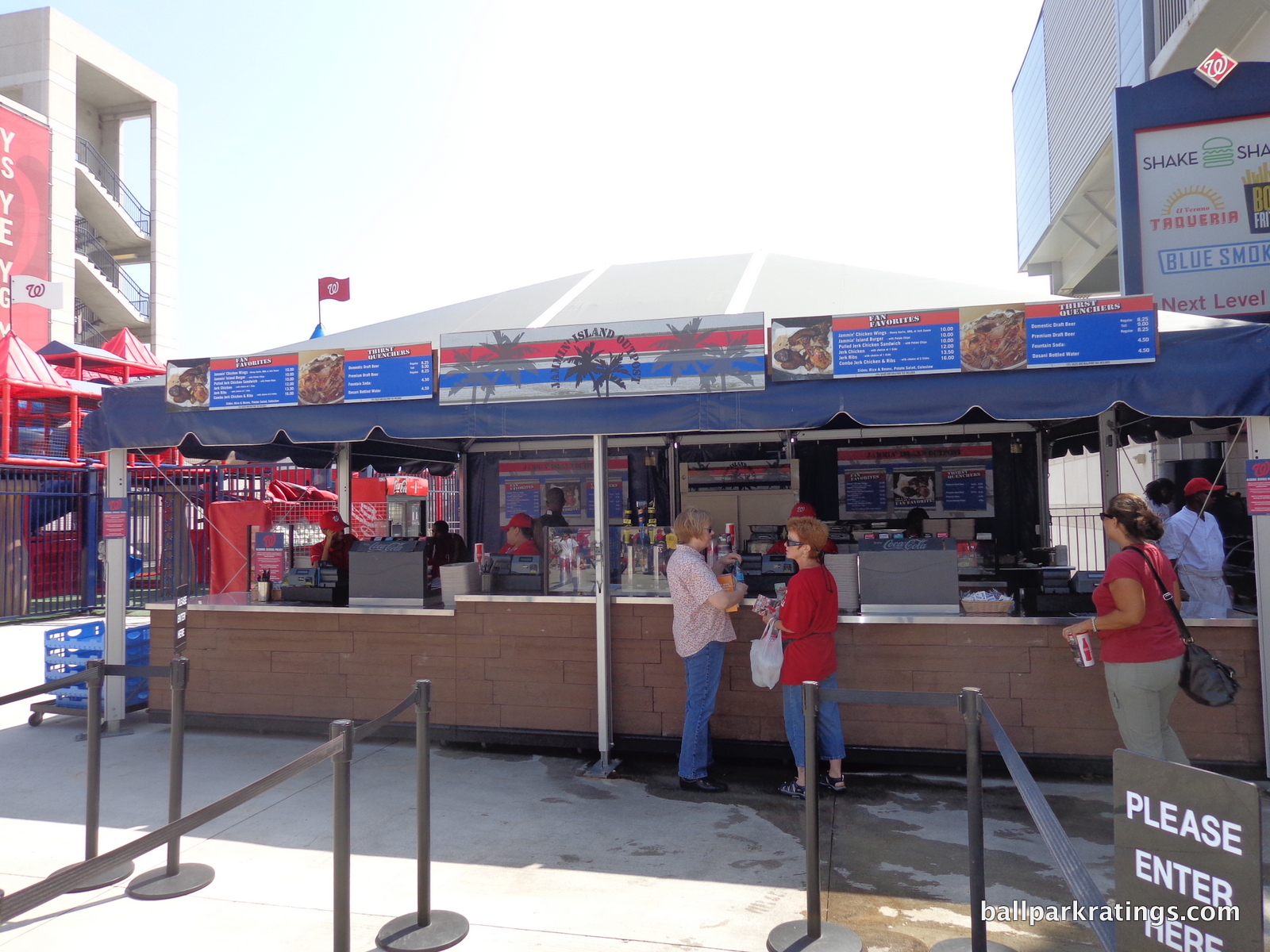
Going to more local options, Top Chef alum Mike Isabella’s Old Hickory BBQ has a noticeable presence in the ballpark. Standard barbeque fare, such as beef brisket, pulled pork, and BBQ nachos are available. Finally, Washington’s Jammin Island BBQ has an outpost serving its signature Jamaican jerk chicken and ribs.
Nationals Park has a decent variety of Mexican cuisine. Meyer’s El Verano Taqueria has probably received the most lukewarm reception out of all of his brands at both Citi Field and Nationals Park. While the portions are smaller than you might expect, the menu features flavorful items made from fresh, high quality ingredients. Tacos, quesadillas, and nachos are available. In the right field corner, Nationals Park also features a generic burrito stand.
Meyer’s presence is most notably felt through the renowned Shake Shack, the popular fast casual burger joint. Citi Field and Minute Maid Park (Houston) are the only other ballparks to have Shake Shack. Billed as one of the best burger chains in the country, cheeseburgers, crinkle fries, hot dogs, frozen custard, and some of the industry’s best milkshakes are available. Located behind the scoreboard, be prepared for long lines, as this is one of the most popular stands in the ballpark.
Union Hospitality Group also has a Box Frites stand at the ballpark, featuring thick-cut Idaho potato fries with a variety of dipping sauces. They also have mixed berry and apple fried pies.
If you are craving seafood, Nationals Park has you covered too. Chesapeake Crab Cake Company serves its crab cakes, crab grilled cheese, and chips with queso crab dip. If you want sushi, that is only available on the club level (Norfolk Southern Club) as of 2018. Field of Greens has the healthy fare.
Nationals Park really starts to shine in showcasing a unique array of more exotic international foods. It’s a pretty unique presentation.
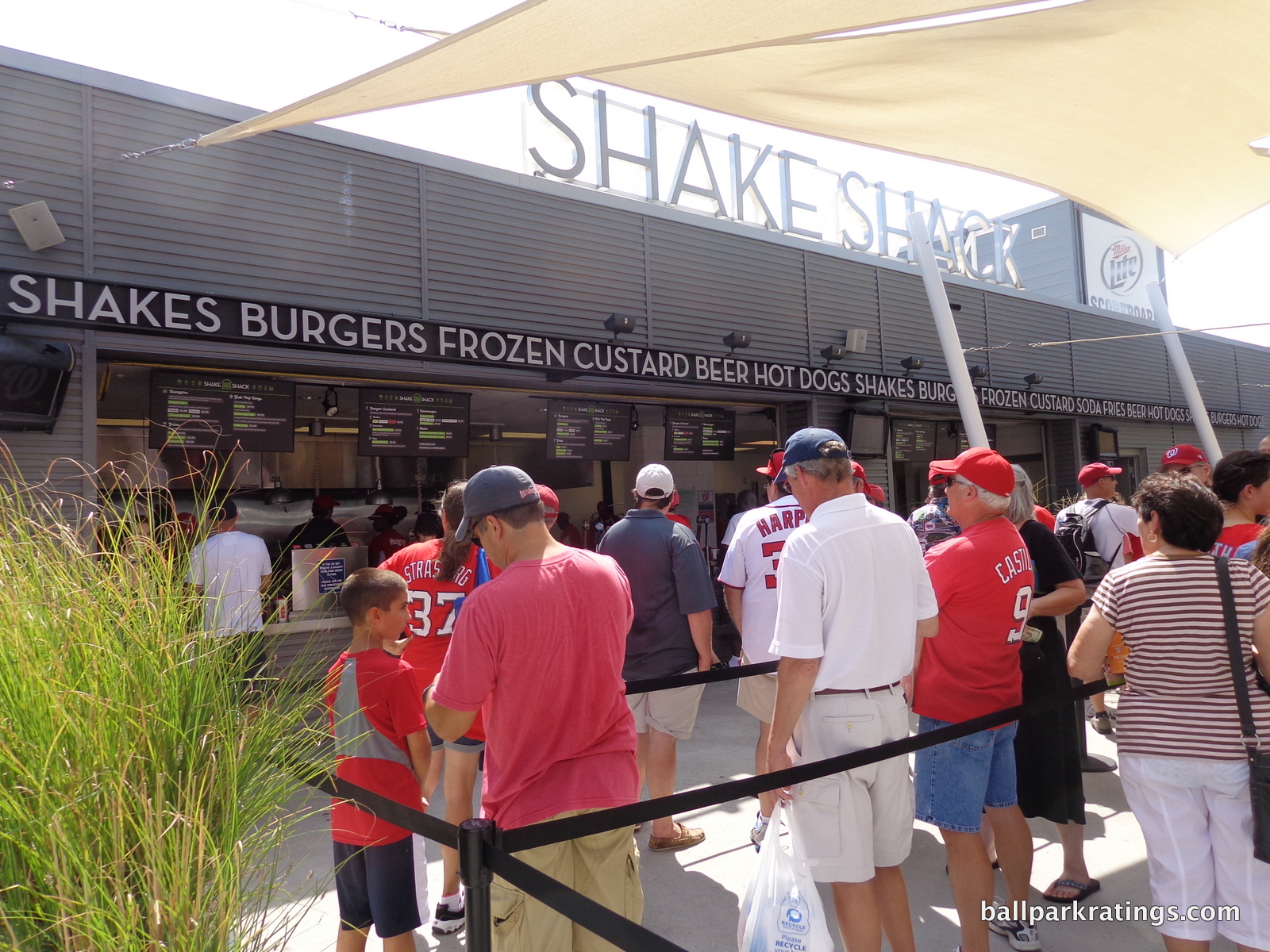
The Street Skewers features assorted kebabs inspired by cuisine from around the world. With a rotating menu, the stand includes Thai, Greek, Mexican, and Chinese. The Greek fare includes meatballs made with beef, pork, and lamb, seasoned with garlic and mint, and drizzled with tangy tzatziki sauce. You can also get grilled chicken souvlaki with peppers and tzatziki sauce. The vegetarian selection includes halloumi cheese, onion, peppers, and squash.
Nationals Park is one of the few ballparks to have a kosher concession stand. Under the supervision of the Rabbinical Council of Greater Washington, the stand has kosher hot dogs, falafels, schwarmas, and knish.
Grace’s Kitchen—which has an interesting backstory—serves meatball sandwiches, quinoa, cauliflower rice, and Bloody Marys from local restaurants.
Other notable local/chain eateries at Nationals Park include District Donuts, Dolci Gelati, Enzo’s Pizza, Leilani’s Shave Ice, and of course, Ben’s Chili Bowl, which I’ll save for below. Overall, Nationals Park earns high marks for its great quality and selection of concessions.
Score: 5/5
Regional/Signature Concession(s):
With so many wonderful, high-quality regional eateries sweeping into our nation’s ballpark throughout this decade, this category has become somewhat redundant.
In the mid-2000s, even the best ballparks for food would feature concessions mostly run by food service corporations like Aramark, while featuring a few standout items that would garner praise. Today, the fare served at the country’s best foodie ballparks almost exclusively come from high-quality, local eateries.
That is mostly true of Nationals Park, as the majority of stands are either run by regional eateries or by the higher-quality (compared to the usual food service corporation) Union Hospitality Group. But an unintended consequence of that is the loss of a ballpark’s one and only, tried and true, “signature food item,” as everything is so distinctive, local, and high quality.
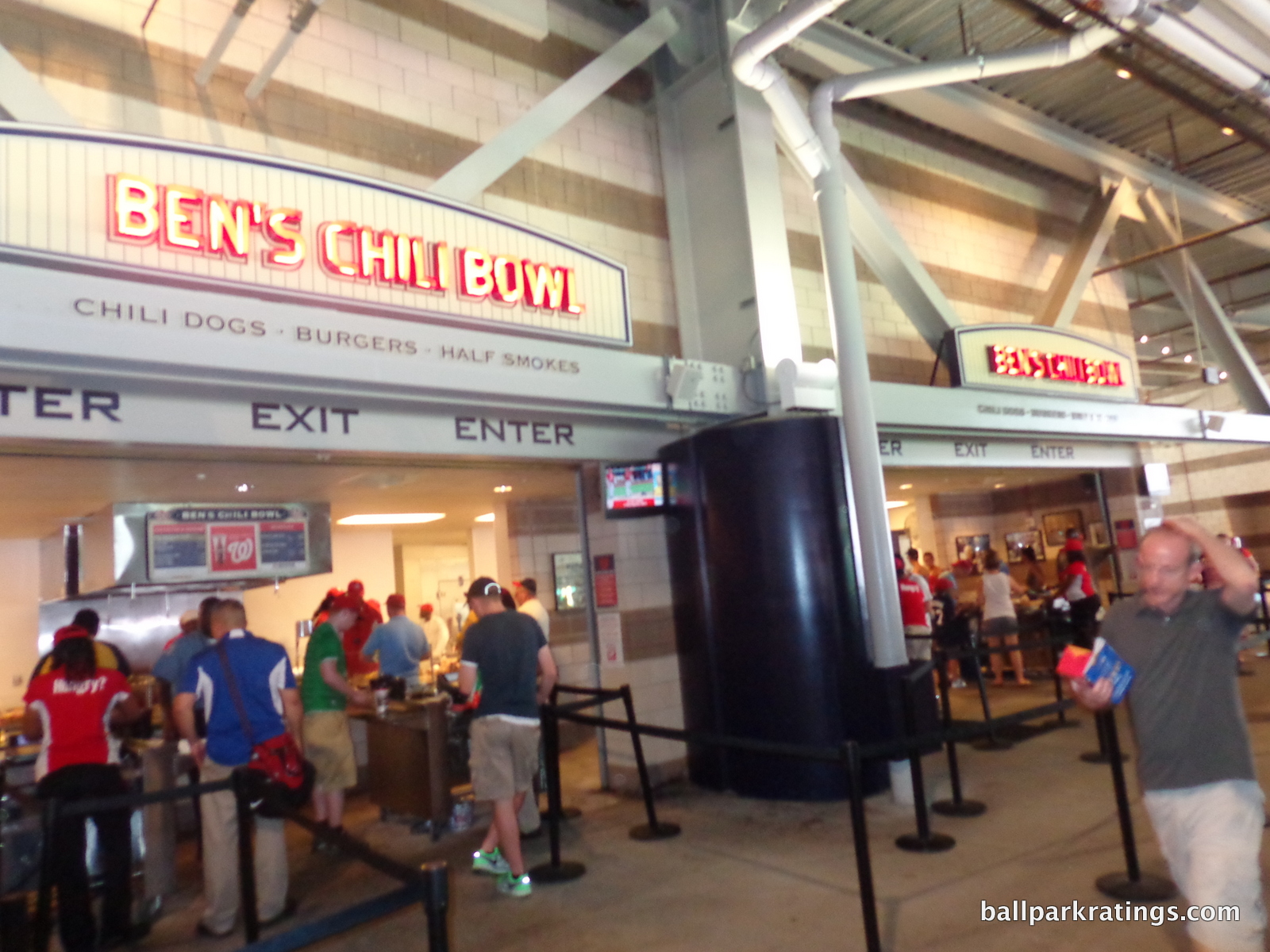
This is not the case with Nationals Park, as Ben’s Chili Bowl stands head and shoulders above the rest, in what may be the best signature food in baseball.
Why? For one, it is a national landmark and an integral part of northwest D.C.
Ben’s Chili Bowl has a rich history and national popular culture recognition. This is a place frequented by Jazz greats, protesters during the 1968 riots, various celebrities, local politicians, and United States presidents.
Second, Nationals Park is only Ben’s Chili Bowl’s second location, which makes it all the more special. Other MLB ballparks may integrate famous local chains to give the park a regional flare (think Cincinnati’s Skyline Chili), but Nationals Park brings in the area’s one and only landmark restaurant.
Oh, and the food is pretty good too. The “half-smoke” is the must-try item. A Washington D.C. sausage delicacy, the half-smoke is similar to a hot dog, but is bigger and spicier and smoked with herbs, onion, and chili sauce.
Score: 2/2
Accessible Restaurants/Bars/Sitting Areas/Social Spaces:
While there’s no definitive starting point for the trend, the design of Nationals Park reflected the beginning of an emphasis on livelier social spaces compared to static, full-service restaurants. You even see this with the evolution of Nationals Park’s own outfield restaurant in 2018 compared to 2008.
In the 90s and early 2000s, it was fairly standard for a team to carry one or two full-service restaurants where fans would get a full, 30-minute dining experience, in addition to a traditional white table cloth “stadium club” restaurant. By the mid 2000s, teams realized there just isn’t a big market for that. Fans would rather go to dynamic bars and fast-casual eateries and then take a seat at their leisure. I think it’s a big mistake to go as far as Marlins Park (with no accessible restaurants or sit-down bars), but this is where the trend is going.
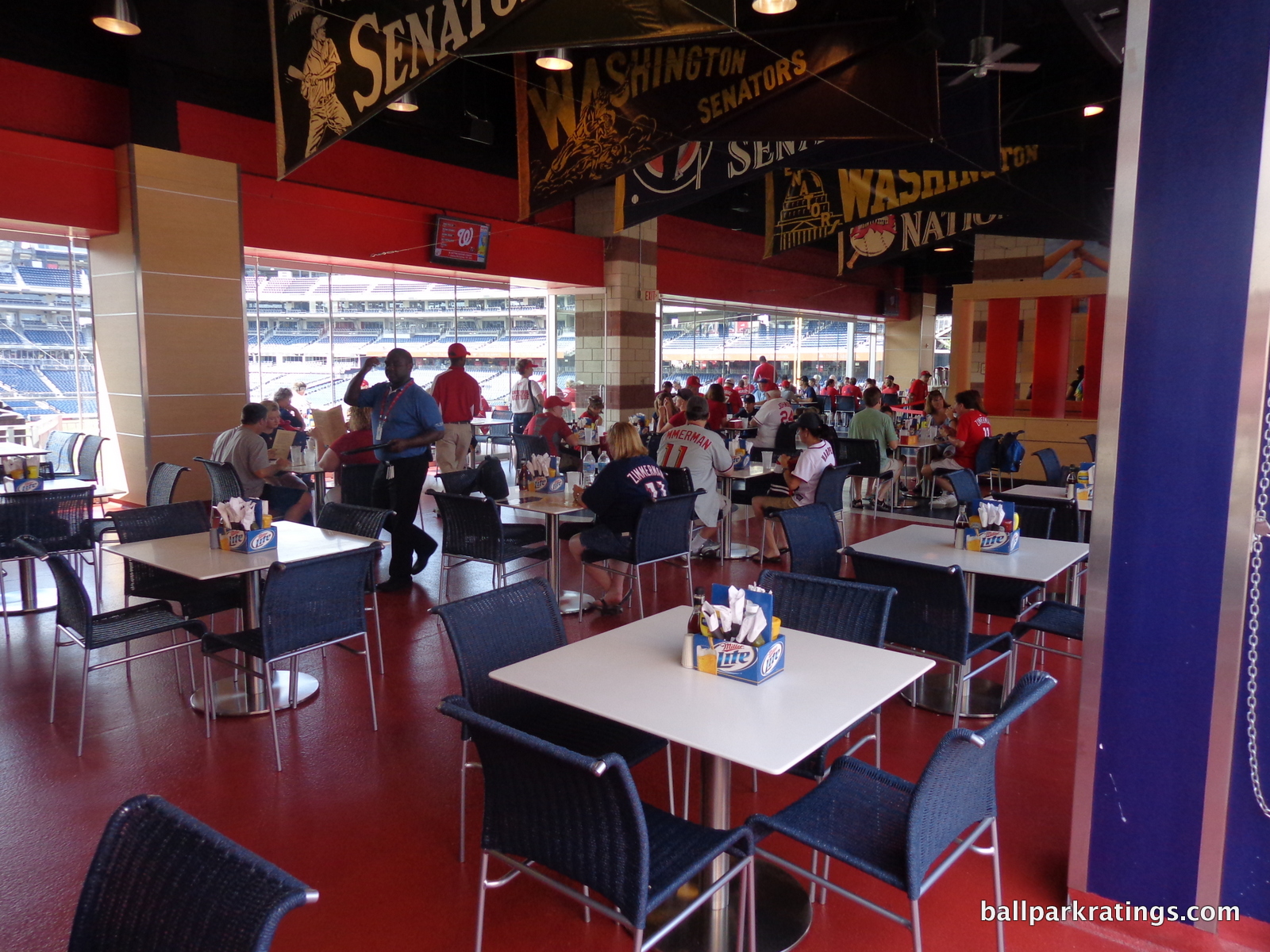
Formerly known as the Red Porch restaurant, the Budweiser Brewhouse still features a full-dining experience with great field views, but you can walk up and stand around the bar as well. The menu serves pub-style fare such as wings, quesadillas, pulled-pork sandwiches, Reubens, pizza, and mahi-mahi fish tacos.
The Budweiser Brewhouse’s decor has a distinct Washington baseball theme to it, framed by the Nationals flooring below and the Senators banners above. It used to have some nice wicker lounge seating on the concourse side of the patio, but that has all been replaced by circular walk-up tables to better accommodate multitudes of standing drinkers. This reflects the social space trend.
The restaurant originally didn’t have any outdoor tables. Throughout this decade, the Nationals have replaced the “center field lounge” seating with outdoor dining spots. The full-service table seating is first-come, first-serve, including the prime outdoor tables above the red seats. These are some of the best dining tables in baseball, as some similar setups in the MLB are often reserved for groups or ticketholders only.
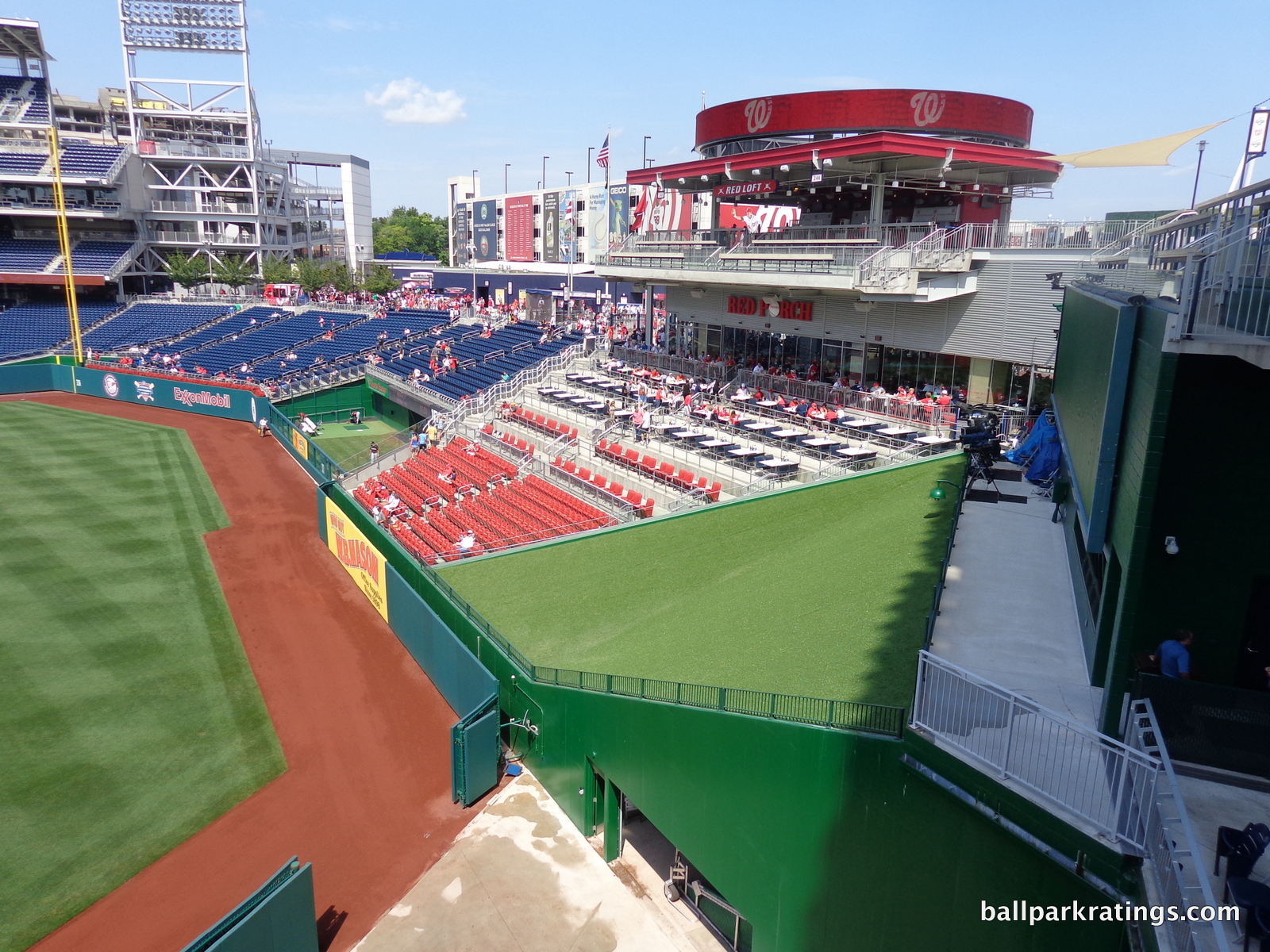
I appreciate that the Nationals have maintained their full-service dining space. Other ballparks, such as Minute Maid Park (Houston) and Kauffman Stadium (Kansas City), have recently turned everything into an informal social space where there is little to no seating. Sometimes, it’s nice to sit down at a restaurant before the game and still have a field view. The bar in the restaurant also has seating. Drink specialties include their “three strikes flight.”
Located on top of the Brewhouse at mezzanine level, the Bud Light Loft is the one of the park’s two true social spaces. Featuring great happy hour deals and an elevated view of the field on one side and the surrounding development on the other, the loft is a lively place to hang out before and during the game. The loft features tiered standing room spaces with drink rails, wicker lounge seating, circular walk-up tables, and a built-in bar. The space can get a bit crowded.
Heading right on the right field mezzanine, fans will encounter the Budweiser Terrace (the Budweiser branding has confused things here) underneath the scoreboard. Better known as the “Scoreboard Walk”, this is the quintessential modern-day ballpark social space. The area features a large walk-up bar, comfortable lounge seating, chairs and tables for eating, and the some of the best concessions the ballpark has to offer, including Shake Shack. Framed by the hanging lights similar to those seen in the center field plaza, this place is hopping at night. Prime field views are underneath the scoreboard as well.
I’m pleased that most of the spaces featuring field views from the outfield are open to all ticket-holders. At other parks, these are often available to large groups or parties. Spaces inside the garages are reserved for groups. The only prime space designated as a “hospitality area” is the tiered seating above the batters’ eye.
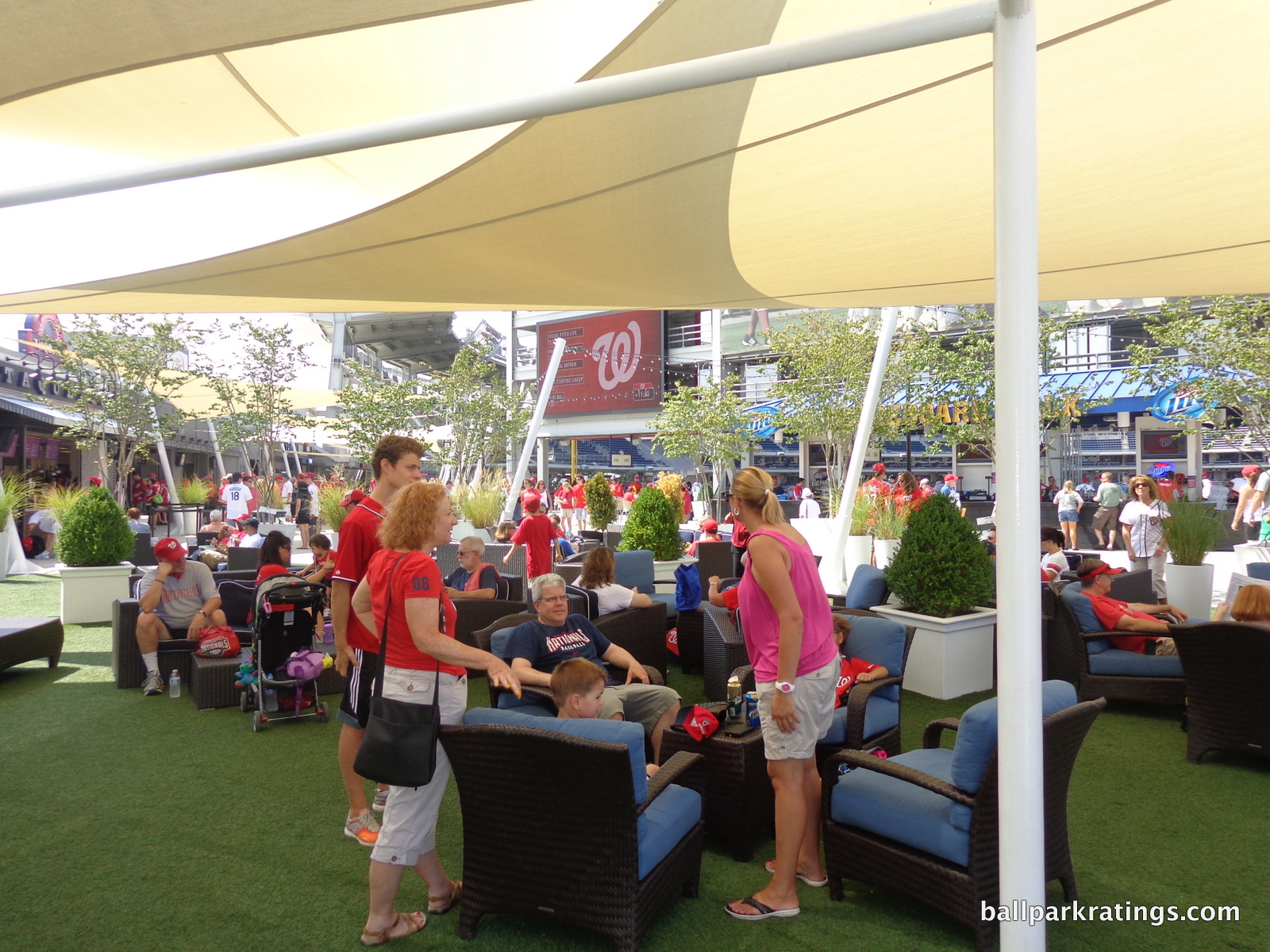
What I don’t like about the presentation is all of these destinations are essentially confined to one area of the ballpark. Walking around the main concourse around the infield, there aren’t many places to hang out or sit down. It is all in the outfield. This isn’t too unusual, but parks that score great in this category (Detroit, Denver, San Diego, Minnesota, for example) seem to have a significant point of interest at every corner. The Nationals would also benefit from adding simple places to sit down on the main concourse.
Like the majority of ballparks, Nationals Park lacks any sit-down bars or social spaces in the upper deck. If you have a ticket in the nosebleeds, you have to trek all the way down to the main concourse to seek a climate-controlled refuge or look for a place to hang-out and get a drink. This is a relatively minor inconvenience, but again, it is something that separates each of the four parks above from most others.
Overall, Nationals Park scores well in a crowded landscape of ballparks really stepping up their game in this category. I just wish there was more activity for the average fan on the main concourse around the infield and in the upper deck.
Score: 4/5
Premium Seating/Clubs:
Upon opening in 2008, Nationals Park represented a substantial step forward for ballpark premium seating, perhaps unsurprising given the well-endowed market and the park’s reputation of favoring economics over aesthetics.
Throughout the 2000s, we saw parks: (a) gradually increase the quality and placement of their luxury suites, (b) make their mezzanine club levels more exclusive and less generalized to the seating bowl, and most importantly, (c) build ultra-exclusive field level clubs behind home plate.
Nationals Park amplified all those aspects to extreme proportions. Constructed in pre-’08 recessionary times, the Nationals were very ambitious in this respect, even originally labeling and pricing the red seats as “center field club seats.”
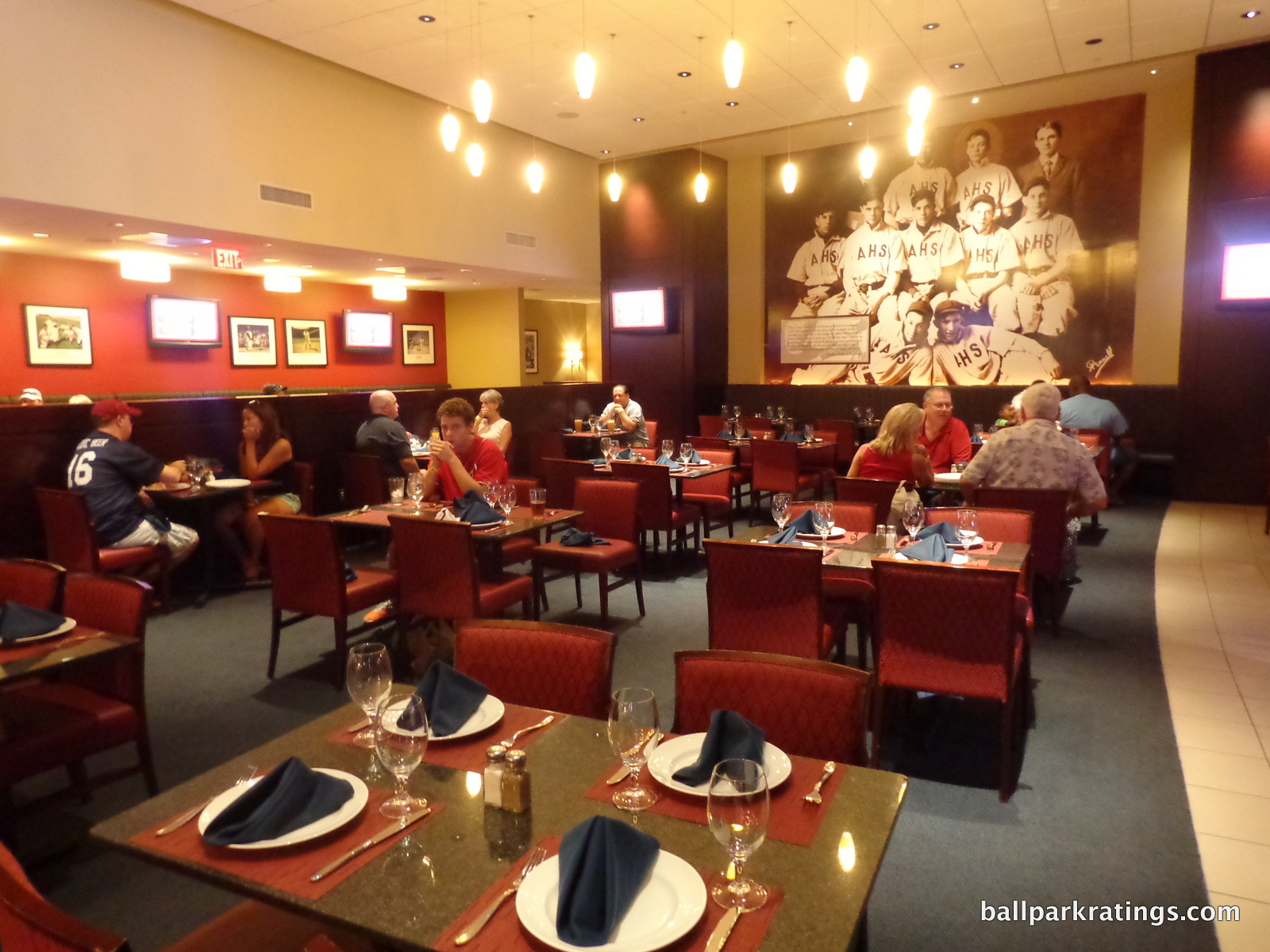
While that was obviously ridiculous and didn’t last, the premium seating model stands up very well today, in what is the template for a new ballpark in a large market. The starting format today is two tiers of ultra-premium club seating in the lower bowl behind home plate, followed by a mezzanine club only centered around home plate and a small number of well-placed luxury suites. Nationals Park was only a bit behind the curve by building too many individual luxury suites, even for the D.C. market (79; parks in New York built around 50, Atlanta built 32).
For those who are groaning, it’s worth pointing out that this isn’t much worse for the average fan than it was in the 1990s. Using the traditional suites-everywhere model, Cleveland’s 124 luxury suites separated the average fan from the game in a similar manner, including behind home plate with its bunker suites. If anything, club seating has a more egalitarian look than three tiers of luxury suites.
Occupying 400 or so seats in the first 5 to 11 rows behind home plate, Nationals Park’s most exclusive option is the Delta Sky360 Club, best known by its former pretentious name, the Presidents Club. Since at least 2012, I’ve always tried to get home plate club seats once when I am in town in order to have access to every area in the ballpark. Except for Yankee Stadium, having access to the best club will get you access to the lesser clubs, and my priority is to review and photograph all areas of the ballpark for readers. Ironically, I personally prefer to be a little bit more elevated when watching a baseball game.
I’ve been to most of baseball’s most exclusive clubs, and I think Nationals Park’s Delta Sky360 Club is the best in all of Major League Baseball.
Crafted to cater to Washington’s robust corporate market and political elite, Nationals Park’s Presidents Club (I’m just going to call it that to avoid confusion; Delta has so many sponsorships across baseball) has all of the requisite high-end amenities, with a stunningly well-appointed décor. Fully padded theatre-style seats, in-seat service, all-inclusive gourmet food, non-alcoholic beverages, draft beer, and house wine (no liquor), premium parking, a private entrance, and team batting cages views are part of the club experience.
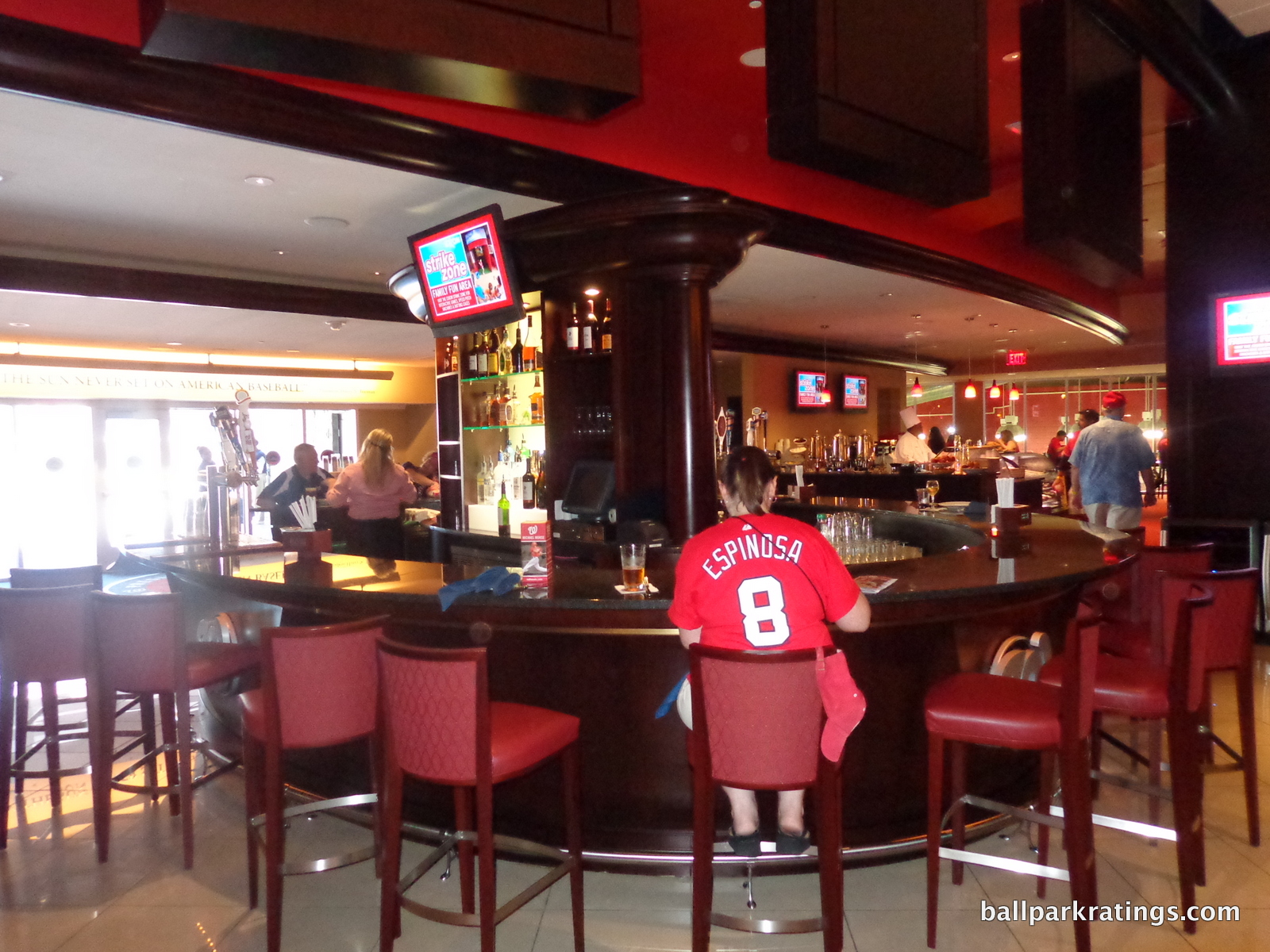
Sophisticated comfort, exceptional service, delectable dining, and top-shelf amenities are all pretty standard for a ballpark home plate club, but the Presidents Club has a number of features that make it stand out.
While such fans have come to expect an upscale décor from such a space, the Presidents Club is truly luxurious, more resembling a dining room at the Ritz Carlton than a dining room at the Embassy Suites. Finishes consist of mahogany, granite, and imported stone. The elegant Oval Office Bar is a true destination as well.
The historical references inside the club are absolutely fabulous. Think pictures of presidents related to baseball, nods to presidents who were notable baseball players, documentation of presidents throwing out the first pitch, and pithy baseball-related quotes from presidents scattered on the walls. The entry hallway of presidential photos sets the scene perfectly.
The left side of the dining room is framed against the backdrop of an enlarged version of Dwight D. Eisenhower’s high school team baseball photograph. The Nationals brought in the old seat from what would become known as RFK Stadium where John F. Kennedy threw out the first pitch. Harry Truman’s quote “May the Sun Never Set on American Baseball” hovers above the portal opening to the field. Just. Perfect.
In contrast to the dark and enclosed bunker clubs across Major League Baseball, the Presidents Club feels open and airy. While the high ceilings play a role, this is primarily a function of the large portal opening onto the field. When inside the club, plenty of natural light seeps in, a rarity for such a space. There is also a terrace outside where fans can stand. Note the egress has bluestone identical to the backstop. Grab-‘n-go stations flank the doors leading out to the terrace.
The food is a step up from other home plate clubs, probably because the Nationals need to differentiate from the upscale all-inclusive Diamond Club above. They have everything you could imagine, including a dedicated dessert and gelato bar, similar to the Legends Suite at Yankee Stadium.
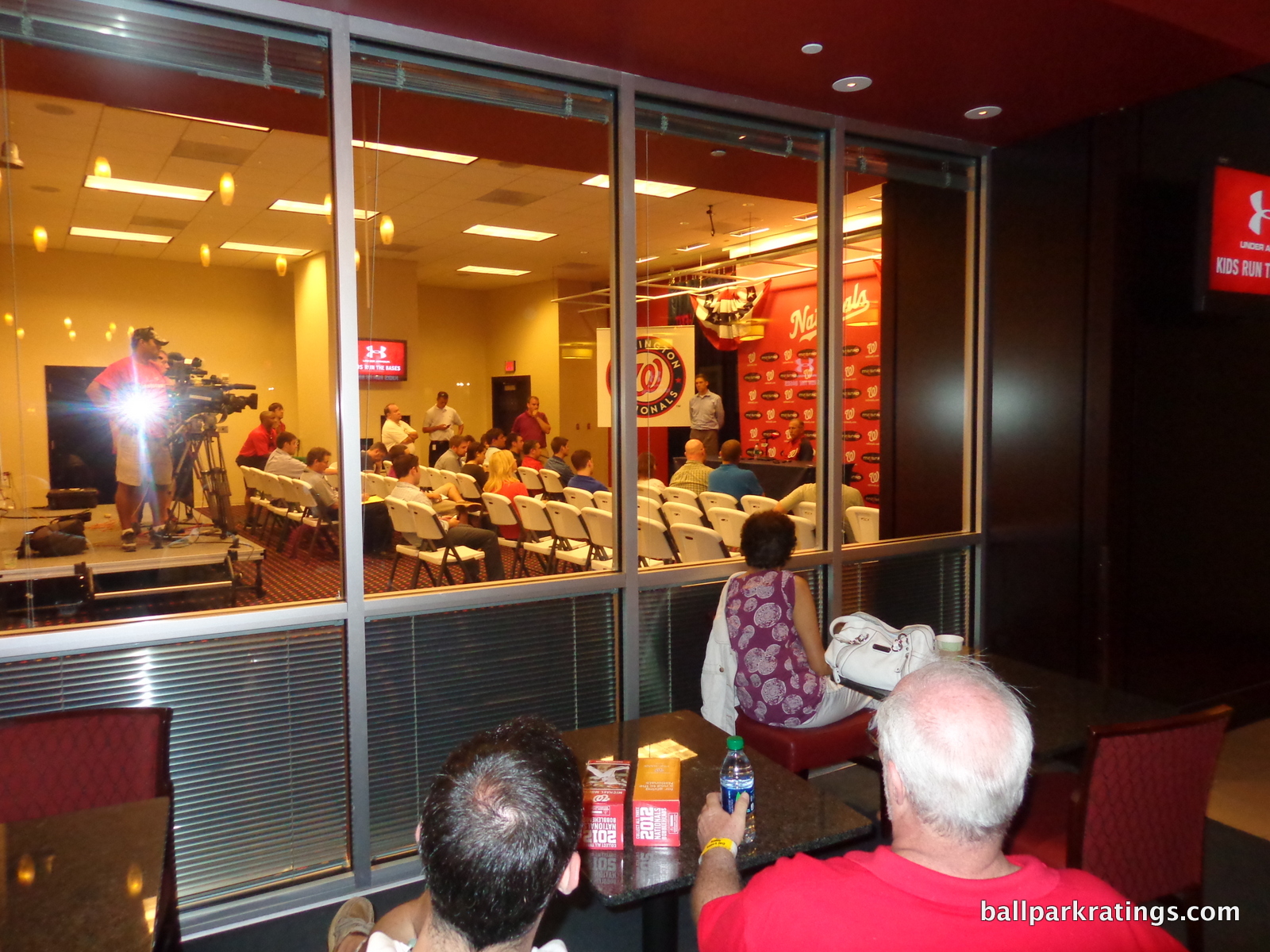
A number of other ballpark clubs have views of batting cages, but Nationals Park is the only one with a direct view of the team postgame press conference. People wondered how this was possible. Now you know. Only at Nationals Park. Alcohol continues to be complimentary until 30 minutes after the game while you watch the press conference, which explains a lot.
Finally, I found the extra random perks to be above and beyond. The Presidents Club has a dedicated mimosa bar on Sundays. Like only a few others in baseball, the club offers private lockers for ticket holders. When that D.C. humidity rolls in on a hot summer day, in-seat servers give out iced towels. In fact, there is an entire basket of iced towels on hot days. Yet another thing I’ve never seen before. Outstanding.
Bottom line: The Delta Sky360 Club (Presidents Club) is one the few, over-the-top corporate ballpark home plate clubs that are worth the price.
Situated above the Delta Club on the main concourse, the 1,000 seat PNC Diamond Club is a decidedly less upscale and less exclusive environment, but actually presents a similar array of amenities.
Oddly, the Diamond Club has been renovated three times in the ballpark’s short history. It started out as a really neat but cramped historical sports bar, but the team found the space too informal. The baseball-themed atmosphere featured museum-quality exhibits. One year after opening, the Nationals renovated the Diamond Club into a more upscale experience, but it was still lacking in space. In fact, the team had to add a makeshift tent area for non-season ticket holders in the club because of issues with crowding. In 2016, the team renovated the club yet again in order to add a second story balcony to ease crowding issues, but it resulted in a space that just looks functional.
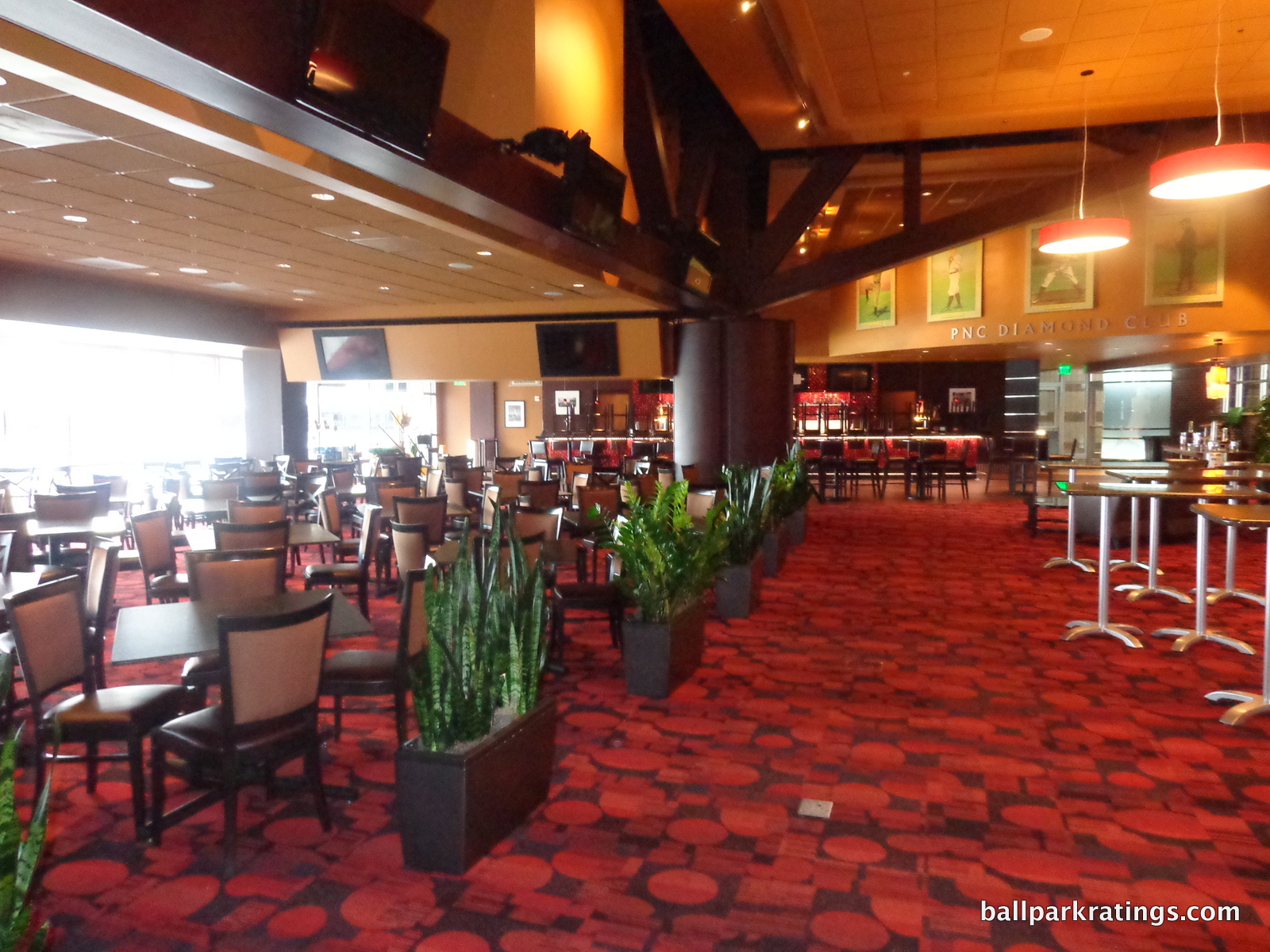
The PNC Diamond Club features an ordinary series of metal chairs and wooden tables, in an effort to effectively accommodate all of the fans in the section. It first lost its charm, then lost its luxury, but it is finally functional, or at least more functional. This wasn’t done properly in the first place because the Diamond Club restaurant and lounge weren’t originally in the budget, and it was only supposed to accommodate around 500 fans.
All of this being said, the bi-level PNC Diamond Club is pretty nice today. It also features all-inclusive food, non-alcoholic beverages, draft beer, and house wine, which is quite generous for the price point. There is a bar and buffet lines on both levels. In-seat service is complimentary, along with premium parking. Seats have fully padded bottoms. Unlike similar secondary clubs in Atlanta and New York, the Diamond Club features a great field view through the glass and a pretty expansive patio with dining tables, similar to the set-up at Angel Stadium. Nationals Park really had the benefit of taking the best from each park in the premium seating category too.
The food is not at the level of the Presidents Club, but still aligns with the experience you would find at any other ballpark home plate premium area. A salad bar, antipasti, rotating specialty regional action station, seafood station (“la mer”), gastropub, carvery station, pizza bar, ballpark food (“game day”), and dessert area are available in the PNC Diamond Club. I don’t have the menu for the Presidents Club, but imagine a significant step up from this.

One interesting tidbit about these clubs: while liquor and cocktails are not free, they are steeply discounted. Signature cocktails run at $6. Premium beers and wines, as opposed to the free draft beer and house wines, go for $3. I also have not seen that before.
Originally known as the Stars and Strips Club, the Norfolk Southern Club is the park’s entry-tiered premium option, functioning as the traditional mezzanine “club level.” Confined to the second level around the infield, the club level is a true premium option, as opposed to the traditional “club level” that may ring around the entire seating bowl.
Notable for its vaulted ceilings and postcard views of the Anacostia River, the recently enhanced 33,000 square foot club has always been well-appointed, featuring plenty of lounge and table seating. The club is not all-inclusive, but presents an eclectic dining atmosphere with three full-service bars. Seats have fully padded bottoms. While suites on the concourse block most of the view on the field side, the field can be viewed from the bars occupying space in between the suites. There are also some interesting references to the Washington Grays and the history of the ballpark on this club level.
The Nationals have three tiers of luxury suites: the Washington Suites located on the main concourse left of the Diamond Club, the Lincoln Suites located in the Norfolk Southern Club, and the Jefferson Suites on the private suite level above the Norfolk Southern Club.
Fitted with cherry and granite interiors, all suites have the usual amenities, including private restrooms. Down a private, climate-controlled history lined hallway accessed from the main concourse, the 8 Washington Suites are most notable. Only 24 rows from the field, they are some of the closest suites in Major League Baseball.
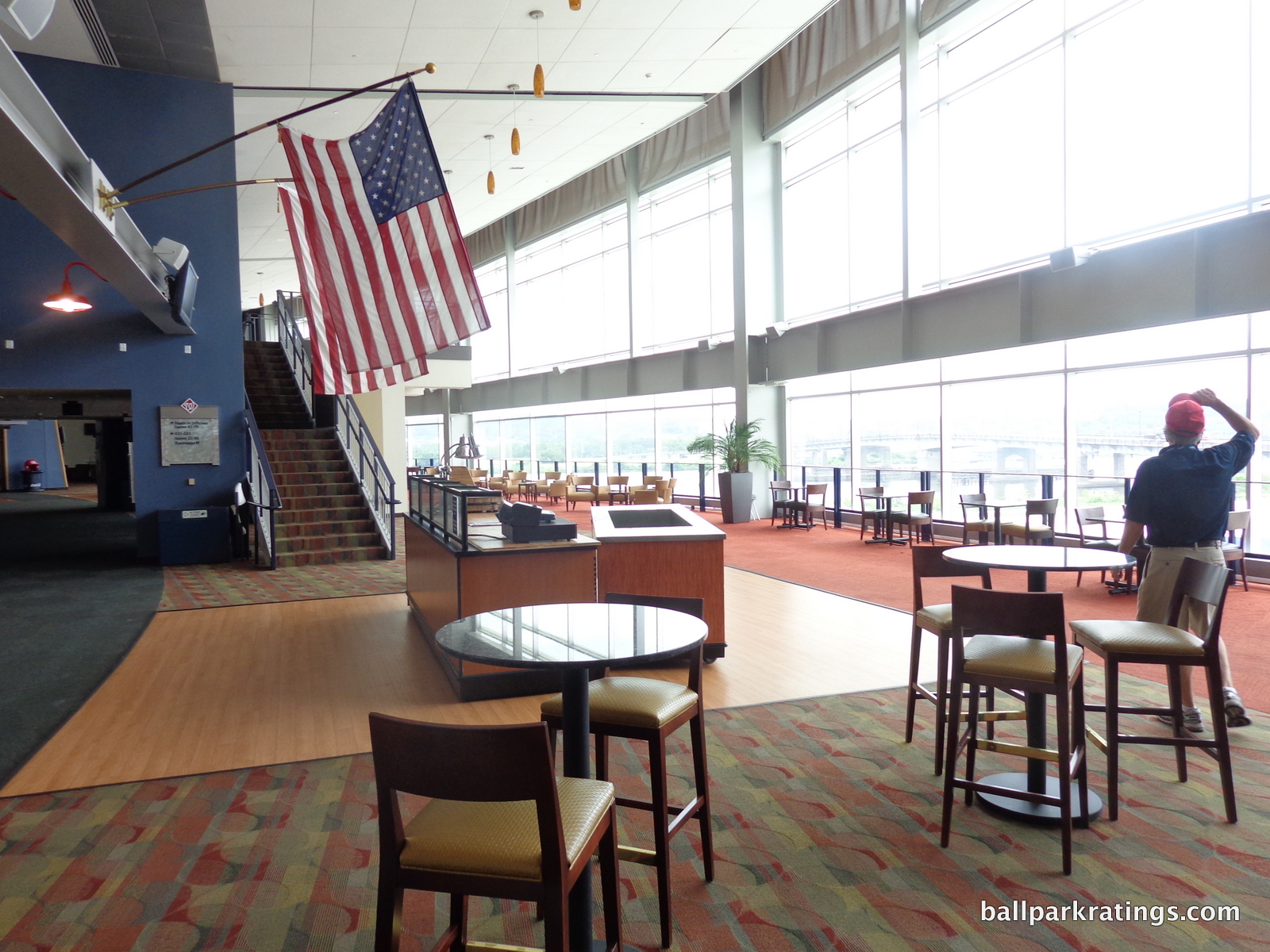
The Nationals overestimated the corporate appetite for luxury suites, so they have converted many luxury suites on the Jefferson suite level into private clubs.
The Gold Glove Club and Club 3 are very small, all-inclusive clubs on the suite level near home plate. The only difference is the former includes draft beer and house wine in the ticket price.
Further upping the ante for premium seating, the Nationals emulated arena loge boxes with their K Street Boxes and Club 24 Championship Boxes. Both are located on the suite level above first base.
Inspired by the 1924 World Series Champion Senators, the Championship Boxes combine the privacy of a suite with the flexibility of a club, sold in groups of four. The outdoor boxes come with an assigned indoor table with food, draft beer, and house wine included. Each four-person box possesses a T.V., private lockers, and electric outlets. The K Street Boxes have identical amenities, but with a Washingtonian theme in lieu of a baseball Senators décor.
The Nationals get an A+ overall here, and without the snobbery or overbearing security staff of Yankee Stadium. So, I recommend that every baseball fan try one of these experiences at least once in their lifetime. 10 years after opening, Nationals Park not only remains an industry leader, but continues to be an industry innovator.
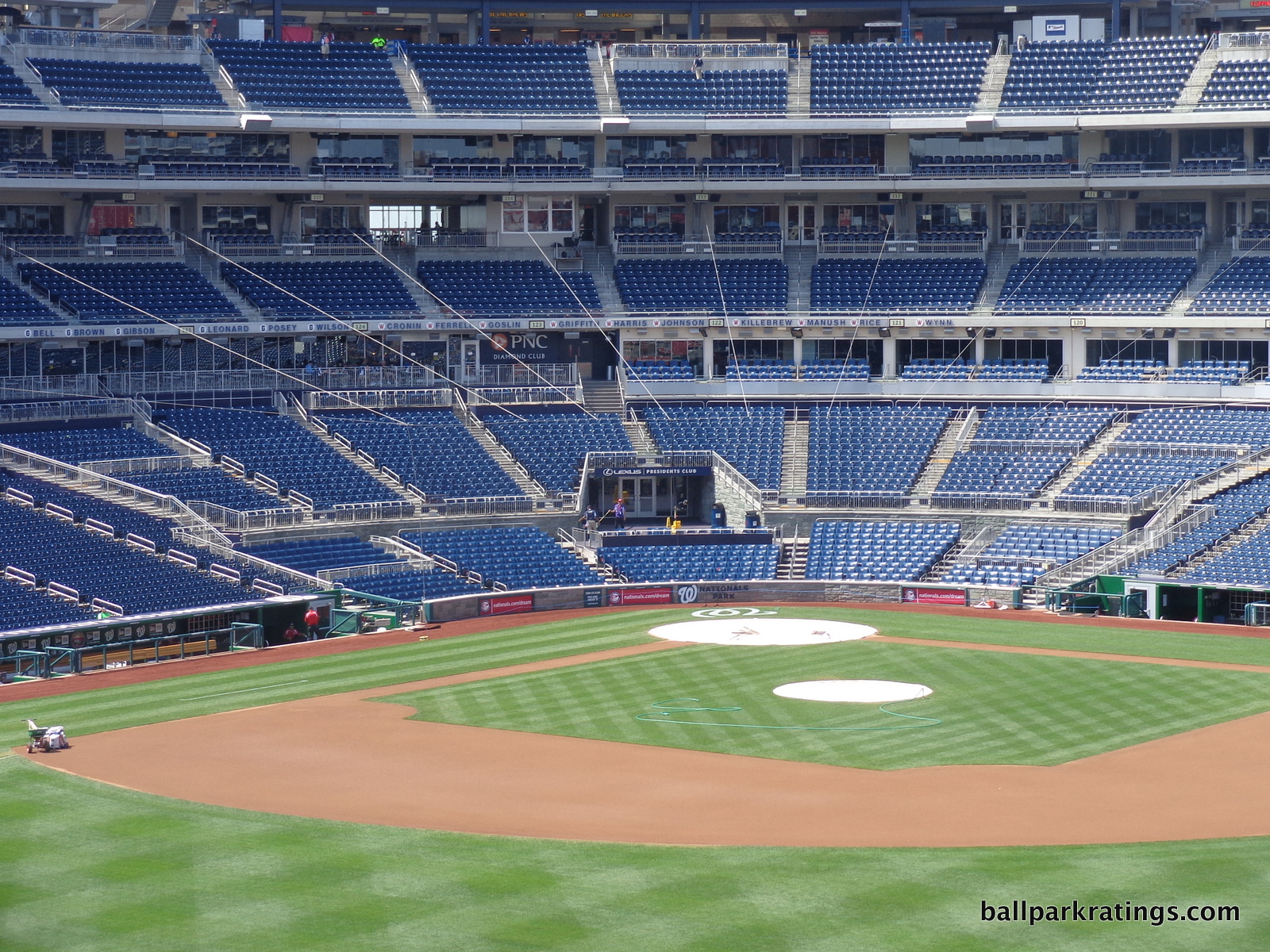
Score: 5/5
General or Artistic References to Baseball or Team History/Museums:
Integrating historical team/baseball references into the game-day experience is essential for any modern-day ballpark because of the unusually historic nature of baseball. These touches also have a tendency to make the “mallparkification” of these ballparks much more palatable.
Given the franchise’s lack of ties to the city, the Nationals did a fine job of honoring the baseball history of Washington D.C. in the ballpark.
The team had to achieve a delicate balance. On one hand, there is little point in referencing the Expos’ history that had no connection to the region, so the ballpark should obviously highlight the history from the two Washington baseball franchises. On the other hand, you don’t want to overdue the Senators’ references because, (a) the lore of those franchises also belongs to other cities now, and (b) the good parts of Senators’ history are so far removed from the average baseball fan in Washington that it just isn’t very relevant to Nationals’ baseball.
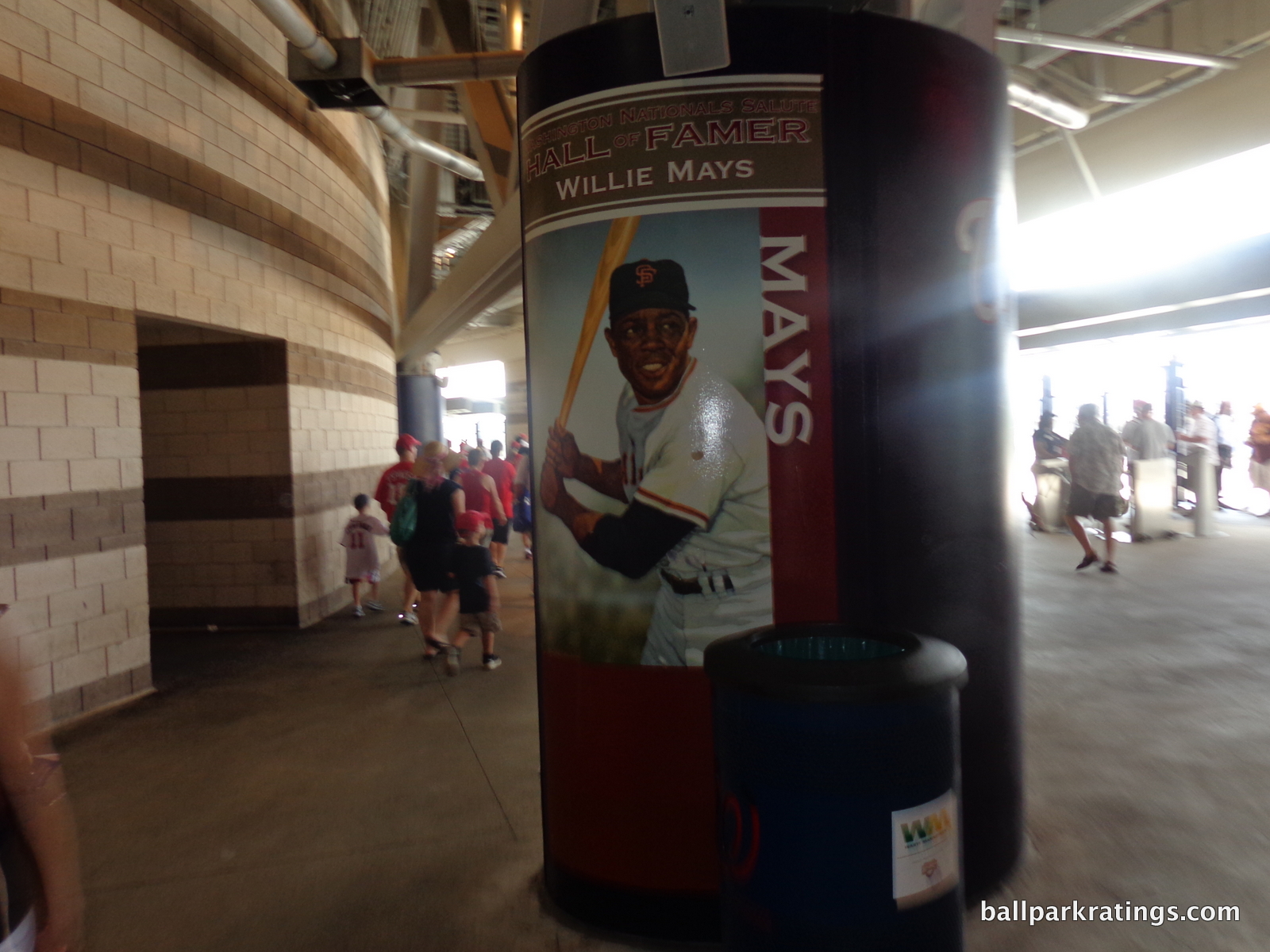
I think they struck a good balance, focusing on both general MLB history as well as integrating some historical Washington baseball references.
Fans strolling around the main concourse will notice that the concrete columns overlooking the field are adorned with copies of colorful paintings of baseball’s greatest Hall of Famers. Included are Willie Mays, Ty Cobb, Sandy Koufax, Cool Papa Bell, and of course, Walter Johnson. For some reason, I didn’t notice them on my return tour in 2018. Could the Nationals have seriously removed the paintings? I wouldn’t see a reason why they would do this, but looking at my photos, the columns appear to be blank. I hope that is not the case.
The main concourse behind home plate also has some nice posters detailing the history of baseball in Washington D.C. There is also an interesting section of memorabilia from the Library of Congress.
Due to the aforementioned congestion issues in the center field plaza, the Nationals relocated the statues of Walter Johnson, Josh Gibson, and Frank Howard from the plaza to the outside entry behind home plate. Demerits for this.
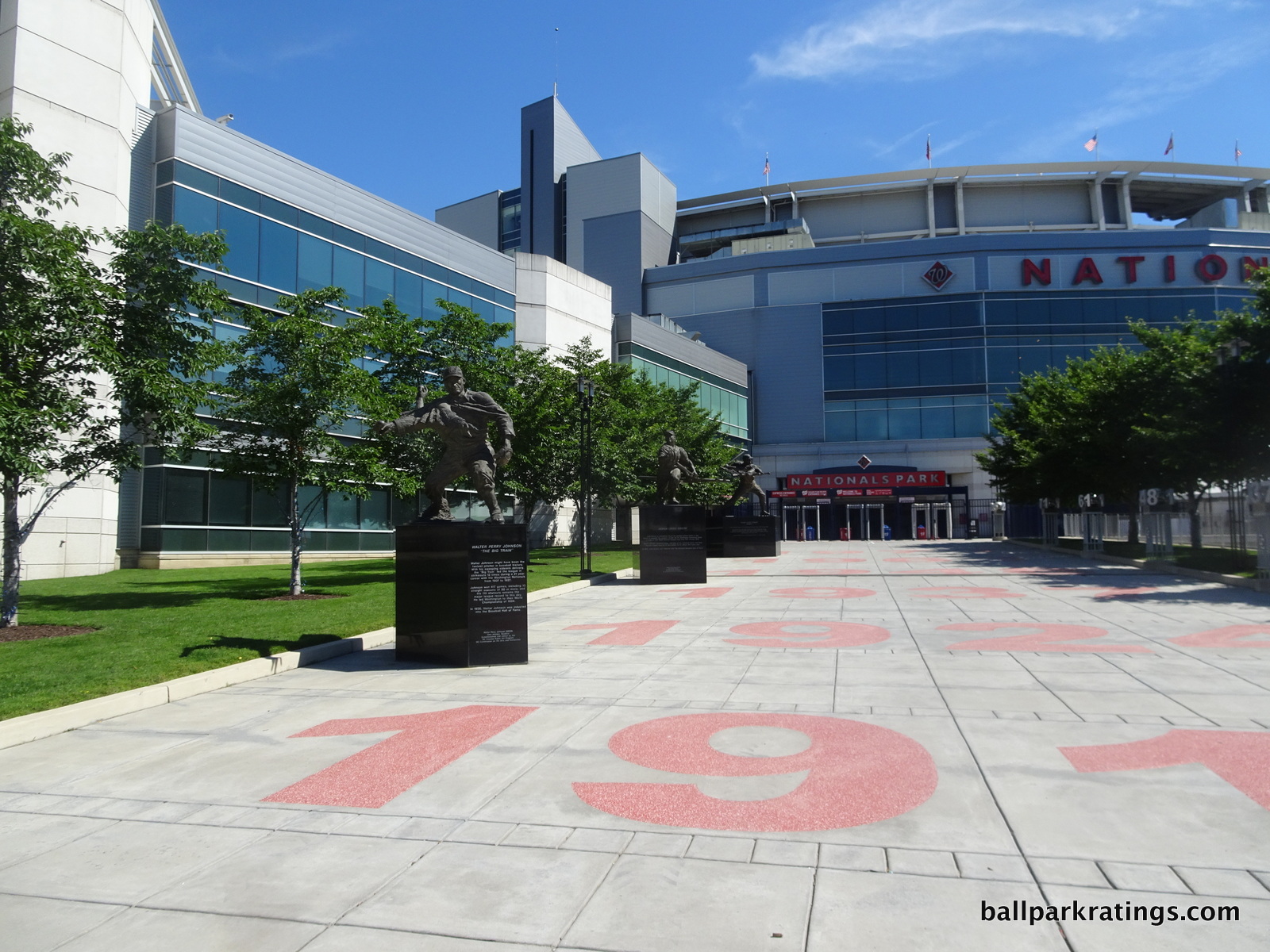
Putting the statues and references outside the park is not the issue. Plenty of parks do this well. The issue is putting them in a place outside where very few fans are going to see them. The Nationals originally estimated about 70% of fans would use the center field gates, but that has been closer to 80%. Many of the remaining fans use the 1st or 3rd base gates. Something like 10% of fans entering the ballpark are now going to see these statues, which is a shame in my book.
Some may not feel that way, though. These statues were widely ridiculed as hideous when they were unveiled. The sculptors tried to portray the statues in motion, which is naturally going to raise some eyebrows. It’s difficult to convey fluid movements in a stationary object, but I thought the statues were cool.
Monuments to important dates in the history of Washington baseball are also placed along the walkway leading up to the home plate gate.
Baseball-related art falls within the purview of this category, and Nationals Park features something interesting in that department.
Above the split right field grandstand, visible after climbing the “grand staircase” around 1st base, the Nationals cleverly placed a genuine piece of art. Comprised of four suspended mobiles with hand-painted baseball players, D.C. artist Walter Kravitz presents, The Ball Game. Regardless of its aesthetic merits, the artwork is well-positioned to give fans a strong impression, as the mobiles are placed in one of the park’s best standing-room areas where one can view the Washington Monument.
Despite my quibbles, I generally like what the Nationals did here overall.

Score: 4/5
Entertainment/Kids Activities/Other Amenities:
Nationals Park offers some nice entertainment options for the kids, although none of it is too over-the-top.
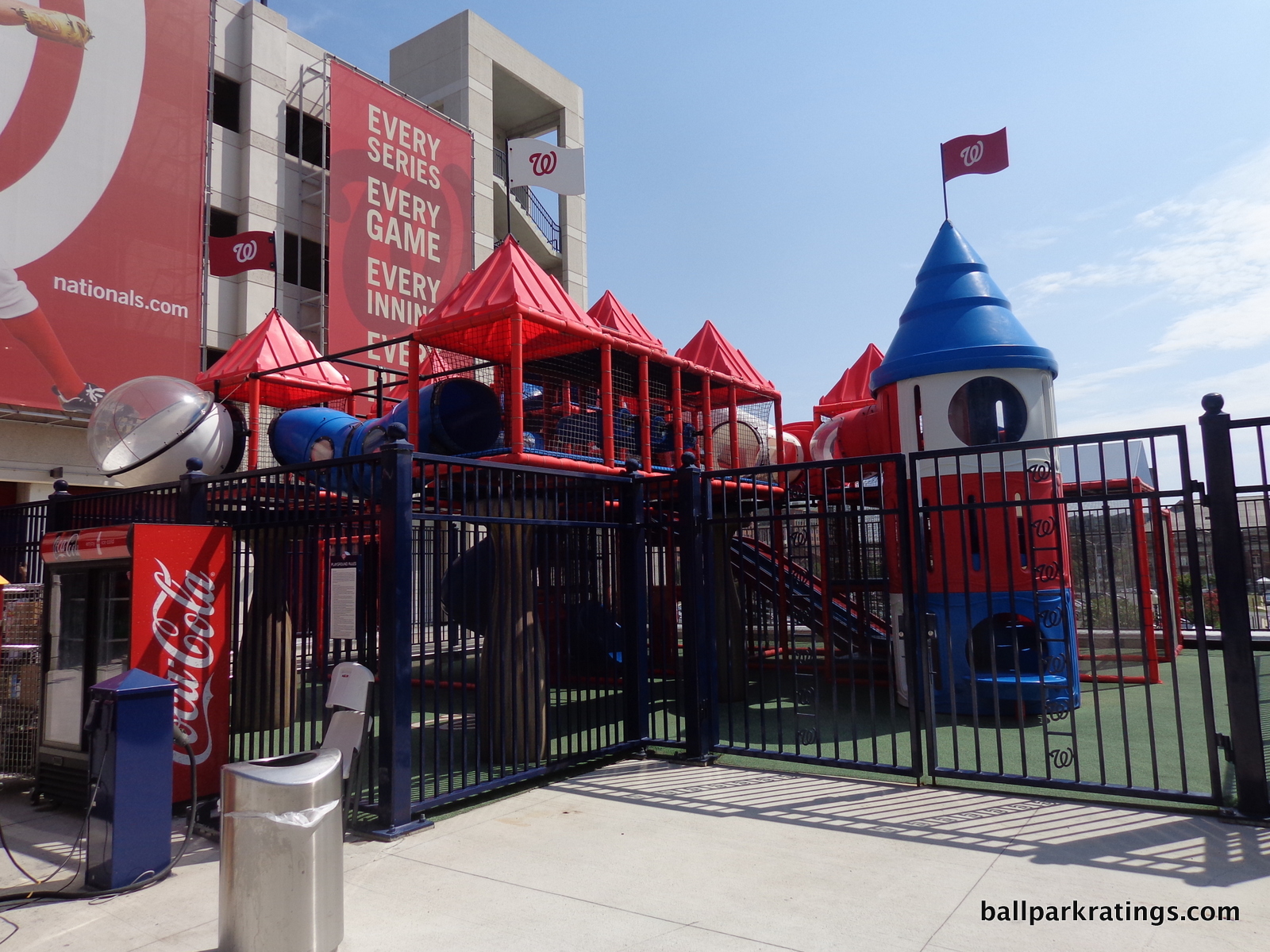
The “Family Fun Area” provides a standard playground with slides, a jungle gym, and a mini-castle. In 2018, the Nationals added an area specifically designed for the youngest Nationals fans. The Nationals also added a “Social Media Lounge.”
The Exxon Strike Zone features (or featured) a virtual reality home run derby game, two batting cages, two pitching simulations, and facts of the game. The Nationals may have eliminated this area.
Anyway, nothing at Nationals Park matches the ridiculousness of something like Atlanta’s zipline, Detroit’s baseball-themed Ferris Wheel, or Kansas City’s putt-putt golfing, but there is plenty to do if you’re a hyper kid in need of some activity.
Score: 2/3
Total: 22/25
Atmosphere, Vibe, & Policies
Atmosphere/Fan Support:
Throughout the history of Nationals Park, the Washington faithful have generally been derided as not being as loyal as their neighbors in Philadelphia and New York. In the team’s early years, fans from rival cities would infamously raid the park, to the point that the club had to have special promotions to incentivize Nationals fans to come.
For what it’s worth, this perception is backed up by attendance numbers.
Despite having one of baseball’s highest winning percentages from 2012-2018, the team has averaged between 29,269 and 32,334 fans per game during these seasons. Of all post-1990 parks, Nationals Park has the second-lowest season attendance numbers for a ballpark in its first year (2008) at 29,005. Only Marlins Park’s opening season fared worse. In fact, the Nationals’ all-time season attendance record was set in RFK Stadium in the franchises’ first year in D.C. (2005), clocking in at 33,728.
It’s hard to say why this is, but these are about as bad as attendance numbers get for a team that is a perennial contender.
Part of it probably has to do with the team’s inconsistency: the Nationals always seem to follow an outstanding season with a mediocre one, constantly tempering high expectations over and over again. I also think you can’t underestimate how demoralizing it is to be at the top of your division and lose in the Division Series four times in a row.
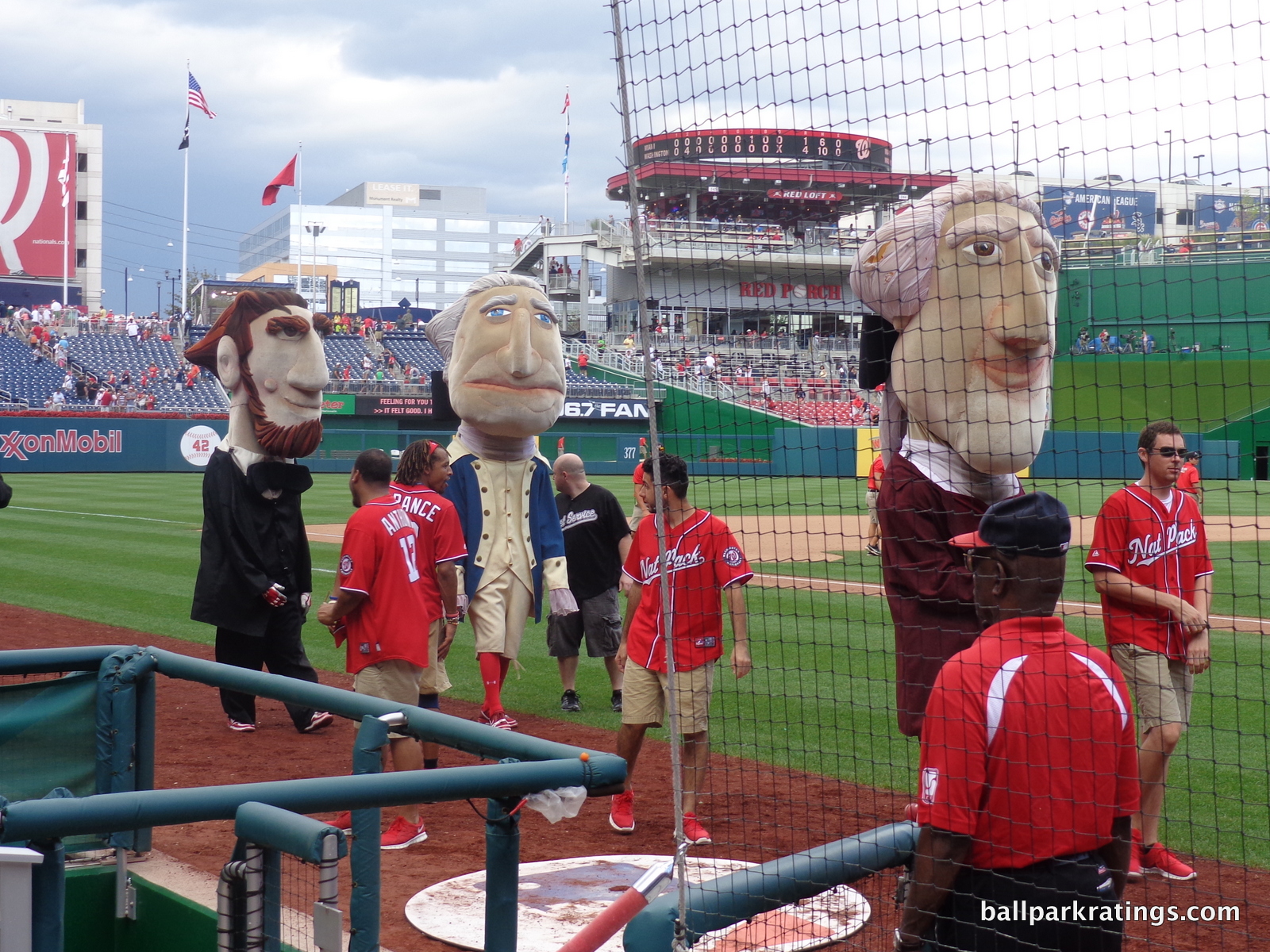
In baseball, it’s never that 98-win season that provides the attendance boost; it’s that one World Series appearance. Despite their success on paper, the Nationals have been perceived by locals as somewhat of a disappointment.
A couple of traditions unique to Nationals Park deserve mention here, starting with the Presidents Race! Many teams have copied the Brewers’ famous Sausage Race, but this is the only one that has become a true staple for the team.
Held in the middle of the fourth inning, the race features the likeness of four former presidents in giant foam caricature heads. George Washington, Abraham Lincoln, Thomas Jefferson, and Teddy Roosevelt have always been included, and Taft, Coolidge, and Hoover have participated in the past.
The race is notable for Teddy’s inability to win a race, often due to some unforeseen and hilarious misfortune. He finally won on the last regular season game of the 2012 season. He placed respectably from 2013-2016, before returning to losing in 2017.
One more nice local touch: in order to tie the park to its Navy Yard location, a foghorn blasts every time the Nationals hit a home run.
Score: 3.5/5
Ballpark Policies/Customer Service:
Like the vast majority of teams, the Nationals do fine in this category.
Grading the customer service is too anecdotal, so this category has become binary, with most teams getting a 2/2, while teams like the Giants, Yankees, and White Sox that don’t allow all ticketed fans around the infield hours before the game get lower.
I’ll again note that the ushers and staff seemed friendlier and more accommodating in the premium sections compared to those in similar big markets/new ballparks like New York and Atlanta.
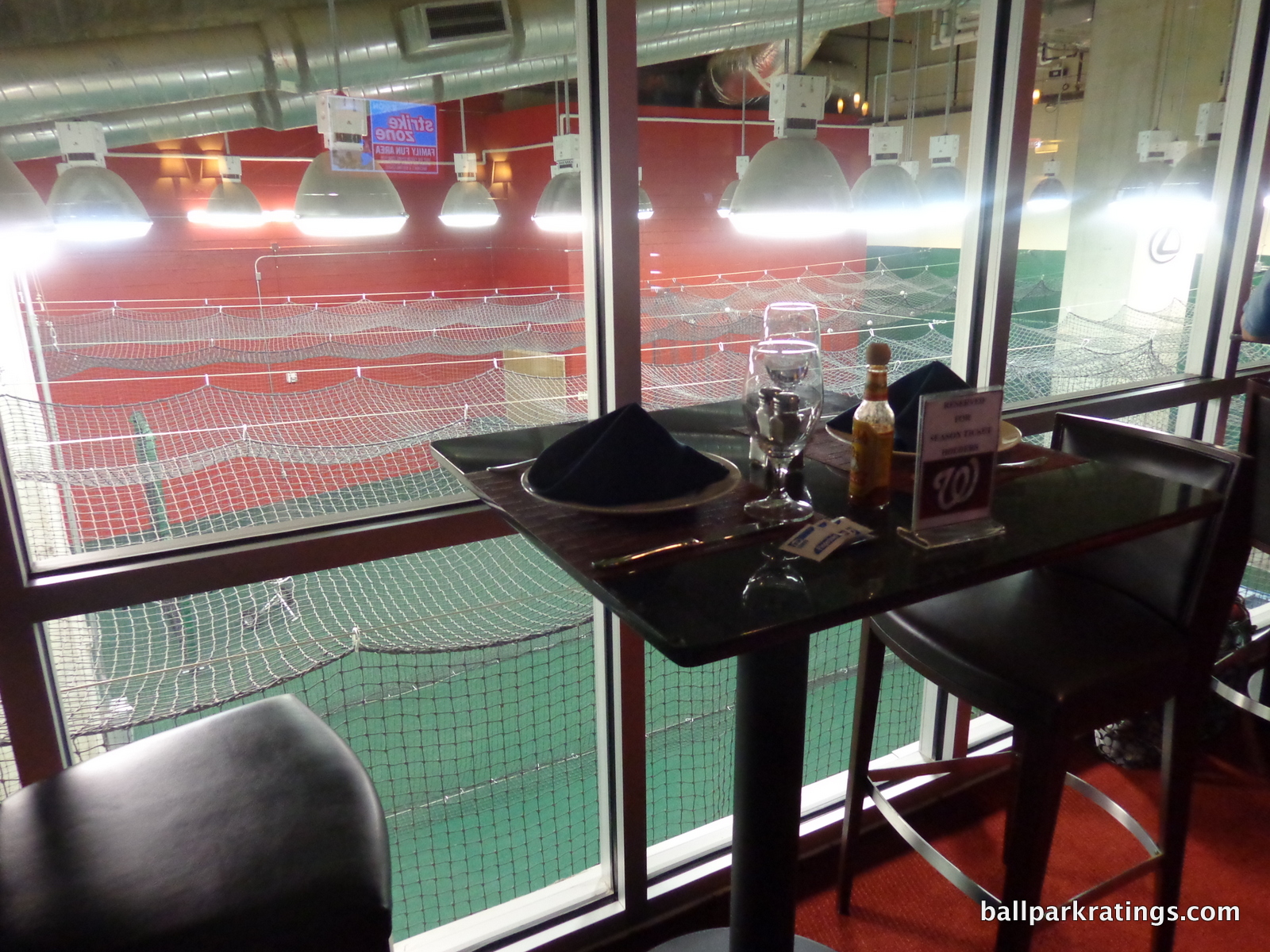
Score: 2/2
Bonus:
For the redevelopment projects in the Navy Yard by the ballpark +1
For the Scoreboard Walk concession, bar, and social area, the prototypical social space +1
For arguably having some of the highest quality premium seating in baseball +1
For the centerfield entry plaza and making openness a central theme, with one of the best concourse systems +1
For the partial integration of national monuments into the ballpark +1
For the President’s Race! The only copycat of Milwaukee’s Sausage Race that worked and became a truly beloved ballpark tradition. +1
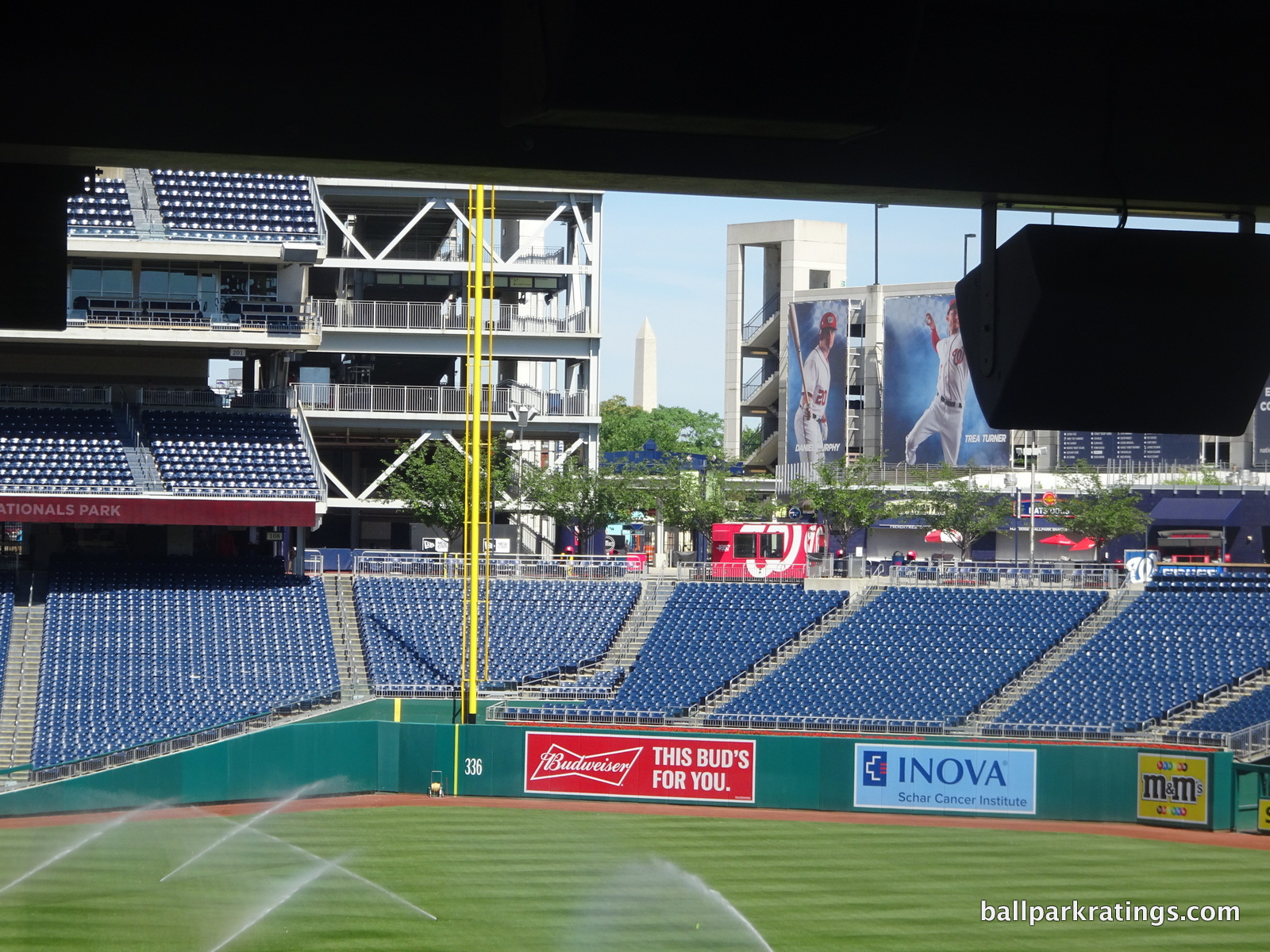
Score: 6
Total: 11.5
Conclusion
In the face of criticism from ballpark enthusiasts and Washingtonians alike, I think Nationals Park is a success story. No, it doesn’t cross into “national landmark” territory, but that’s okay. Once put in the context of all new parks from 1991-2017, discarding the unreasonable expectations of 2008, Nationals Park looks way better than it did a decade ago. Coupled with the phenomenal development in the Navy Yard, Washington has a ballpark that is now generally respected around Major League Baseball.
I have been googling “ballpark rankings” pretty much my entire life, and I found a take that perfectly describes the consensus view of Nationals Park. Placing it 16th in baseball, NBC Sports Washington writes,
“Nationals Park, to its credit, is a very fan-friendly ballpark, with wide concourses and good field views from just about any seat. But it simply has no defining characteristic, no distinct charm. Think about it this way: What’s the first thing you think of when you think of Nationals Park? It’s tough to come up with something. The big video board? The Red Porch area? The cherry blossoms that bloom for only a week or so in early-April? The distant view of the Capitol dome from a handful of sections in the upper deck? I just wish there was something that stood about this place. A quirk in the outfield fence. A view of the Anacostia River. A view of more of the city. A unique bullpen. Something. Anything. Instead, we’re left with a very nice — but wholly indistinguishable — ballpark in the nation’s capital.”
I think that is somewhat accurate, but Nationals Park deserves more credit than that.
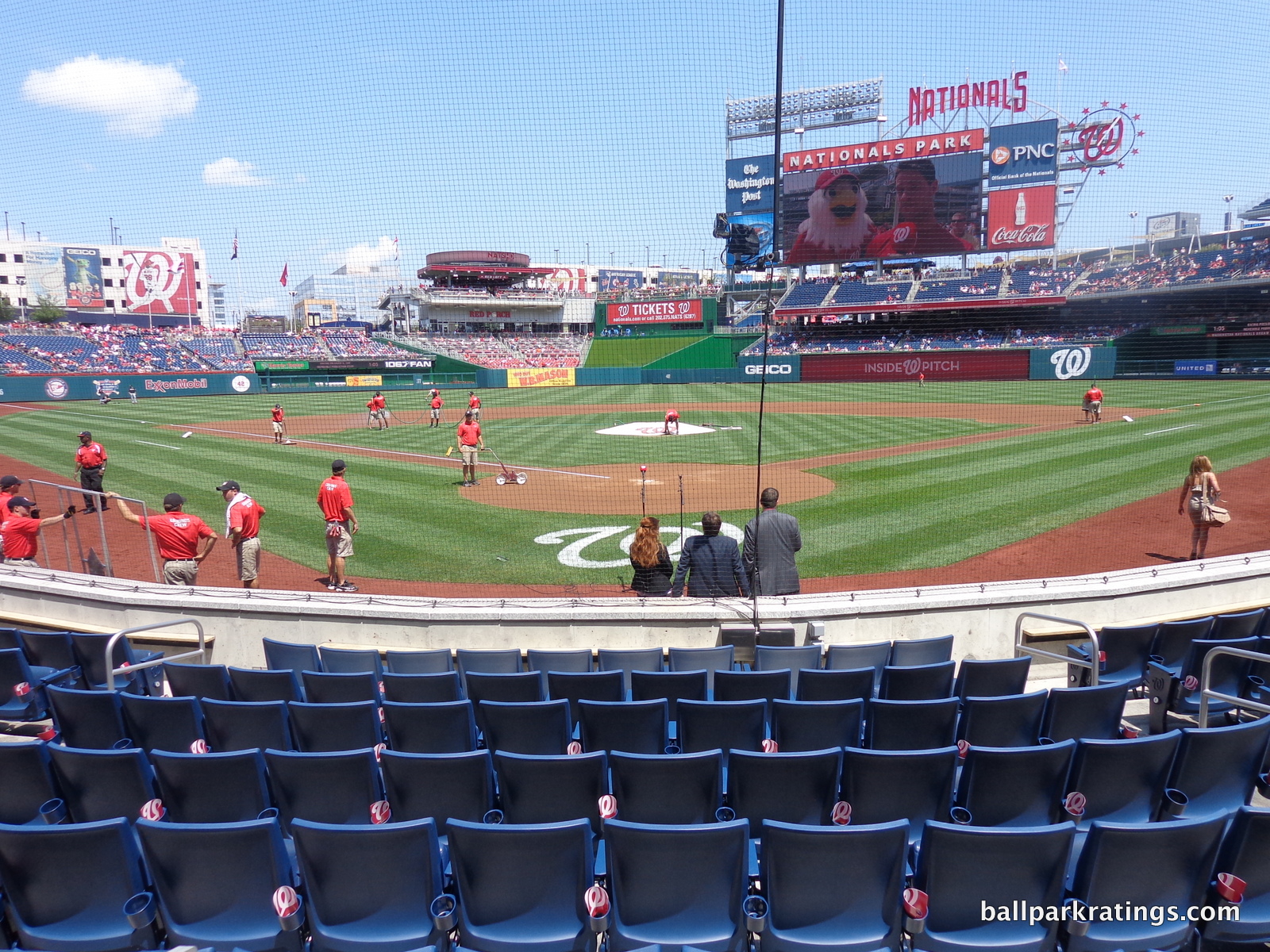
First of all, ballparks don’t need distinguishing features to be great. They don’t necessarily need to “stand out.” The last thing I would want is some synthetically quirky gimmick to artificially distinguish a park. Would Nationals Park be better with that cheesy home run ball on top of the restaurant or some other kitschy contrivance? Or just any forced distinction for distinction’s sake? Of course, not.
Great ballparks need to represent their regions, and that is where a ballpark’s distinction should come from. I know people may disagree, but Nationals Park actually does that pretty well in this respect. Yes, the landmark views are underwhelming, but the ballpark features great views of the Navy Yard development and possesses unique local staples like Ben’s Chili Bowl, the Presidents Race, and plenty of nods to Washington baseball history.
Regardless, a ballpark that is above-average in almost every quantifiable metric is going to score well in my book, unless the aesthetics are an unmitigated disaster. And I don’t think anyone would go that far. To answer the question, I think of well-roundedness when I think of Nationals Park.
In sum, the Nationals didn’t build an all-time great ballpark, but Washington should be proud of their home.
FINAL SCORE: 85
RANKING: #12/27*
*Classic parks Wrigley Field, Fenway Park, and Dodger Stadium are not ranked or rated for reasons previously outlined in those reviews
Summary
TL;DR? Here’s the long-form piece in a nutshell:
In the face of high expectations to deliver an iconic ballpark fitting for America’s pastime in the nation’s capital, Nationals Park has received mixed reviews for its lack of distinguishing features, not to mention its lack of visuals that reflect Washington D.C..
Critics say, what’s the first thing you think of when you think of Nationals Park? True, that’s tough! The red seats in center field? The distant view of D.C. landmarks, which are increasingly obstructed by development? The left field cherry blossoms planted as an afterthought that only bloom for a week in early April?
Regardless, I still view Nationals Park more positively. It may lack much to separate it from the pack of other MLB venues, but Nationals Park is very well rounded, with only a couple of significant flaws, and that matters.
Nationals Park’s architecture may be a mixed bag, but it fits into the D.C. landscape, which is the goal. Its interior may lack distinctiveness, but I love how open the park feels to the urban context on the left side, with new development and rooftops overlooking the field. It excels functionally, with solid sightlines, good seats, and wide, navigable, and open concourses. It’s equipped with plenty of fan-friendly amenities, namely a criminally underrated culinary scene, vibrant social spaces, and amazing premium club seats that have always been relatively affordable on Stubhub. It even possesses a few charming local traditions, namely the now iconic President’s Race and nods to D.C. baseball history.
Most importantly, the burgeoning Navy Yard next door is now one of baseball’s best local scenes, and location is crucial in my ballpark ratings.
Yes, a ballpark is more than the sum of its parts—Nationals Park lacks that “wow factor” that limits its “repeat value” for out-of-towners—but the sum of its parts is really damn good here. It all adds up to something better than its reputation as a middling to bottom-10 ballpark in my book, even if nothing is particularly memorable or outstanding.